Improving Hand Hygiene Education and Training in Nursing Homes Case Study 2022
VerifiedAdded on 2022/09/26
|48
|14043
|39
AI Summary
Contribute Materials
Your contribution can guide someone’s learning journey. Share your
documents today.
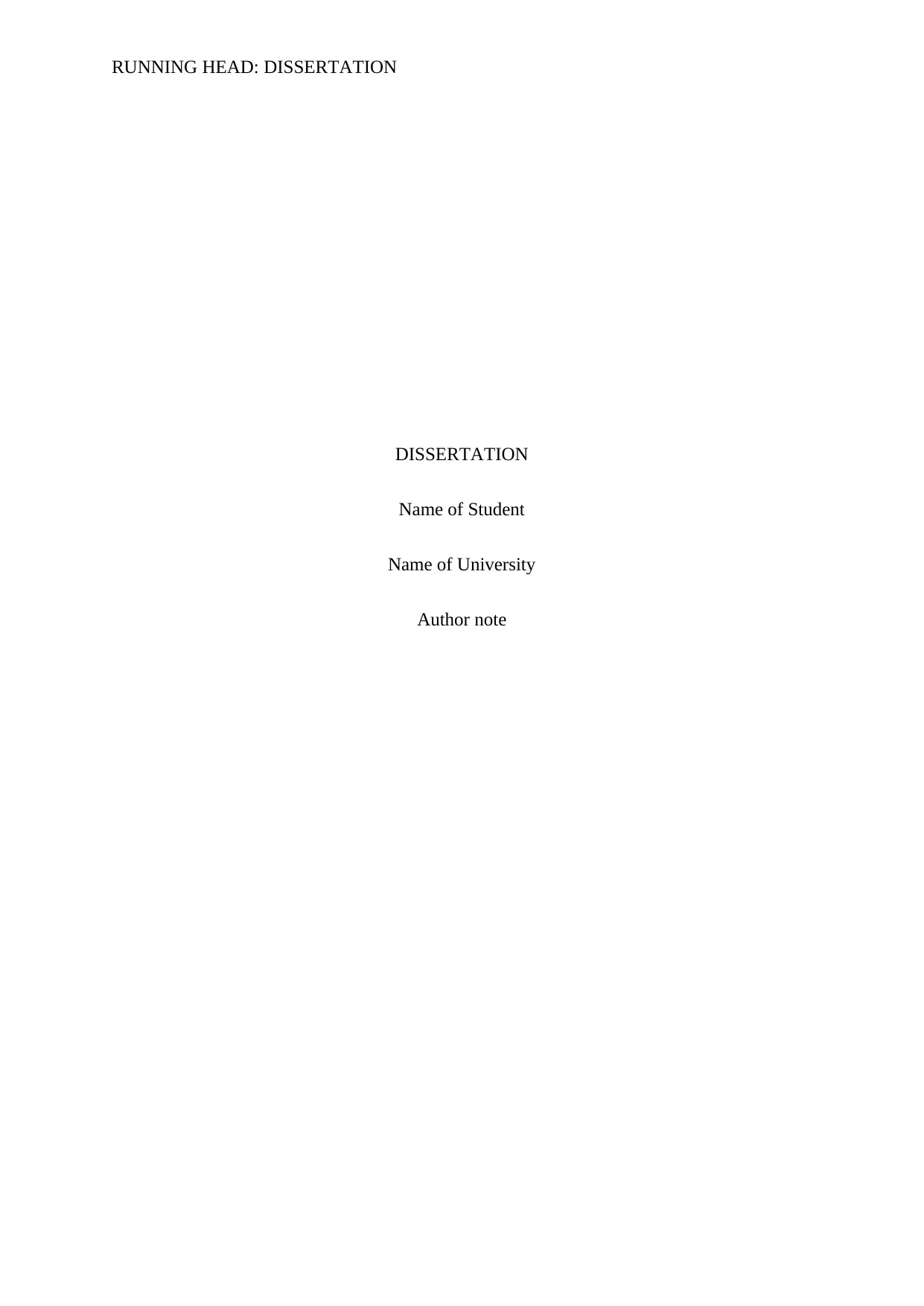
RUNNING HEAD: DISSERTATION
DISSERTATION
Name of Student
Name of University
Author note
DISSERTATION
Name of Student
Name of University
Author note
Secure Best Marks with AI Grader
Need help grading? Try our AI Grader for instant feedback on your assignments.

1DISSERTATION
Title - Improving hand hygiene education and training in nursing homes
Title - Improving hand hygiene education and training in nursing homes
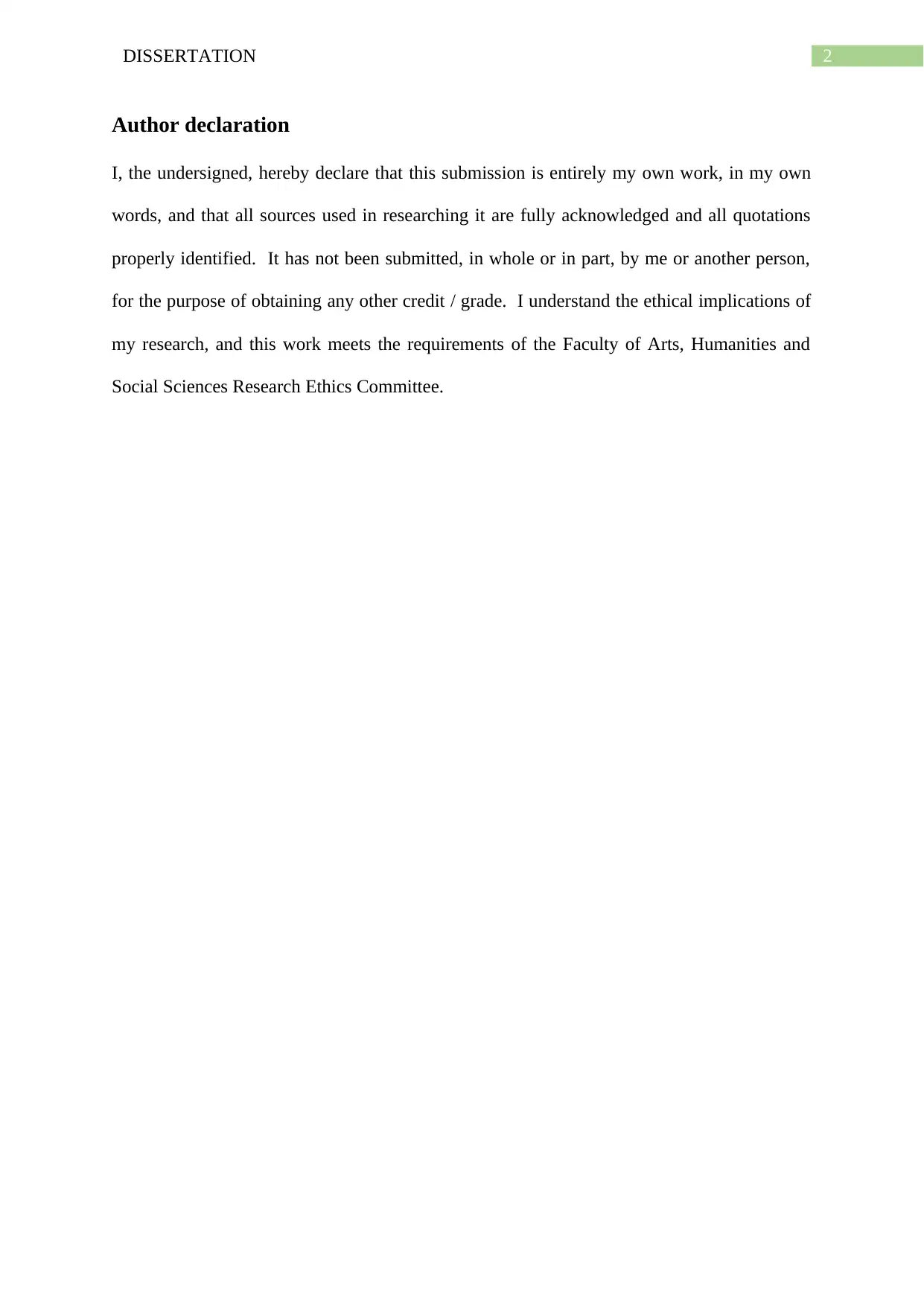
2DISSERTATION
Author declaration
I, the undersigned, hereby declare that this submission is entirely my own work, in my own
words, and that all sources used in researching it are fully acknowledged and all quotations
properly identified. It has not been submitted, in whole or in part, by me or another person,
for the purpose of obtaining any other credit / grade. I understand the ethical implications of
my research, and this work meets the requirements of the Faculty of Arts, Humanities and
Social Sciences Research Ethics Committee.
Author declaration
I, the undersigned, hereby declare that this submission is entirely my own work, in my own
words, and that all sources used in researching it are fully acknowledged and all quotations
properly identified. It has not been submitted, in whole or in part, by me or another person,
for the purpose of obtaining any other credit / grade. I understand the ethical implications of
my research, and this work meets the requirements of the Faculty of Arts, Humanities and
Social Sciences Research Ethics Committee.

3DISSERTATION
Table of Contents
Abstract......................................................................................................................................6
Introduction................................................................................................................................7
Background..............................................................................................................................18
The Improvement.....................................................................................................................25
Literature review......................................................................................................................25
METHODOLOGY...................................................................................................................29
Search strategy.........................................................................................................................29
Inclusion criteria...................................................................................................................29
Exclusion criteria.....................................................................................................................30
DATA COLLECTION METHOD......................................................................................30
DATA ANALYSIS METHOD............................................................................................30
ETHICAL ISSUES..................................................................................................................30
Data analysis and findings.......................................................................................................34
Dissemination...........................................................................................................................38
Conclusion................................................................................................................................38
References................................................................................................................................39
Table of Contents
Abstract......................................................................................................................................6
Introduction................................................................................................................................7
Background..............................................................................................................................18
The Improvement.....................................................................................................................25
Literature review......................................................................................................................25
METHODOLOGY...................................................................................................................29
Search strategy.........................................................................................................................29
Inclusion criteria...................................................................................................................29
Exclusion criteria.....................................................................................................................30
DATA COLLECTION METHOD......................................................................................30
DATA ANALYSIS METHOD............................................................................................30
ETHICAL ISSUES..................................................................................................................30
Data analysis and findings.......................................................................................................34
Dissemination...........................................................................................................................38
Conclusion................................................................................................................................38
References................................................................................................................................39
Secure Best Marks with AI Grader
Need help grading? Try our AI Grader for instant feedback on your assignments.
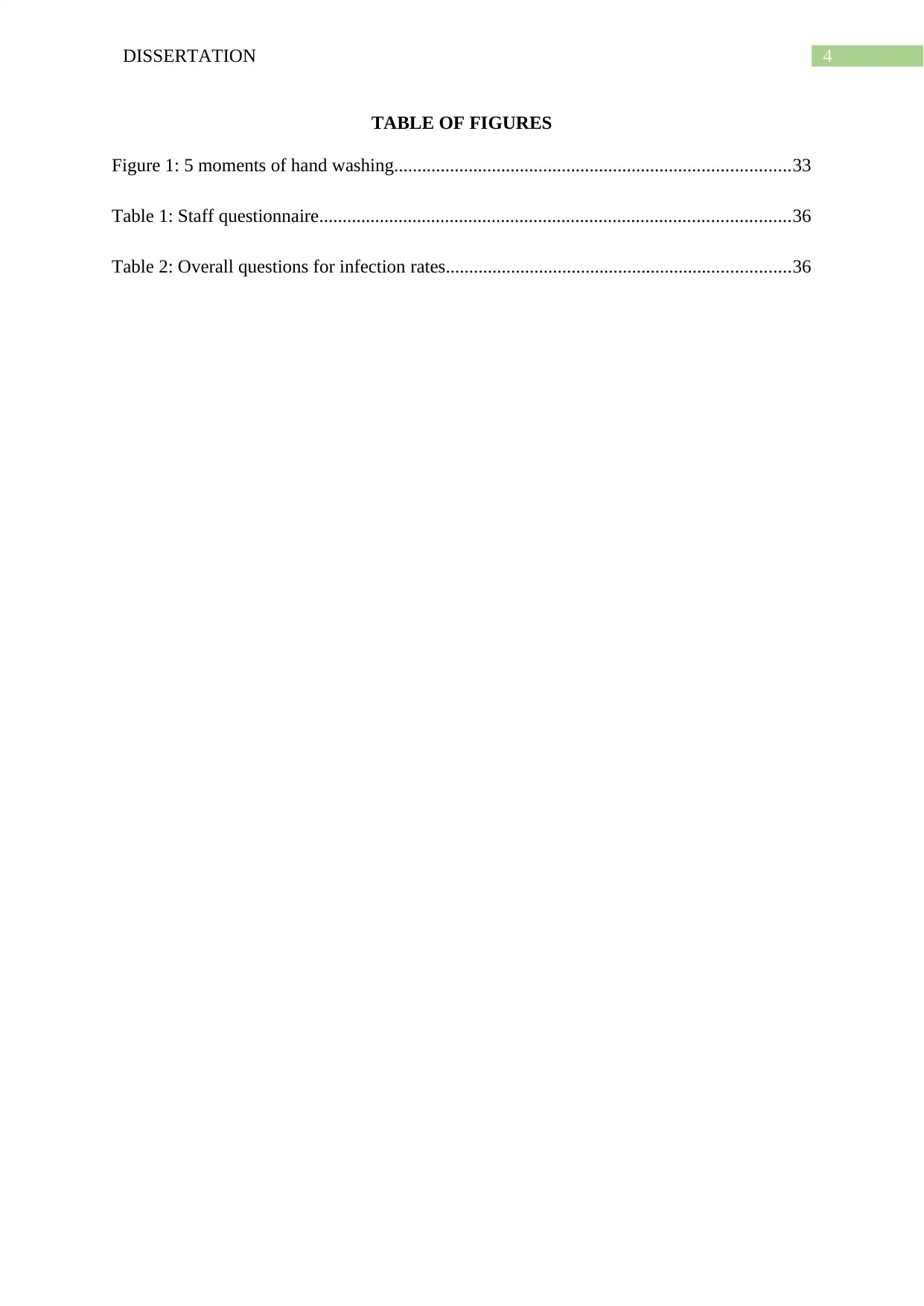
4DISSERTATION
TABLE OF FIGURES
Figure 1: 5 moments of hand washing.....................................................................................33
Table 1: Staff questionnaire.....................................................................................................36
Table 2: Overall questions for infection rates..........................................................................36
TABLE OF FIGURES
Figure 1: 5 moments of hand washing.....................................................................................33
Table 1: Staff questionnaire.....................................................................................................36
Table 2: Overall questions for infection rates..........................................................................36
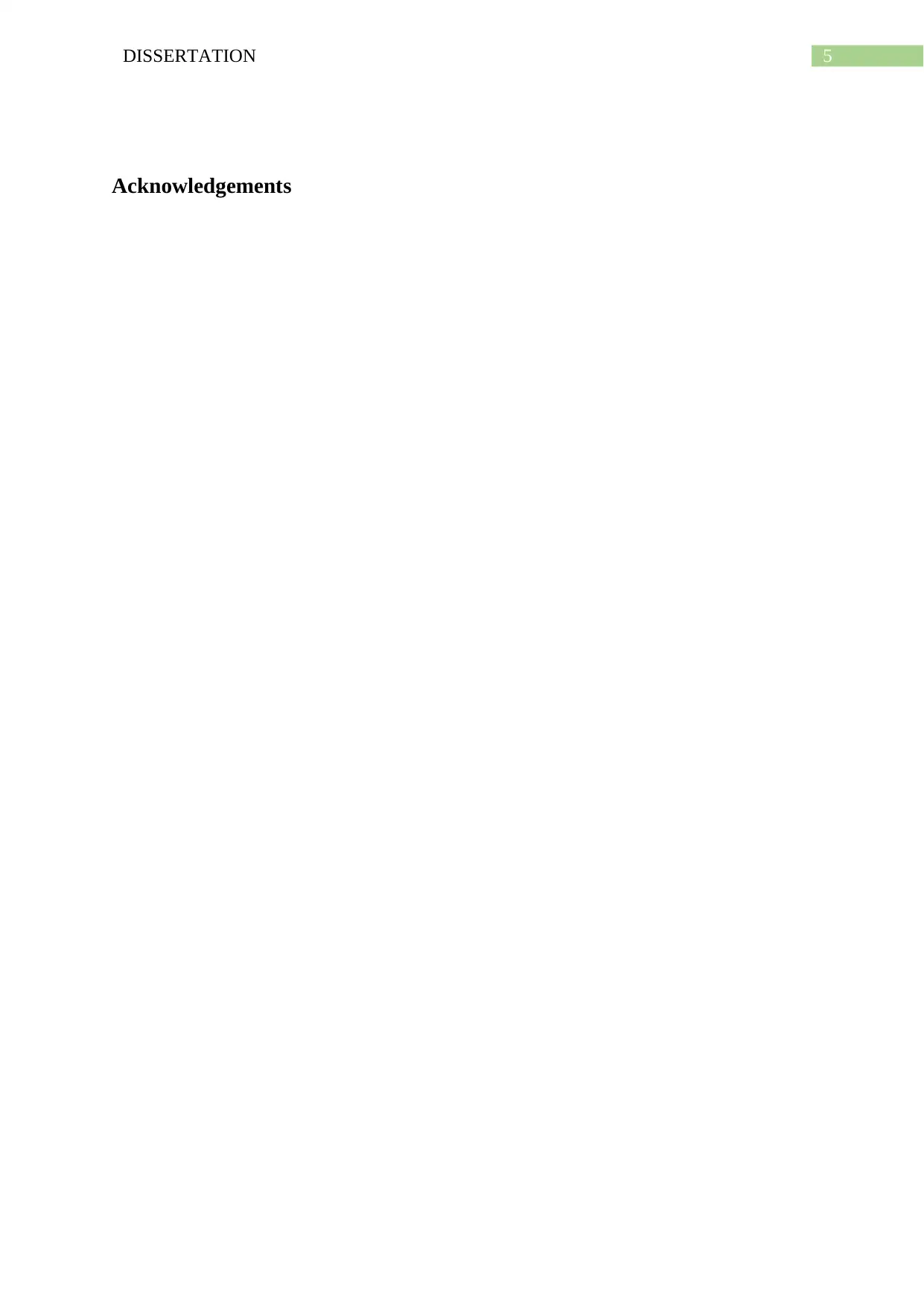
5DISSERTATION
Acknowledgements
Acknowledgements
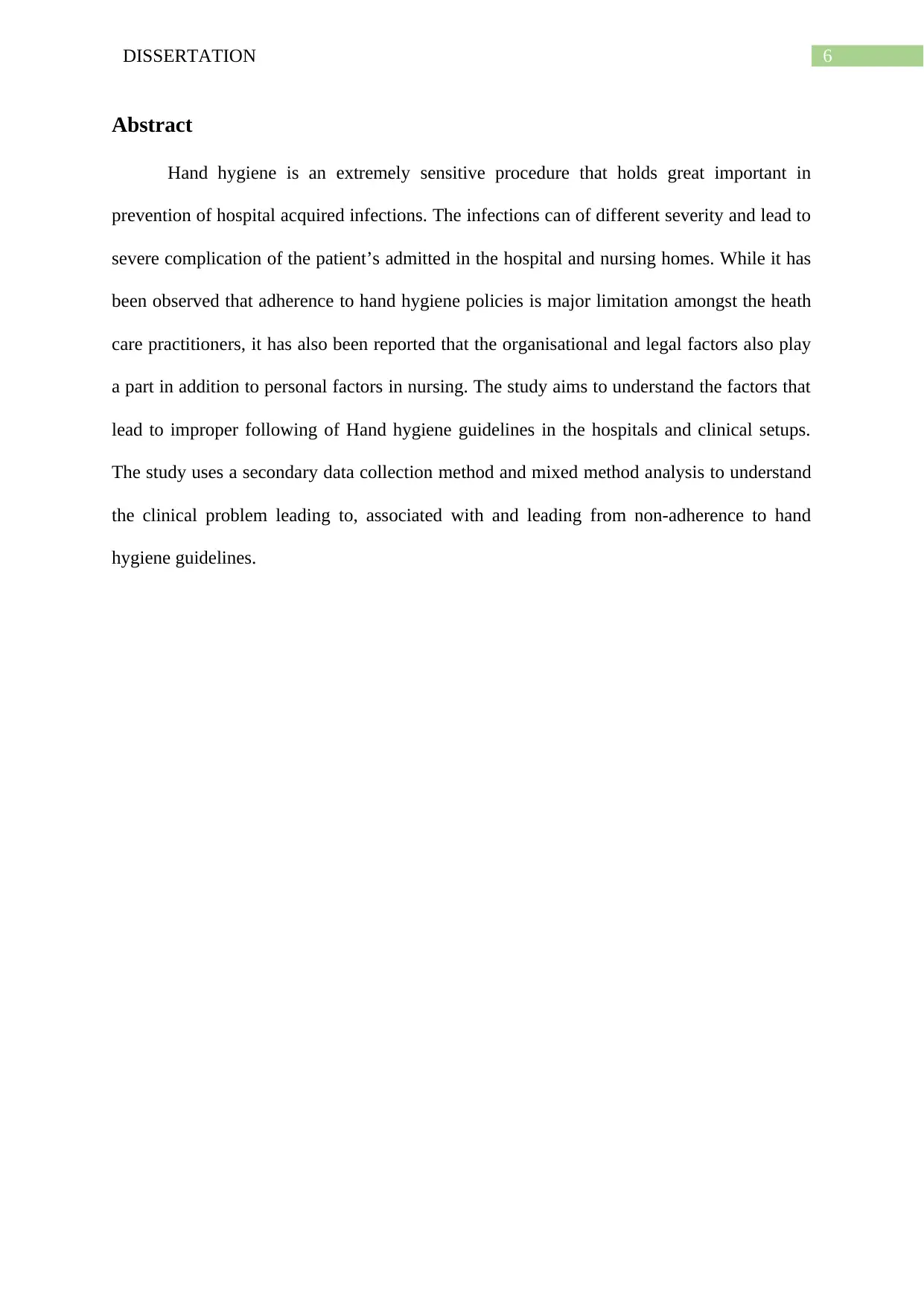
6DISSERTATION
Abstract
Hand hygiene is an extremely sensitive procedure that holds great important in
prevention of hospital acquired infections. The infections can of different severity and lead to
severe complication of the patient’s admitted in the hospital and nursing homes. While it has
been observed that adherence to hand hygiene policies is major limitation amongst the heath
care practitioners, it has also been reported that the organisational and legal factors also play
a part in addition to personal factors in nursing. The study aims to understand the factors that
lead to improper following of Hand hygiene guidelines in the hospitals and clinical setups.
The study uses a secondary data collection method and mixed method analysis to understand
the clinical problem leading to, associated with and leading from non-adherence to hand
hygiene guidelines.
Abstract
Hand hygiene is an extremely sensitive procedure that holds great important in
prevention of hospital acquired infections. The infections can of different severity and lead to
severe complication of the patient’s admitted in the hospital and nursing homes. While it has
been observed that adherence to hand hygiene policies is major limitation amongst the heath
care practitioners, it has also been reported that the organisational and legal factors also play
a part in addition to personal factors in nursing. The study aims to understand the factors that
lead to improper following of Hand hygiene guidelines in the hospitals and clinical setups.
The study uses a secondary data collection method and mixed method analysis to understand
the clinical problem leading to, associated with and leading from non-adherence to hand
hygiene guidelines.
Paraphrase This Document
Need a fresh take? Get an instant paraphrase of this document with our AI Paraphraser

7DISSERTATION
Introduction
Hospital acquired infections are increasingly gaining attention in the health research
field in the recent years (Sarotra et al. 2016). The morbidity and mortality ratio has greatly
increased many folds in the recent years due to hospital acquired infections and lack of hand
hygiene (Cornejo-Juárez et al. 2015). The social factors as well as the psychological factors
play a very huge role in non-adherence of hand hygiene protocols amongst the nursing
professionals and it has hindered the clinical excellence in the healthcare industry by a very
big margin, in many countries. The chances of cross-transmission risks has increased by
many fold, owing the work culture in the hospitals and nursing homes (Boutin et al. 2014).
The "Spotless Care is Safer Care" as the prime plan in World Health Organization stretched
out its global support to hand hygiene adherence and has funded many projects across the
globe (Smith 2014). Simplest methods of hand hygiene are encouraged amongst the nursing
professionals and care must be taken to help the new graduate nurses with the same (Huang,
Stewardson and Grayson 2014).
The simplest of methods in hand hygiene practice is washing of hands with cleanser
and water when (1) there is a contact with blood, proteinaceous materials during a surgical
procedure. 2) When there is a possible chance of Bacillus Anthracis exposure or other
microbes that are strongly transmissible. 3) There is an increased contact time with some
patient during dressing or other wound care techniques. It is being increasingly stressed in
the medical literature to clean the hands after every patient contact and this habit should start
from the very first day of nursing career.
Hand hygiene techniques involves cleaning the hands with alcohol based rubs,
microbial or non-microbial soaps. Hand hygiene protocols must be practiced (1) Before
having direct contact with the patient (2) Before wearing of gloves intended for changing
catheter (3) before applying the indwelling catheter (4) after lifting up the patient (5) After
Introduction
Hospital acquired infections are increasingly gaining attention in the health research
field in the recent years (Sarotra et al. 2016). The morbidity and mortality ratio has greatly
increased many folds in the recent years due to hospital acquired infections and lack of hand
hygiene (Cornejo-Juárez et al. 2015). The social factors as well as the psychological factors
play a very huge role in non-adherence of hand hygiene protocols amongst the nursing
professionals and it has hindered the clinical excellence in the healthcare industry by a very
big margin, in many countries. The chances of cross-transmission risks has increased by
many fold, owing the work culture in the hospitals and nursing homes (Boutin et al. 2014).
The "Spotless Care is Safer Care" as the prime plan in World Health Organization stretched
out its global support to hand hygiene adherence and has funded many projects across the
globe (Smith 2014). Simplest methods of hand hygiene are encouraged amongst the nursing
professionals and care must be taken to help the new graduate nurses with the same (Huang,
Stewardson and Grayson 2014).
The simplest of methods in hand hygiene practice is washing of hands with cleanser
and water when (1) there is a contact with blood, proteinaceous materials during a surgical
procedure. 2) When there is a possible chance of Bacillus Anthracis exposure or other
microbes that are strongly transmissible. 3) There is an increased contact time with some
patient during dressing or other wound care techniques. It is being increasingly stressed in
the medical literature to clean the hands after every patient contact and this habit should start
from the very first day of nursing career.
Hand hygiene techniques involves cleaning the hands with alcohol based rubs,
microbial or non-microbial soaps. Hand hygiene protocols must be practiced (1) Before
having direct contact with the patient (2) Before wearing of gloves intended for changing
catheter (3) before applying the indwelling catheter (4) after lifting up the patient (5) After
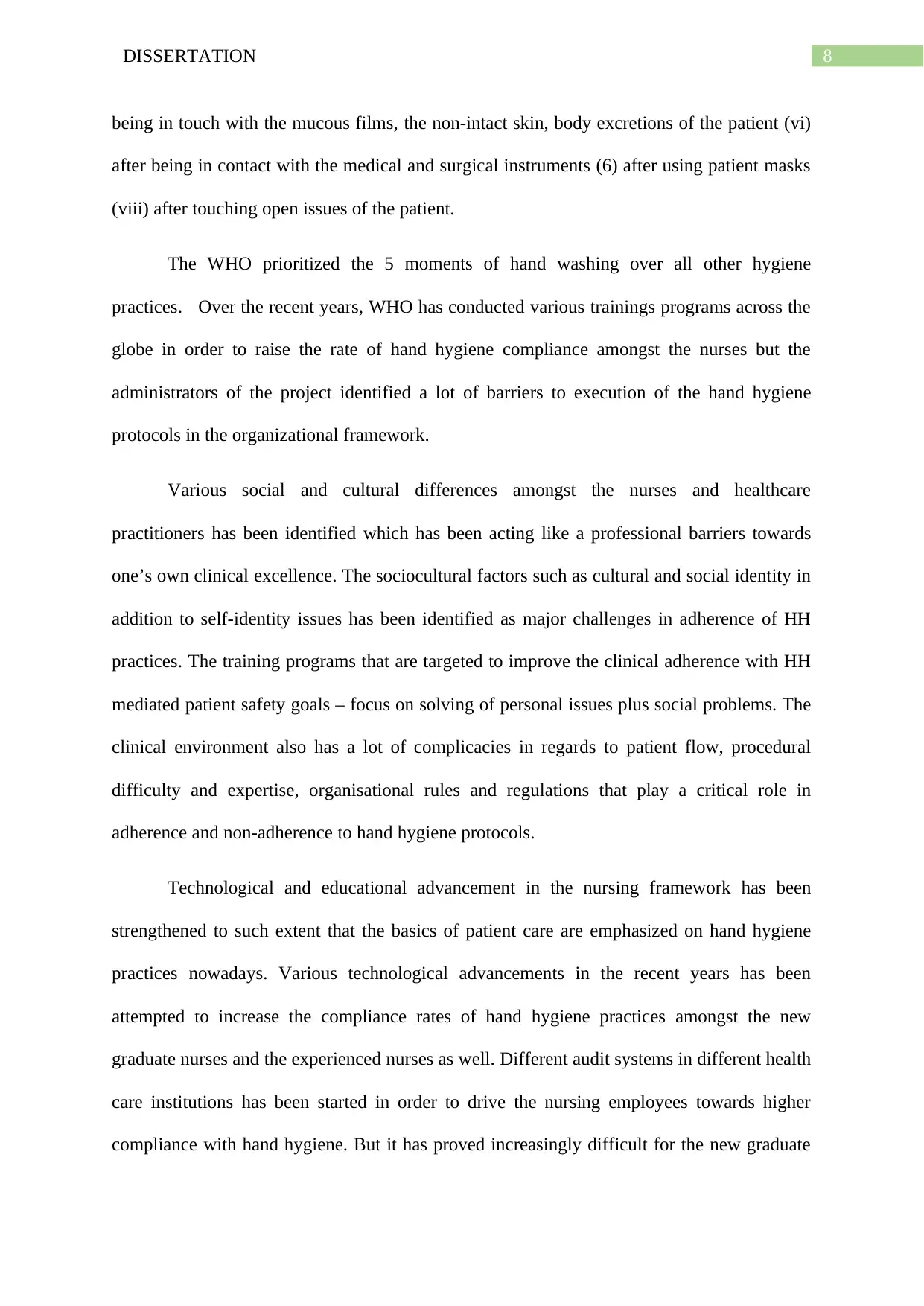
8DISSERTATION
being in touch with the mucous films, the non-intact skin, body excretions of the patient (vi)
after being in contact with the medical and surgical instruments (6) after using patient masks
(viii) after touching open issues of the patient.
The WHO prioritized the 5 moments of hand washing over all other hygiene
practices. Over the recent years, WHO has conducted various trainings programs across the
globe in order to raise the rate of hand hygiene compliance amongst the nurses but the
administrators of the project identified a lot of barriers to execution of the hand hygiene
protocols in the organizational framework.
Various social and cultural differences amongst the nurses and healthcare
practitioners has been identified which has been acting like a professional barriers towards
one’s own clinical excellence. The sociocultural factors such as cultural and social identity in
addition to self-identity issues has been identified as major challenges in adherence of HH
practices. The training programs that are targeted to improve the clinical adherence with HH
mediated patient safety goals – focus on solving of personal issues plus social problems. The
clinical environment also has a lot of complicacies in regards to patient flow, procedural
difficulty and expertise, organisational rules and regulations that play a critical role in
adherence and non-adherence to hand hygiene protocols.
Technological and educational advancement in the nursing framework has been
strengthened to such extent that the basics of patient care are emphasized on hand hygiene
practices nowadays. Various technological advancements in the recent years has been
attempted to increase the compliance rates of hand hygiene practices amongst the new
graduate nurses and the experienced nurses as well. Different audit systems in different health
care institutions has been started in order to drive the nursing employees towards higher
compliance with hand hygiene. But it has proved increasingly difficult for the new graduate
being in touch with the mucous films, the non-intact skin, body excretions of the patient (vi)
after being in contact with the medical and surgical instruments (6) after using patient masks
(viii) after touching open issues of the patient.
The WHO prioritized the 5 moments of hand washing over all other hygiene
practices. Over the recent years, WHO has conducted various trainings programs across the
globe in order to raise the rate of hand hygiene compliance amongst the nurses but the
administrators of the project identified a lot of barriers to execution of the hand hygiene
protocols in the organizational framework.
Various social and cultural differences amongst the nurses and healthcare
practitioners has been identified which has been acting like a professional barriers towards
one’s own clinical excellence. The sociocultural factors such as cultural and social identity in
addition to self-identity issues has been identified as major challenges in adherence of HH
practices. The training programs that are targeted to improve the clinical adherence with HH
mediated patient safety goals – focus on solving of personal issues plus social problems. The
clinical environment also has a lot of complicacies in regards to patient flow, procedural
difficulty and expertise, organisational rules and regulations that play a critical role in
adherence and non-adherence to hand hygiene protocols.
Technological and educational advancement in the nursing framework has been
strengthened to such extent that the basics of patient care are emphasized on hand hygiene
practices nowadays. Various technological advancements in the recent years has been
attempted to increase the compliance rates of hand hygiene practices amongst the new
graduate nurses and the experienced nurses as well. Different audit systems in different health
care institutions has been started in order to drive the nursing employees towards higher
compliance with hand hygiene. But it has proved increasingly difficult for the new graduate

9DISSERTATION
nurses to comply with the HH guidelines, every time before and after touching the patient in
a high paced clinical scenario. A major psychological block amongst new graduate nurses has
been identified as well and this has been chiefly due to disruptive workplace behaviour.
Disruptive workplace behaviour has been recognized as one of the cardinal barrier to patient
servicing and patient centred care.
Education about hand hygiene has been borne through different seminars and
workshops plus the healthcare campaigns, funded and driven by the national governmental
frameworks. The ‘Clean your hands’ campaign was started in the year of 2004 across the
NHS hospitals in England and Wales. The researches then reported the efficacy of the
campaign and remarked on the marked decrease of the Clostridium Difficile and Clostridium
Aureus strains as a result of clean your hands campaigns. The campaign determined hand
hygiene guidelines and hand hygiene protocols amongst the health care practitioners, with
the use of alcohol based hand rubs or ABHR, each time before and after touching a surgical
instrument or patient body parts. While the campaign showed a marked response from the
nurses, the other healthcare professionals such as doctors showed a comparatively lesser
adherence and response.
The Australian ‘National Hand Hygiene Initiative’ was started in the year of 2009,
that was targeted to eliminate or reduce the incidents in hospital acquired infections with
MRSA bacteraemia. The objective of this campaign was to create a certain organisational
work culture within the hospitals and nursing home in its framework and the adherence rate
was reported to have increased from 63.6 to about 68.3% in the initial 2 years of this National
Hand Hygiene campaign. The initiative was about educating the nurses about the scope of
hand hygiene and patient safety relationships and the campaign was able to push the clinical
excellence and adherence to the Hand hygiene policies to a substantial extent. This campaign
nurses to comply with the HH guidelines, every time before and after touching the patient in
a high paced clinical scenario. A major psychological block amongst new graduate nurses has
been identified as well and this has been chiefly due to disruptive workplace behaviour.
Disruptive workplace behaviour has been recognized as one of the cardinal barrier to patient
servicing and patient centred care.
Education about hand hygiene has been borne through different seminars and
workshops plus the healthcare campaigns, funded and driven by the national governmental
frameworks. The ‘Clean your hands’ campaign was started in the year of 2004 across the
NHS hospitals in England and Wales. The researches then reported the efficacy of the
campaign and remarked on the marked decrease of the Clostridium Difficile and Clostridium
Aureus strains as a result of clean your hands campaigns. The campaign determined hand
hygiene guidelines and hand hygiene protocols amongst the health care practitioners, with
the use of alcohol based hand rubs or ABHR, each time before and after touching a surgical
instrument or patient body parts. While the campaign showed a marked response from the
nurses, the other healthcare professionals such as doctors showed a comparatively lesser
adherence and response.
The Australian ‘National Hand Hygiene Initiative’ was started in the year of 2009,
that was targeted to eliminate or reduce the incidents in hospital acquired infections with
MRSA bacteraemia. The objective of this campaign was to create a certain organisational
work culture within the hospitals and nursing home in its framework and the adherence rate
was reported to have increased from 63.6 to about 68.3% in the initial 2 years of this National
Hand Hygiene campaign. The initiative was about educating the nurses about the scope of
hand hygiene and patient safety relationships and the campaign was able to push the clinical
excellence and adherence to the Hand hygiene policies to a substantial extent. This campaign
Secure Best Marks with AI Grader
Need help grading? Try our AI Grader for instant feedback on your assignments.
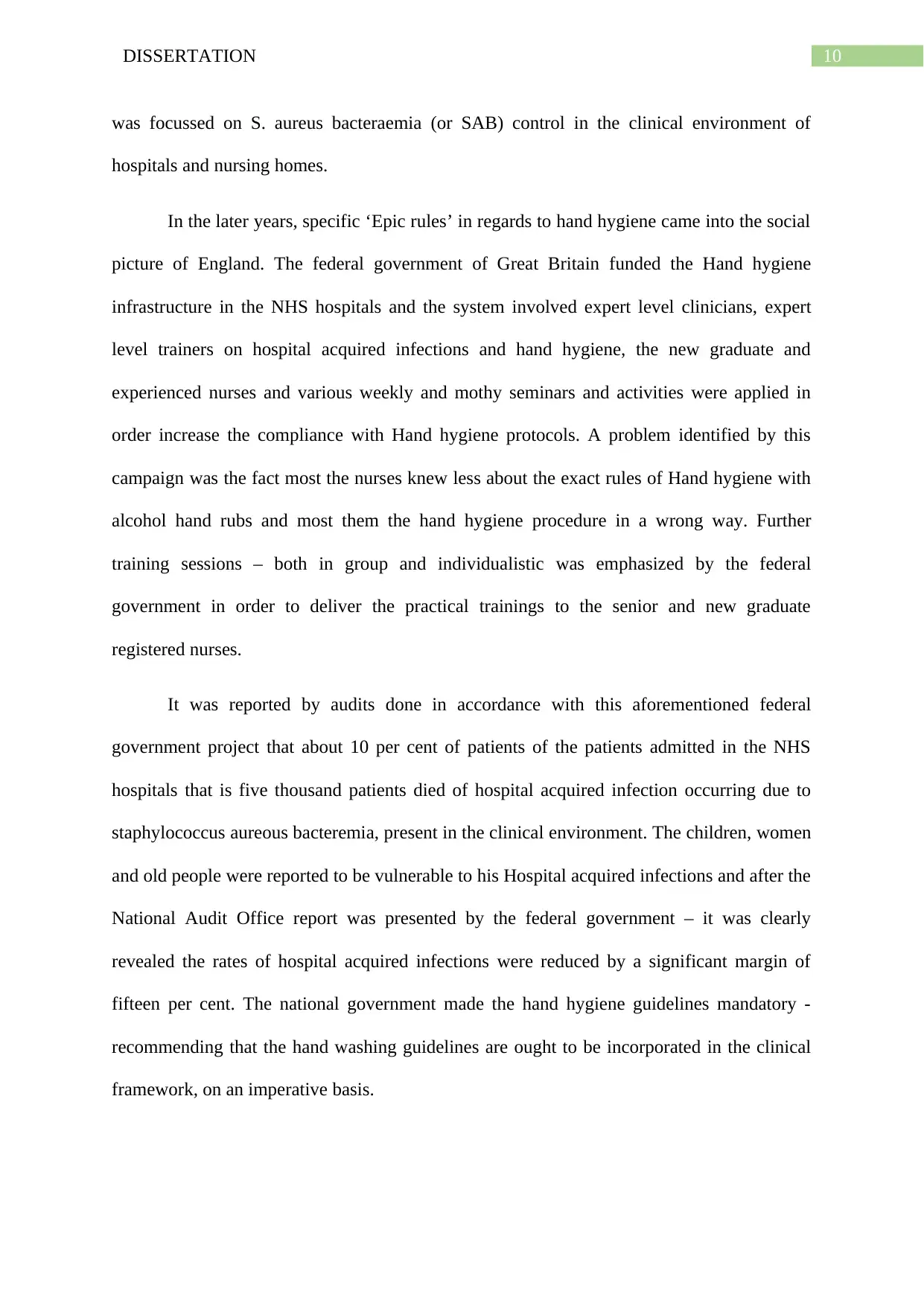
10DISSERTATION
was focussed on S. aureus bacteraemia (or SAB) control in the clinical environment of
hospitals and nursing homes.
In the later years, specific ‘Epic rules’ in regards to hand hygiene came into the social
picture of England. The federal government of Great Britain funded the Hand hygiene
infrastructure in the NHS hospitals and the system involved expert level clinicians, expert
level trainers on hospital acquired infections and hand hygiene, the new graduate and
experienced nurses and various weekly and mothy seminars and activities were applied in
order increase the compliance with Hand hygiene protocols. A problem identified by this
campaign was the fact most the nurses knew less about the exact rules of Hand hygiene with
alcohol hand rubs and most them the hand hygiene procedure in a wrong way. Further
training sessions – both in group and individualistic was emphasized by the federal
government in order to deliver the practical trainings to the senior and new graduate
registered nurses.
It was reported by audits done in accordance with this aforementioned federal
government project that about 10 per cent of patients of the patients admitted in the NHS
hospitals that is five thousand patients died of hospital acquired infection occurring due to
staphylococcus aureous bacteremia, present in the clinical environment. The children, women
and old people were reported to be vulnerable to his Hospital acquired infections and after the
National Audit Office report was presented by the federal government – it was clearly
revealed the rates of hospital acquired infections were reduced by a significant margin of
fifteen per cent. The national government made the hand hygiene guidelines mandatory -
recommending that the hand washing guidelines are ought to be incorporated in the clinical
framework, on an imperative basis.
was focussed on S. aureus bacteraemia (or SAB) control in the clinical environment of
hospitals and nursing homes.
In the later years, specific ‘Epic rules’ in regards to hand hygiene came into the social
picture of England. The federal government of Great Britain funded the Hand hygiene
infrastructure in the NHS hospitals and the system involved expert level clinicians, expert
level trainers on hospital acquired infections and hand hygiene, the new graduate and
experienced nurses and various weekly and mothy seminars and activities were applied in
order increase the compliance with Hand hygiene protocols. A problem identified by this
campaign was the fact most the nurses knew less about the exact rules of Hand hygiene with
alcohol hand rubs and most them the hand hygiene procedure in a wrong way. Further
training sessions – both in group and individualistic was emphasized by the federal
government in order to deliver the practical trainings to the senior and new graduate
registered nurses.
It was reported by audits done in accordance with this aforementioned federal
government project that about 10 per cent of patients of the patients admitted in the NHS
hospitals that is five thousand patients died of hospital acquired infection occurring due to
staphylococcus aureous bacteremia, present in the clinical environment. The children, women
and old people were reported to be vulnerable to his Hospital acquired infections and after the
National Audit Office report was presented by the federal government – it was clearly
revealed the rates of hospital acquired infections were reduced by a significant margin of
fifteen per cent. The national government made the hand hygiene guidelines mandatory -
recommending that the hand washing guidelines are ought to be incorporated in the clinical
framework, on an imperative basis.
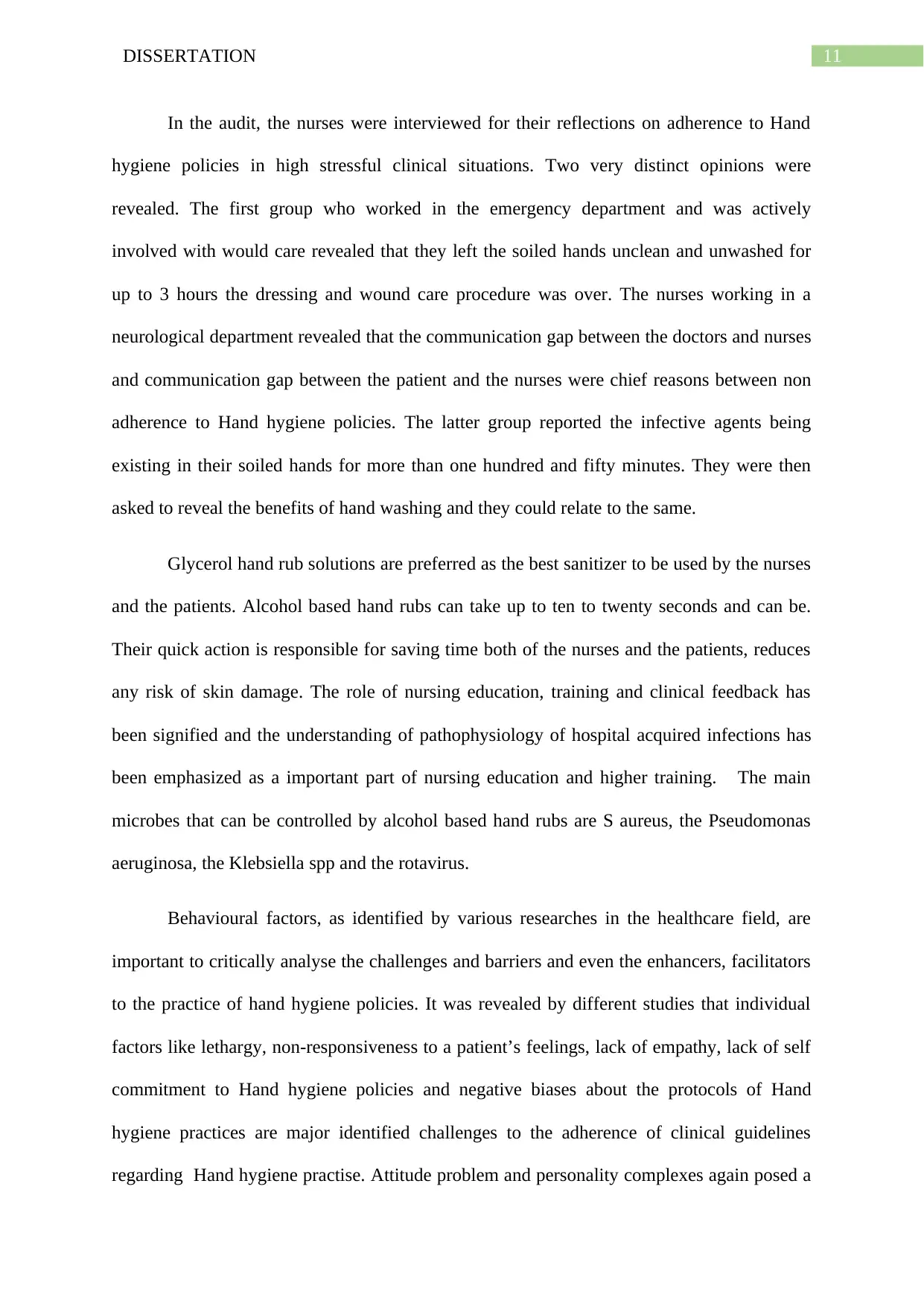
11DISSERTATION
In the audit, the nurses were interviewed for their reflections on adherence to Hand
hygiene policies in high stressful clinical situations. Two very distinct opinions were
revealed. The first group who worked in the emergency department and was actively
involved with would care revealed that they left the soiled hands unclean and unwashed for
up to 3 hours the dressing and wound care procedure was over. The nurses working in a
neurological department revealed that the communication gap between the doctors and nurses
and communication gap between the patient and the nurses were chief reasons between non
adherence to Hand hygiene policies. The latter group reported the infective agents being
existing in their soiled hands for more than one hundred and fifty minutes. They were then
asked to reveal the benefits of hand washing and they could relate to the same.
Glycerol hand rub solutions are preferred as the best sanitizer to be used by the nurses
and the patients. Alcohol based hand rubs can take up to ten to twenty seconds and can be.
Their quick action is responsible for saving time both of the nurses and the patients, reduces
any risk of skin damage. The role of nursing education, training and clinical feedback has
been signified and the understanding of pathophysiology of hospital acquired infections has
been emphasized as a important part of nursing education and higher training. The main
microbes that can be controlled by alcohol based hand rubs are S aureus, the Pseudomonas
aeruginosa, the Klebsiella spp and the rotavirus.
Behavioural factors, as identified by various researches in the healthcare field, are
important to critically analyse the challenges and barriers and even the enhancers, facilitators
to the practice of hand hygiene policies. It was revealed by different studies that individual
factors like lethargy, non-responsiveness to a patient’s feelings, lack of empathy, lack of self
commitment to Hand hygiene policies and negative biases about the protocols of Hand
hygiene practices are major identified challenges to the adherence of clinical guidelines
regarding Hand hygiene practise. Attitude problem and personality complexes again posed a
In the audit, the nurses were interviewed for their reflections on adherence to Hand
hygiene policies in high stressful clinical situations. Two very distinct opinions were
revealed. The first group who worked in the emergency department and was actively
involved with would care revealed that they left the soiled hands unclean and unwashed for
up to 3 hours the dressing and wound care procedure was over. The nurses working in a
neurological department revealed that the communication gap between the doctors and nurses
and communication gap between the patient and the nurses were chief reasons between non
adherence to Hand hygiene policies. The latter group reported the infective agents being
existing in their soiled hands for more than one hundred and fifty minutes. They were then
asked to reveal the benefits of hand washing and they could relate to the same.
Glycerol hand rub solutions are preferred as the best sanitizer to be used by the nurses
and the patients. Alcohol based hand rubs can take up to ten to twenty seconds and can be.
Their quick action is responsible for saving time both of the nurses and the patients, reduces
any risk of skin damage. The role of nursing education, training and clinical feedback has
been signified and the understanding of pathophysiology of hospital acquired infections has
been emphasized as a important part of nursing education and higher training. The main
microbes that can be controlled by alcohol based hand rubs are S aureus, the Pseudomonas
aeruginosa, the Klebsiella spp and the rotavirus.
Behavioural factors, as identified by various researches in the healthcare field, are
important to critically analyse the challenges and barriers and even the enhancers, facilitators
to the practice of hand hygiene policies. It was revealed by different studies that individual
factors like lethargy, non-responsiveness to a patient’s feelings, lack of empathy, lack of self
commitment to Hand hygiene policies and negative biases about the protocols of Hand
hygiene practices are major identified challenges to the adherence of clinical guidelines
regarding Hand hygiene practise. Attitude problem and personality complexes again posed a
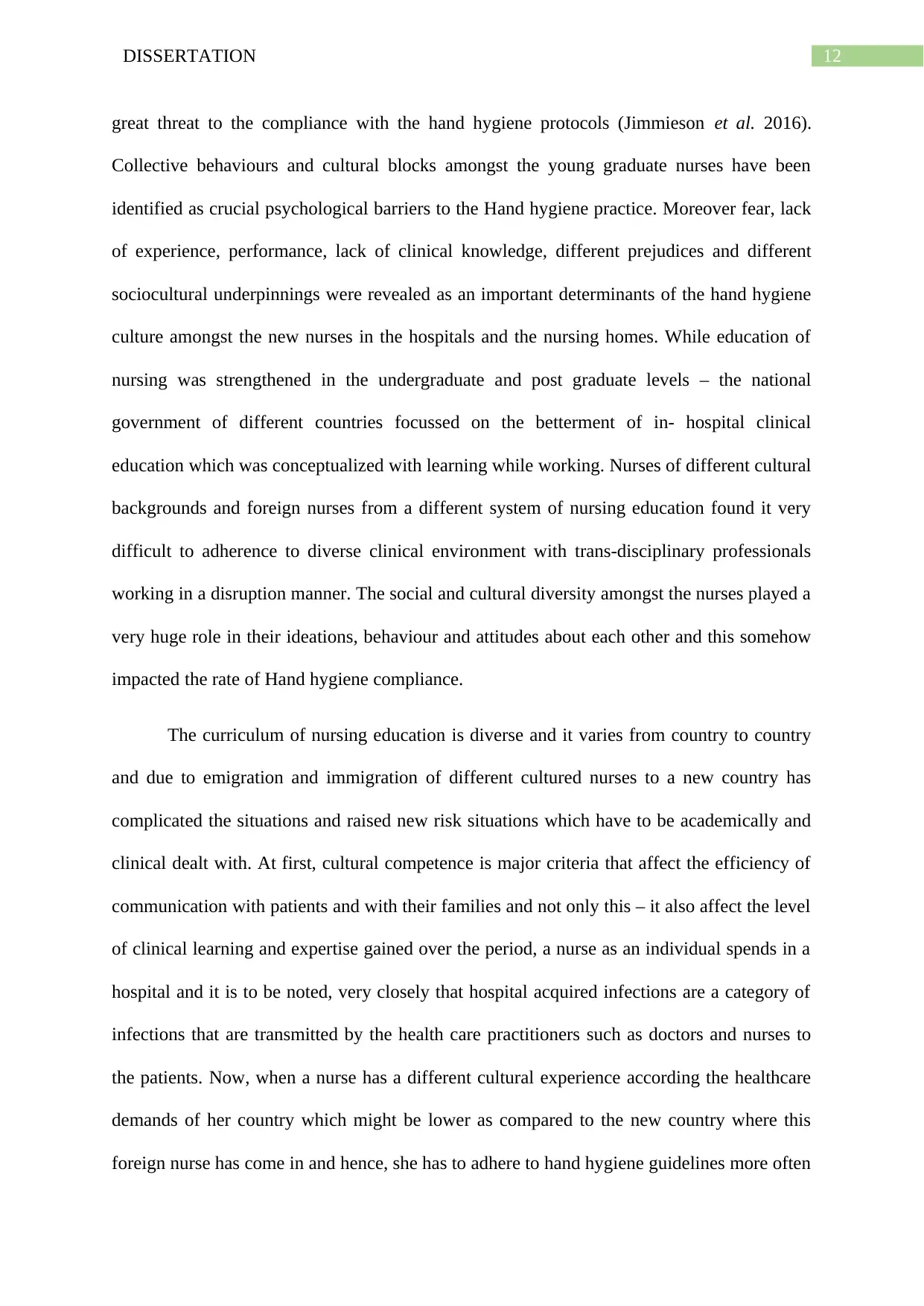
12DISSERTATION
great threat to the compliance with the hand hygiene protocols (Jimmieson et al. 2016).
Collective behaviours and cultural blocks amongst the young graduate nurses have been
identified as crucial psychological barriers to the Hand hygiene practice. Moreover fear, lack
of experience, performance, lack of clinical knowledge, different prejudices and different
sociocultural underpinnings were revealed as an important determinants of the hand hygiene
culture amongst the new nurses in the hospitals and the nursing homes. While education of
nursing was strengthened in the undergraduate and post graduate levels – the national
government of different countries focussed on the betterment of in- hospital clinical
education which was conceptualized with learning while working. Nurses of different cultural
backgrounds and foreign nurses from a different system of nursing education found it very
difficult to adherence to diverse clinical environment with trans-disciplinary professionals
working in a disruption manner. The social and cultural diversity amongst the nurses played a
very huge role in their ideations, behaviour and attitudes about each other and this somehow
impacted the rate of Hand hygiene compliance.
The curriculum of nursing education is diverse and it varies from country to country
and due to emigration and immigration of different cultured nurses to a new country has
complicated the situations and raised new risk situations which have to be academically and
clinical dealt with. At first, cultural competence is major criteria that affect the efficiency of
communication with patients and with their families and not only this – it also affect the level
of clinical learning and expertise gained over the period, a nurse as an individual spends in a
hospital and it is to be noted, very closely that hospital acquired infections are a category of
infections that are transmitted by the health care practitioners such as doctors and nurses to
the patients. Now, when a nurse has a different cultural experience according the healthcare
demands of her country which might be lower as compared to the new country where this
foreign nurse has come in and hence, she has to adhere to hand hygiene guidelines more often
great threat to the compliance with the hand hygiene protocols (Jimmieson et al. 2016).
Collective behaviours and cultural blocks amongst the young graduate nurses have been
identified as crucial psychological barriers to the Hand hygiene practice. Moreover fear, lack
of experience, performance, lack of clinical knowledge, different prejudices and different
sociocultural underpinnings were revealed as an important determinants of the hand hygiene
culture amongst the new nurses in the hospitals and the nursing homes. While education of
nursing was strengthened in the undergraduate and post graduate levels – the national
government of different countries focussed on the betterment of in- hospital clinical
education which was conceptualized with learning while working. Nurses of different cultural
backgrounds and foreign nurses from a different system of nursing education found it very
difficult to adherence to diverse clinical environment with trans-disciplinary professionals
working in a disruption manner. The social and cultural diversity amongst the nurses played a
very huge role in their ideations, behaviour and attitudes about each other and this somehow
impacted the rate of Hand hygiene compliance.
The curriculum of nursing education is diverse and it varies from country to country
and due to emigration and immigration of different cultured nurses to a new country has
complicated the situations and raised new risk situations which have to be academically and
clinical dealt with. At first, cultural competence is major criteria that affect the efficiency of
communication with patients and with their families and not only this – it also affect the level
of clinical learning and expertise gained over the period, a nurse as an individual spends in a
hospital and it is to be noted, very closely that hospital acquired infections are a category of
infections that are transmitted by the health care practitioners such as doctors and nurses to
the patients. Now, when a nurse has a different cultural experience according the healthcare
demands of her country which might be lower as compared to the new country where this
foreign nurse has come in and hence, she has to adhere to hand hygiene guidelines more often
Paraphrase This Document
Need a fresh take? Get an instant paraphrase of this document with our AI Paraphraser

13DISSERTATION
and critically as compared to what she has been doing in her own country. The difference
between the frequency of hand hygiene practices and techniques in a single day and on a
daily basis increasing affects the clinical performance and it often reduces the patient care
time. Due to this reason, various new graduate nurses and even the experienced nurses tend to
focus more patient servicing time than hand washing but at the end, non-compliance to hand
hygiene protocols deeply affects the condition of the affected patient as the impact of hospital
acquired infections shifts the pendulum of an already critical care to a more severe plane.
That is why, cultural competence training has been nowadays being used as a ‘clinical tool’
in the training of new graduate nurses and foreign nurses on clinical activities such as hand
hygiene in prevention of hospital acquired infections. The language barrier between different
nurses along with professional and personal differences between the nurses, lead to a
negatively blended workplace leading more chaos, indiscipline and non-adherence to hand
washing protocols. The training hence in the recent years, especially whose which are done in
the hospitals focus on effective communication development between the nurses, effective
resolution techniques and personality improvement plan as a major strategy towards building
of more effective adherence to clinic personal hygiene and patient centred care guidelines.
There had also been studies that focus on the relationships, rather clinical relationships
between non-compliance of nursing principles by nurses with non-compliance of hygiene
guidelines by the registered nurses. This is where the factors like self-motivation,
commitment and communication play a very important function in understanding and
following of a hand hygiene procedure even in the most critical of situations.
It is to be noted, as put forward by various studies, that clinical excellence comes
from a person with differential attitude and the one who is being able to keep calm in the
most difficult of situations in the clinical environment. In a high paced, successfully running
nursing home or hospital – the patient in flow is quite high and given an urban area with a lot
and critically as compared to what she has been doing in her own country. The difference
between the frequency of hand hygiene practices and techniques in a single day and on a
daily basis increasing affects the clinical performance and it often reduces the patient care
time. Due to this reason, various new graduate nurses and even the experienced nurses tend to
focus more patient servicing time than hand washing but at the end, non-compliance to hand
hygiene protocols deeply affects the condition of the affected patient as the impact of hospital
acquired infections shifts the pendulum of an already critical care to a more severe plane.
That is why, cultural competence training has been nowadays being used as a ‘clinical tool’
in the training of new graduate nurses and foreign nurses on clinical activities such as hand
hygiene in prevention of hospital acquired infections. The language barrier between different
nurses along with professional and personal differences between the nurses, lead to a
negatively blended workplace leading more chaos, indiscipline and non-adherence to hand
washing protocols. The training hence in the recent years, especially whose which are done in
the hospitals focus on effective communication development between the nurses, effective
resolution techniques and personality improvement plan as a major strategy towards building
of more effective adherence to clinic personal hygiene and patient centred care guidelines.
There had also been studies that focus on the relationships, rather clinical relationships
between non-compliance of nursing principles by nurses with non-compliance of hygiene
guidelines by the registered nurses. This is where the factors like self-motivation,
commitment and communication play a very important function in understanding and
following of a hand hygiene procedure even in the most critical of situations.
It is to be noted, as put forward by various studies, that clinical excellence comes
from a person with differential attitude and the one who is being able to keep calm in the
most difficult of situations in the clinical environment. In a high paced, successfully running
nursing home or hospital – the patient in flow is quite high and given an urban area with a lot
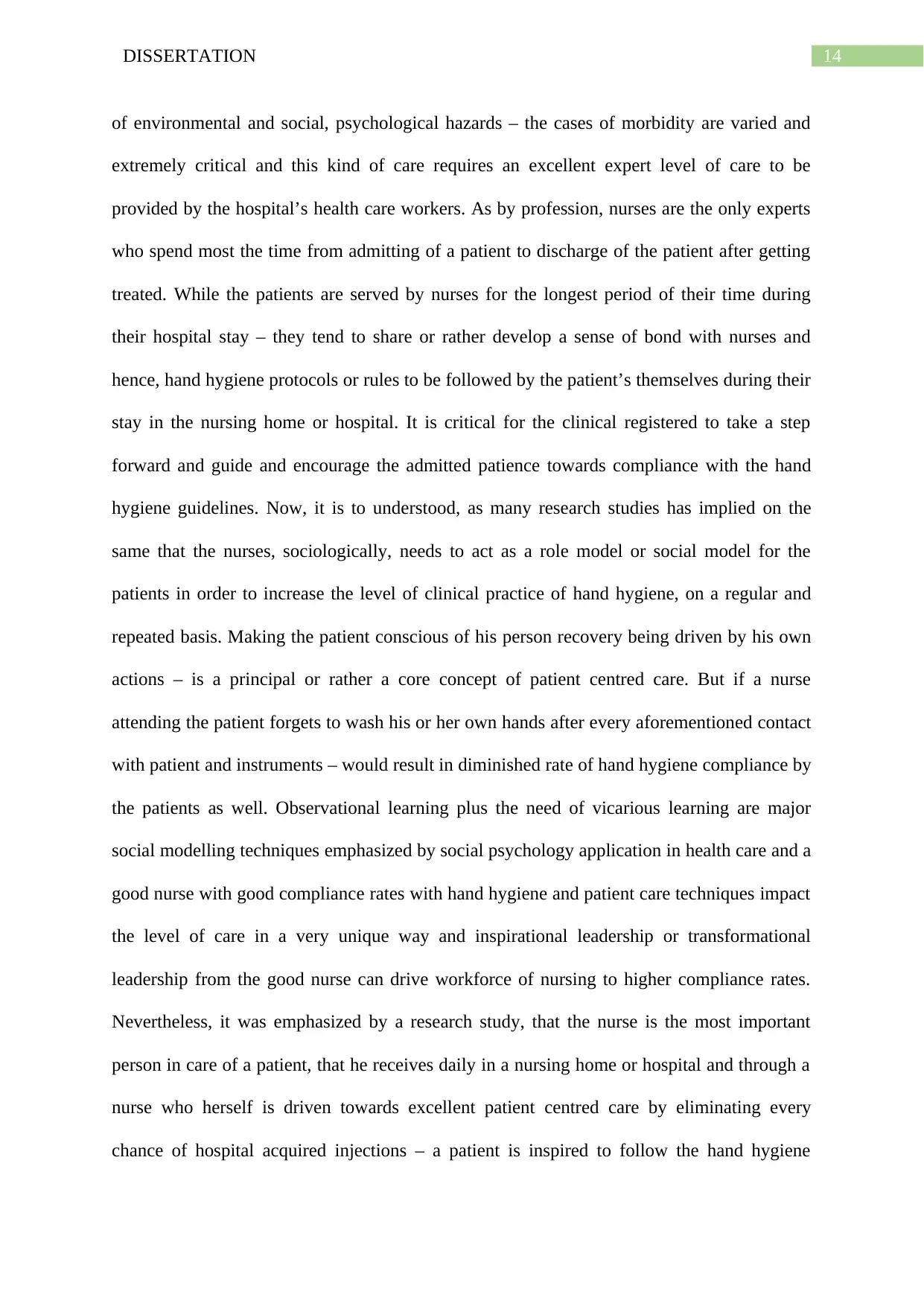
14DISSERTATION
of environmental and social, psychological hazards – the cases of morbidity are varied and
extremely critical and this kind of care requires an excellent expert level of care to be
provided by the hospital’s health care workers. As by profession, nurses are the only experts
who spend most the time from admitting of a patient to discharge of the patient after getting
treated. While the patients are served by nurses for the longest period of their time during
their hospital stay – they tend to share or rather develop a sense of bond with nurses and
hence, hand hygiene protocols or rules to be followed by the patient’s themselves during their
stay in the nursing home or hospital. It is critical for the clinical registered to take a step
forward and guide and encourage the admitted patience towards compliance with the hand
hygiene guidelines. Now, it is to understood, as many research studies has implied on the
same that the nurses, sociologically, needs to act as a role model or social model for the
patients in order to increase the level of clinical practice of hand hygiene, on a regular and
repeated basis. Making the patient conscious of his person recovery being driven by his own
actions – is a principal or rather a core concept of patient centred care. But if a nurse
attending the patient forgets to wash his or her own hands after every aforementioned contact
with patient and instruments – would result in diminished rate of hand hygiene compliance by
the patients as well. Observational learning plus the need of vicarious learning are major
social modelling techniques emphasized by social psychology application in health care and a
good nurse with good compliance rates with hand hygiene and patient care techniques impact
the level of care in a very unique way and inspirational leadership or transformational
leadership from the good nurse can drive workforce of nursing to higher compliance rates.
Nevertheless, it was emphasized by a research study, that the nurse is the most important
person in care of a patient, that he receives daily in a nursing home or hospital and through a
nurse who herself is driven towards excellent patient centred care by eliminating every
chance of hospital acquired injections – a patient is inspired to follow the hand hygiene
of environmental and social, psychological hazards – the cases of morbidity are varied and
extremely critical and this kind of care requires an excellent expert level of care to be
provided by the hospital’s health care workers. As by profession, nurses are the only experts
who spend most the time from admitting of a patient to discharge of the patient after getting
treated. While the patients are served by nurses for the longest period of their time during
their hospital stay – they tend to share or rather develop a sense of bond with nurses and
hence, hand hygiene protocols or rules to be followed by the patient’s themselves during their
stay in the nursing home or hospital. It is critical for the clinical registered to take a step
forward and guide and encourage the admitted patience towards compliance with the hand
hygiene guidelines. Now, it is to understood, as many research studies has implied on the
same that the nurses, sociologically, needs to act as a role model or social model for the
patients in order to increase the level of clinical practice of hand hygiene, on a regular and
repeated basis. Making the patient conscious of his person recovery being driven by his own
actions – is a principal or rather a core concept of patient centred care. But if a nurse
attending the patient forgets to wash his or her own hands after every aforementioned contact
with patient and instruments – would result in diminished rate of hand hygiene compliance by
the patients as well. Observational learning plus the need of vicarious learning are major
social modelling techniques emphasized by social psychology application in health care and a
good nurse with good compliance rates with hand hygiene and patient care techniques impact
the level of care in a very unique way and inspirational leadership or transformational
leadership from the good nurse can drive workforce of nursing to higher compliance rates.
Nevertheless, it was emphasized by a research study, that the nurse is the most important
person in care of a patient, that he receives daily in a nursing home or hospital and through a
nurse who herself is driven towards excellent patient centred care by eliminating every
chance of hospital acquired injections – a patient is inspired to follow the hand hygiene
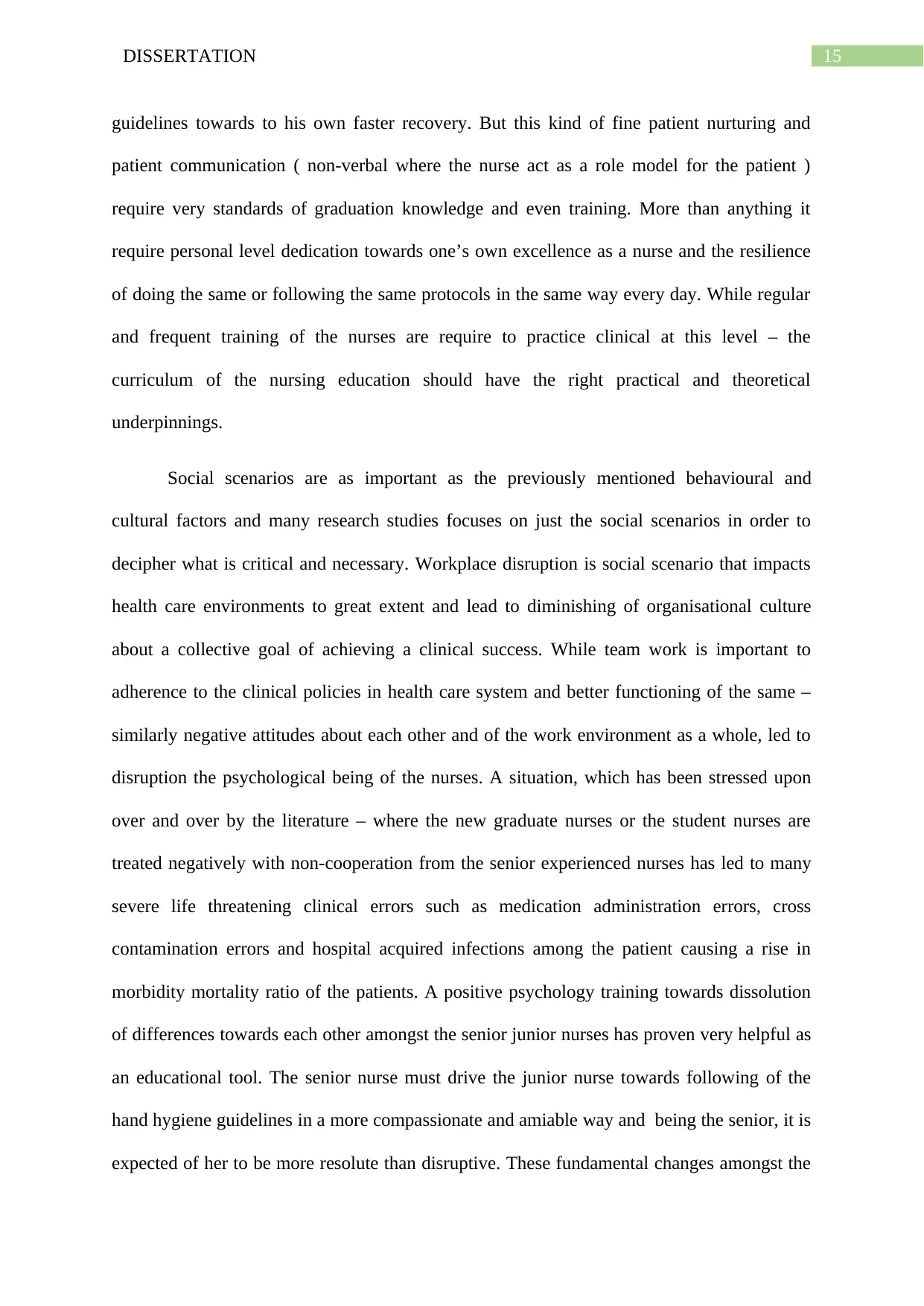
15DISSERTATION
guidelines towards to his own faster recovery. But this kind of fine patient nurturing and
patient communication ( non-verbal where the nurse act as a role model for the patient )
require very standards of graduation knowledge and even training. More than anything it
require personal level dedication towards one’s own excellence as a nurse and the resilience
of doing the same or following the same protocols in the same way every day. While regular
and frequent training of the nurses are require to practice clinical at this level – the
curriculum of the nursing education should have the right practical and theoretical
underpinnings.
Social scenarios are as important as the previously mentioned behavioural and
cultural factors and many research studies focuses on just the social scenarios in order to
decipher what is critical and necessary. Workplace disruption is social scenario that impacts
health care environments to great extent and lead to diminishing of organisational culture
about a collective goal of achieving a clinical success. While team work is important to
adherence to the clinical policies in health care system and better functioning of the same –
similarly negative attitudes about each other and of the work environment as a whole, led to
disruption the psychological being of the nurses. A situation, which has been stressed upon
over and over by the literature – where the new graduate nurses or the student nurses are
treated negatively with non-cooperation from the senior experienced nurses has led to many
severe life threatening clinical errors such as medication administration errors, cross
contamination errors and hospital acquired infections among the patient causing a rise in
morbidity mortality ratio of the patients. A positive psychology training towards dissolution
of differences towards each other amongst the senior junior nurses has proven very helpful as
an educational tool. The senior nurse must drive the junior nurse towards following of the
hand hygiene guidelines in a more compassionate and amiable way and being the senior, it is
expected of her to be more resolute than disruptive. These fundamental changes amongst the
guidelines towards to his own faster recovery. But this kind of fine patient nurturing and
patient communication ( non-verbal where the nurse act as a role model for the patient )
require very standards of graduation knowledge and even training. More than anything it
require personal level dedication towards one’s own excellence as a nurse and the resilience
of doing the same or following the same protocols in the same way every day. While regular
and frequent training of the nurses are require to practice clinical at this level – the
curriculum of the nursing education should have the right practical and theoretical
underpinnings.
Social scenarios are as important as the previously mentioned behavioural and
cultural factors and many research studies focuses on just the social scenarios in order to
decipher what is critical and necessary. Workplace disruption is social scenario that impacts
health care environments to great extent and lead to diminishing of organisational culture
about a collective goal of achieving a clinical success. While team work is important to
adherence to the clinical policies in health care system and better functioning of the same –
similarly negative attitudes about each other and of the work environment as a whole, led to
disruption the psychological being of the nurses. A situation, which has been stressed upon
over and over by the literature – where the new graduate nurses or the student nurses are
treated negatively with non-cooperation from the senior experienced nurses has led to many
severe life threatening clinical errors such as medication administration errors, cross
contamination errors and hospital acquired infections among the patient causing a rise in
morbidity mortality ratio of the patients. A positive psychology training towards dissolution
of differences towards each other amongst the senior junior nurses has proven very helpful as
an educational tool. The senior nurse must drive the junior nurse towards following of the
hand hygiene guidelines in a more compassionate and amiable way and being the senior, it is
expected of her to be more resolute than disruptive. These fundamental changes amongst the
Secure Best Marks with AI Grader
Need help grading? Try our AI Grader for instant feedback on your assignments.
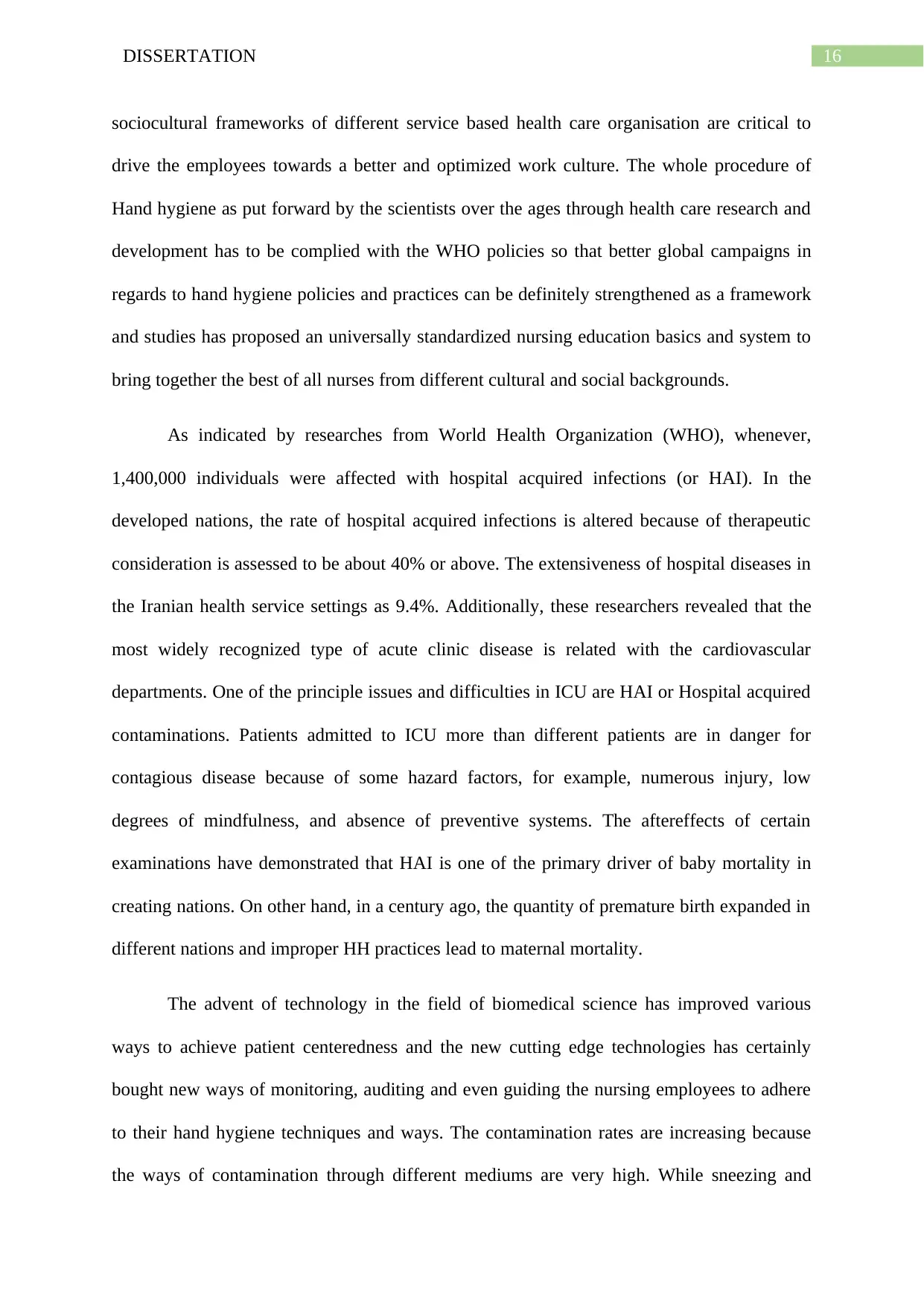
16DISSERTATION
sociocultural frameworks of different service based health care organisation are critical to
drive the employees towards a better and optimized work culture. The whole procedure of
Hand hygiene as put forward by the scientists over the ages through health care research and
development has to be complied with the WHO policies so that better global campaigns in
regards to hand hygiene policies and practices can be definitely strengthened as a framework
and studies has proposed an universally standardized nursing education basics and system to
bring together the best of all nurses from different cultural and social backgrounds.
As indicated by researches from World Health Organization (WHO), whenever,
1,400,000 individuals were affected with hospital acquired infections (or HAI). In the
developed nations, the rate of hospital acquired infections is altered because of therapeutic
consideration is assessed to be about 40% or above. The extensiveness of hospital diseases in
the Iranian health service settings as 9.4%. Additionally, these researchers revealed that the
most widely recognized type of acute clinic disease is related with the cardiovascular
departments. One of the principle issues and difficulties in ICU are HAI or Hospital acquired
contaminations. Patients admitted to ICU more than different patients are in danger for
contagious disease because of some hazard factors, for example, numerous injury, low
degrees of mindfulness, and absence of preventive systems. The aftereffects of certain
examinations have demonstrated that HAI is one of the primary driver of baby mortality in
creating nations. On other hand, in a century ago, the quantity of premature birth expanded in
different nations and improper HH practices lead to maternal mortality.
The advent of technology in the field of biomedical science has improved various
ways to achieve patient centeredness and the new cutting edge technologies has certainly
bought new ways of monitoring, auditing and even guiding the nursing employees to adhere
to their hand hygiene techniques and ways. The contamination rates are increasing because
the ways of contamination through different mediums are very high. While sneezing and
sociocultural frameworks of different service based health care organisation are critical to
drive the employees towards a better and optimized work culture. The whole procedure of
Hand hygiene as put forward by the scientists over the ages through health care research and
development has to be complied with the WHO policies so that better global campaigns in
regards to hand hygiene policies and practices can be definitely strengthened as a framework
and studies has proposed an universally standardized nursing education basics and system to
bring together the best of all nurses from different cultural and social backgrounds.
As indicated by researches from World Health Organization (WHO), whenever,
1,400,000 individuals were affected with hospital acquired infections (or HAI). In the
developed nations, the rate of hospital acquired infections is altered because of therapeutic
consideration is assessed to be about 40% or above. The extensiveness of hospital diseases in
the Iranian health service settings as 9.4%. Additionally, these researchers revealed that the
most widely recognized type of acute clinic disease is related with the cardiovascular
departments. One of the principle issues and difficulties in ICU are HAI or Hospital acquired
contaminations. Patients admitted to ICU more than different patients are in danger for
contagious disease because of some hazard factors, for example, numerous injury, low
degrees of mindfulness, and absence of preventive systems. The aftereffects of certain
examinations have demonstrated that HAI is one of the primary driver of baby mortality in
creating nations. On other hand, in a century ago, the quantity of premature birth expanded in
different nations and improper HH practices lead to maternal mortality.
The advent of technology in the field of biomedical science has improved various
ways to achieve patient centeredness and the new cutting edge technologies has certainly
bought new ways of monitoring, auditing and even guiding the nursing employees to adhere
to their hand hygiene techniques and ways. The contamination rates are increasing because
the ways of contamination through different mediums are very high. While sneezing and
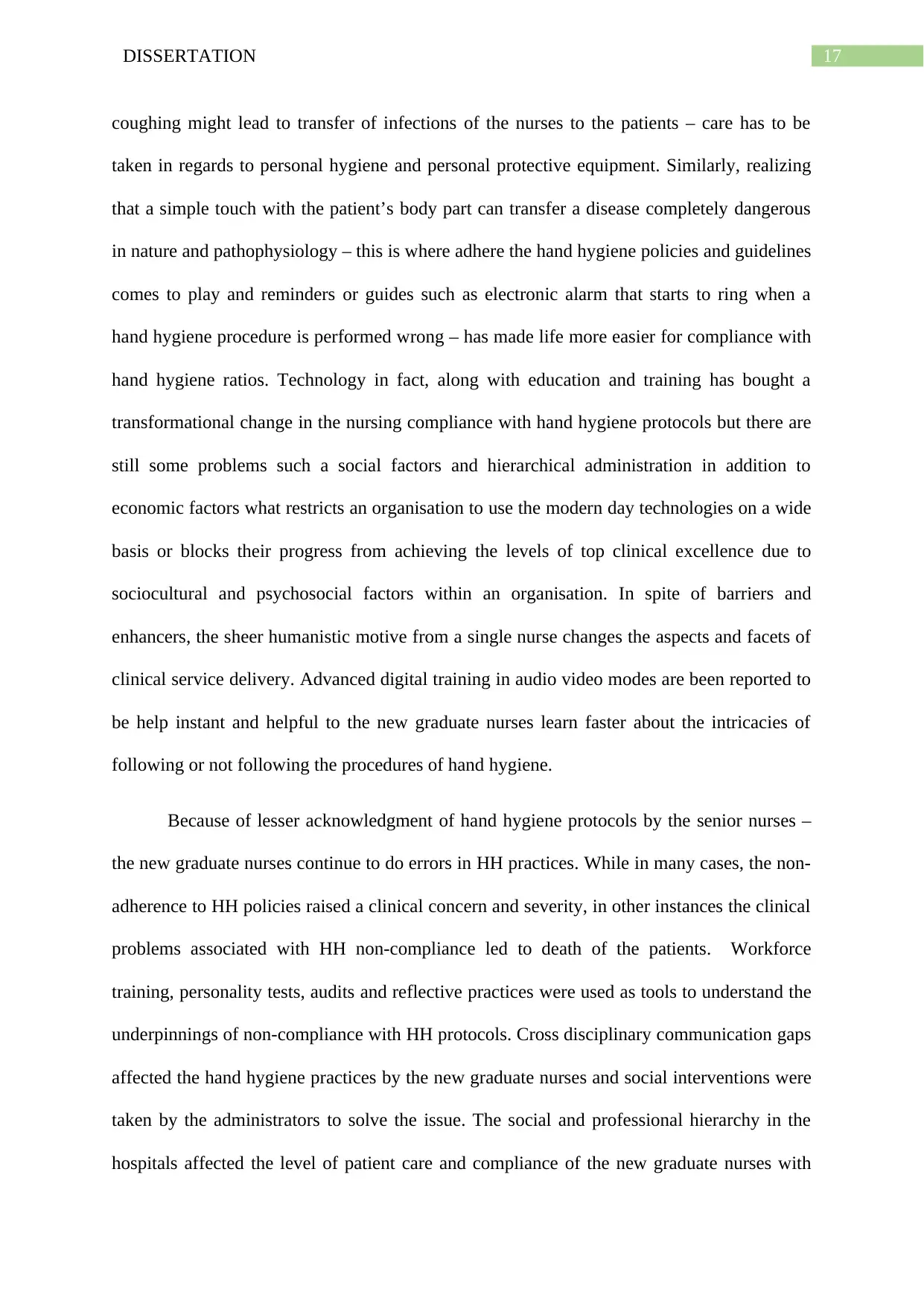
17DISSERTATION
coughing might lead to transfer of infections of the nurses to the patients – care has to be
taken in regards to personal hygiene and personal protective equipment. Similarly, realizing
that a simple touch with the patient’s body part can transfer a disease completely dangerous
in nature and pathophysiology – this is where adhere the hand hygiene policies and guidelines
comes to play and reminders or guides such as electronic alarm that starts to ring when a
hand hygiene procedure is performed wrong – has made life more easier for compliance with
hand hygiene ratios. Technology in fact, along with education and training has bought a
transformational change in the nursing compliance with hand hygiene protocols but there are
still some problems such a social factors and hierarchical administration in addition to
economic factors what restricts an organisation to use the modern day technologies on a wide
basis or blocks their progress from achieving the levels of top clinical excellence due to
sociocultural and psychosocial factors within an organisation. In spite of barriers and
enhancers, the sheer humanistic motive from a single nurse changes the aspects and facets of
clinical service delivery. Advanced digital training in audio video modes are been reported to
be help instant and helpful to the new graduate nurses learn faster about the intricacies of
following or not following the procedures of hand hygiene.
Because of lesser acknowledgment of hand hygiene protocols by the senior nurses –
the new graduate nurses continue to do errors in HH practices. While in many cases, the non-
adherence to HH policies raised a clinical concern and severity, in other instances the clinical
problems associated with HH non-compliance led to death of the patients. Workforce
training, personality tests, audits and reflective practices were used as tools to understand the
underpinnings of non-compliance with HH protocols. Cross disciplinary communication gaps
affected the hand hygiene practices by the new graduate nurses and social interventions were
taken by the administrators to solve the issue. The social and professional hierarchy in the
hospitals affected the level of patient care and compliance of the new graduate nurses with
coughing might lead to transfer of infections of the nurses to the patients – care has to be
taken in regards to personal hygiene and personal protective equipment. Similarly, realizing
that a simple touch with the patient’s body part can transfer a disease completely dangerous
in nature and pathophysiology – this is where adhere the hand hygiene policies and guidelines
comes to play and reminders or guides such as electronic alarm that starts to ring when a
hand hygiene procedure is performed wrong – has made life more easier for compliance with
hand hygiene ratios. Technology in fact, along with education and training has bought a
transformational change in the nursing compliance with hand hygiene protocols but there are
still some problems such a social factors and hierarchical administration in addition to
economic factors what restricts an organisation to use the modern day technologies on a wide
basis or blocks their progress from achieving the levels of top clinical excellence due to
sociocultural and psychosocial factors within an organisation. In spite of barriers and
enhancers, the sheer humanistic motive from a single nurse changes the aspects and facets of
clinical service delivery. Advanced digital training in audio video modes are been reported to
be help instant and helpful to the new graduate nurses learn faster about the intricacies of
following or not following the procedures of hand hygiene.
Because of lesser acknowledgment of hand hygiene protocols by the senior nurses –
the new graduate nurses continue to do errors in HH practices. While in many cases, the non-
adherence to HH policies raised a clinical concern and severity, in other instances the clinical
problems associated with HH non-compliance led to death of the patients. Workforce
training, personality tests, audits and reflective practices were used as tools to understand the
underpinnings of non-compliance with HH protocols. Cross disciplinary communication gaps
affected the hand hygiene practices by the new graduate nurses and social interventions were
taken by the administrators to solve the issue. The social and professional hierarchy in the
hospitals affected the level of patient care and compliance of the new graduate nurses with

18DISSERTATION
the hand hygiene policies and protocols. While legal and administrative barriers were
common causes of anxiety and stress amongst the new nurses who stressed out very much
under clinical pressure, many studies have stressed on the flexibility of the administrative
hierarchy to help the new nurses learn at their own pace without risking the life of the
patients. Educational problems in the national framework of nursing academic lacked the
safety concerns and risk evoking in regards to hospital acquired infection and the importance
of adhering to the hand hygiene procedures on a daily basis, so as to comply with safety
standards. Many national governments of different countries now aid learning while working
and the nurses were reported to benefit a lot out of it.
Background
The nurses amongst the different cultures and from different nationalities shares
similar concerns regarding the hand hygiene and hand washing guidelines and the new
graduate nurses have reflected on different points which are very different from the
reflections made by the experienced nurses, about the same clinical scenario related to
adherence of clinical policies regarding hand hygiene. While most of the nurses from
different social backgrounds and cultural diversity revealed the time issues associated with
adherence to hand hygiene clinical policy. The time consumed in the surgical and clinical
scenario is very critical and this perception of the nurses about their own clinical role which
is more directed towards patient care and most the nurses felt it is more important to attend
the patient for most of the time than using the same time in 5 moments of hand washing. The
nurses reflected on the stressed situations that more the critical situation, more is the
susceptibility to forgetting of clinical policies. The perception of time which has been
highlighted in many studies as a major barrier amongst the nurses towards adherence of
the hand hygiene policies and protocols. While legal and administrative barriers were
common causes of anxiety and stress amongst the new nurses who stressed out very much
under clinical pressure, many studies have stressed on the flexibility of the administrative
hierarchy to help the new nurses learn at their own pace without risking the life of the
patients. Educational problems in the national framework of nursing academic lacked the
safety concerns and risk evoking in regards to hospital acquired infection and the importance
of adhering to the hand hygiene procedures on a daily basis, so as to comply with safety
standards. Many national governments of different countries now aid learning while working
and the nurses were reported to benefit a lot out of it.
Background
The nurses amongst the different cultures and from different nationalities shares
similar concerns regarding the hand hygiene and hand washing guidelines and the new
graduate nurses have reflected on different points which are very different from the
reflections made by the experienced nurses, about the same clinical scenario related to
adherence of clinical policies regarding hand hygiene. While most of the nurses from
different social backgrounds and cultural diversity revealed the time issues associated with
adherence to hand hygiene clinical policy. The time consumed in the surgical and clinical
scenario is very critical and this perception of the nurses about their own clinical role which
is more directed towards patient care and most the nurses felt it is more important to attend
the patient for most of the time than using the same time in 5 moments of hand washing. The
nurses reflected on the stressed situations that more the critical situation, more is the
susceptibility to forgetting of clinical policies. The perception of time which has been
highlighted in many studies as a major barrier amongst the nurses towards adherence of
Paraphrase This Document
Need a fresh take? Get an instant paraphrase of this document with our AI Paraphraser
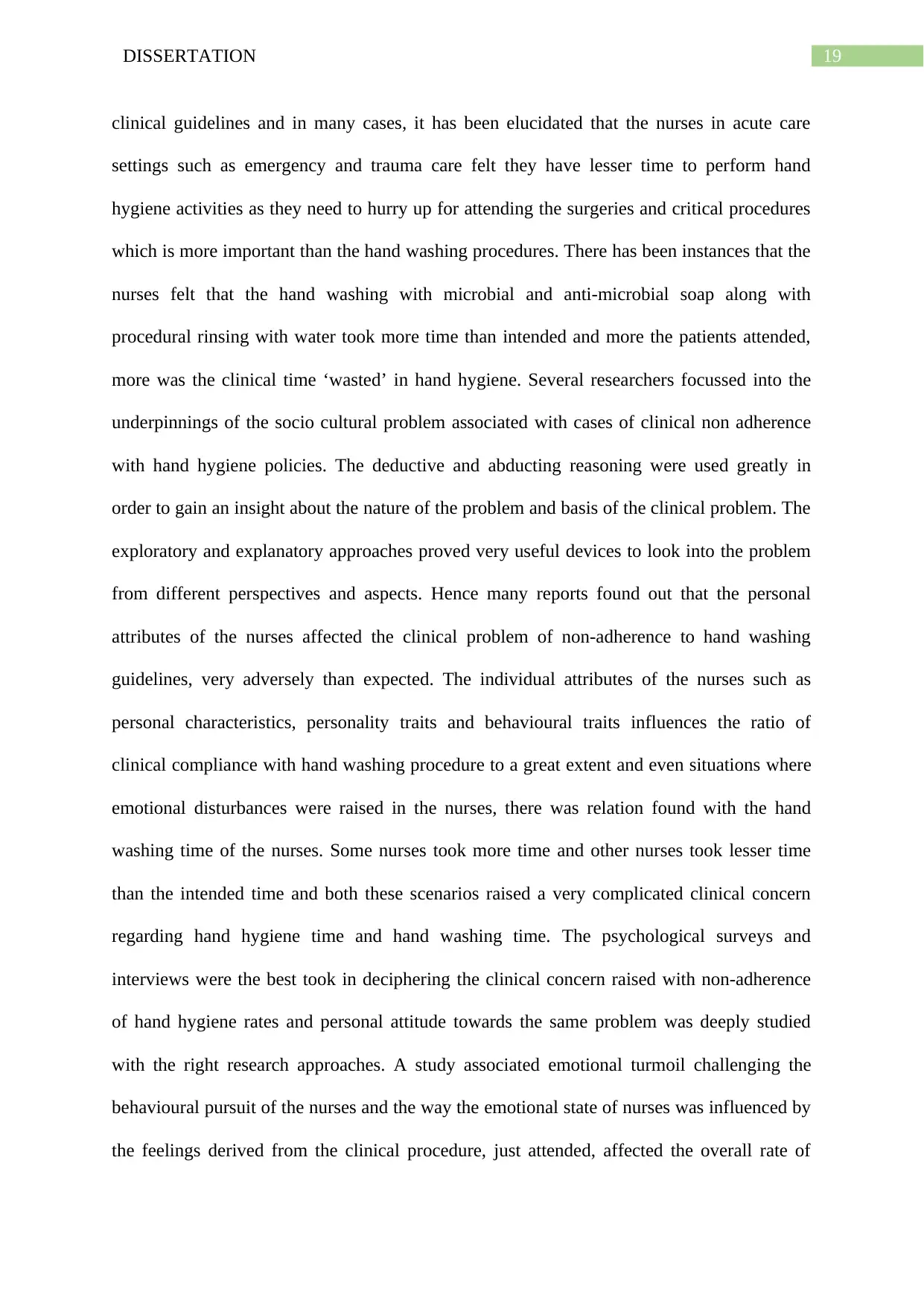
19DISSERTATION
clinical guidelines and in many cases, it has been elucidated that the nurses in acute care
settings such as emergency and trauma care felt they have lesser time to perform hand
hygiene activities as they need to hurry up for attending the surgeries and critical procedures
which is more important than the hand washing procedures. There has been instances that the
nurses felt that the hand washing with microbial and anti-microbial soap along with
procedural rinsing with water took more time than intended and more the patients attended,
more was the clinical time ‘wasted’ in hand hygiene. Several researchers focussed into the
underpinnings of the socio cultural problem associated with cases of clinical non adherence
with hand hygiene policies. The deductive and abducting reasoning were used greatly in
order to gain an insight about the nature of the problem and basis of the clinical problem. The
exploratory and explanatory approaches proved very useful devices to look into the problem
from different perspectives and aspects. Hence many reports found out that the personal
attributes of the nurses affected the clinical problem of non-adherence to hand washing
guidelines, very adversely than expected. The individual attributes of the nurses such as
personal characteristics, personality traits and behavioural traits influences the ratio of
clinical compliance with hand washing procedure to a great extent and even situations where
emotional disturbances were raised in the nurses, there was relation found with the hand
washing time of the nurses. Some nurses took more time and other nurses took lesser time
than the intended time and both these scenarios raised a very complicated clinical concern
regarding hand hygiene time and hand washing time. The psychological surveys and
interviews were the best took in deciphering the clinical concern raised with non-adherence
of hand hygiene rates and personal attitude towards the same problem was deeply studied
with the right research approaches. A study associated emotional turmoil challenging the
behavioural pursuit of the nurses and the way the emotional state of nurses was influenced by
the feelings derived from the clinical procedure, just attended, affected the overall rate of
clinical guidelines and in many cases, it has been elucidated that the nurses in acute care
settings such as emergency and trauma care felt they have lesser time to perform hand
hygiene activities as they need to hurry up for attending the surgeries and critical procedures
which is more important than the hand washing procedures. There has been instances that the
nurses felt that the hand washing with microbial and anti-microbial soap along with
procedural rinsing with water took more time than intended and more the patients attended,
more was the clinical time ‘wasted’ in hand hygiene. Several researchers focussed into the
underpinnings of the socio cultural problem associated with cases of clinical non adherence
with hand hygiene policies. The deductive and abducting reasoning were used greatly in
order to gain an insight about the nature of the problem and basis of the clinical problem. The
exploratory and explanatory approaches proved very useful devices to look into the problem
from different perspectives and aspects. Hence many reports found out that the personal
attributes of the nurses affected the clinical problem of non-adherence to hand washing
guidelines, very adversely than expected. The individual attributes of the nurses such as
personal characteristics, personality traits and behavioural traits influences the ratio of
clinical compliance with hand washing procedure to a great extent and even situations where
emotional disturbances were raised in the nurses, there was relation found with the hand
washing time of the nurses. Some nurses took more time and other nurses took lesser time
than the intended time and both these scenarios raised a very complicated clinical concern
regarding hand hygiene time and hand washing time. The psychological surveys and
interviews were the best took in deciphering the clinical concern raised with non-adherence
of hand hygiene rates and personal attitude towards the same problem was deeply studied
with the right research approaches. A study associated emotional turmoil challenging the
behavioural pursuit of the nurses and the way the emotional state of nurses was influenced by
the feelings derived from the clinical procedure, just attended, affected the overall rate of

20DISSERTATION
clinical adherence of hand hygiene guidelines. More than a social issue, a personal attitude of
the nurse towards compliance with hand washing guidelines was an output of covert
emotional behaviour occurring within a nurse after or before a clinical procedure.
Behavioural issues of the doctors with the attending nurses was seen as a huge problem and a
major underlying factor that concocted the emotional state of the nurses attending the surgical
procedure was the adverse behaviour of the doctors and the negative emotions arising from
the clinical scenarios and communication gaps raised various issues with clinical adherence
and non-compliance to hand hygiene was one of them. The moral of the hand hygiene
procedure was not realised by the nurses in many age groups and from different country
where the curriculum focussed more on clinical patient servicing time than the personal
hygiene and clinical hygiene activities, to be done on a daily basis. The problem was far more
perplexing in the undeveloped countries where the health care or hospital infrastructure itself
does not support the adherence policies to hand washing after every clinical contacts and
hence, the rates of hospital acquired infections were very high in these clinical situations. The
hospital acquired infections that occur as a result of cross contamination and improper risk
management is quite a significant issue in different under developed countries and third
world countries. While the World Health Organisation has reached new standards in
compliance raising amongst the nurses of first world or developed countries – it remains still
a huge barrier for the nurses of underdeveloped countries to comply with the hand hygiene
guidelines in a very effective way. While the hospital supplies such as the soaps, clean water
and regular water supply is quite a problem or infrastructural issue in the hospitals, the
operational issue is whole different problem all together.
The operational issue as raised by researchers in the recent and previous years of the
hand hygiene researches – are multi-faceted and are entwined with a complete differential
individual practice and perceptions about work ethics and the need for adhering to some
clinical adherence of hand hygiene guidelines. More than a social issue, a personal attitude of
the nurse towards compliance with hand washing guidelines was an output of covert
emotional behaviour occurring within a nurse after or before a clinical procedure.
Behavioural issues of the doctors with the attending nurses was seen as a huge problem and a
major underlying factor that concocted the emotional state of the nurses attending the surgical
procedure was the adverse behaviour of the doctors and the negative emotions arising from
the clinical scenarios and communication gaps raised various issues with clinical adherence
and non-compliance to hand hygiene was one of them. The moral of the hand hygiene
procedure was not realised by the nurses in many age groups and from different country
where the curriculum focussed more on clinical patient servicing time than the personal
hygiene and clinical hygiene activities, to be done on a daily basis. The problem was far more
perplexing in the undeveloped countries where the health care or hospital infrastructure itself
does not support the adherence policies to hand washing after every clinical contacts and
hence, the rates of hospital acquired infections were very high in these clinical situations. The
hospital acquired infections that occur as a result of cross contamination and improper risk
management is quite a significant issue in different under developed countries and third
world countries. While the World Health Organisation has reached new standards in
compliance raising amongst the nurses of first world or developed countries – it remains still
a huge barrier for the nurses of underdeveloped countries to comply with the hand hygiene
guidelines in a very effective way. While the hospital supplies such as the soaps, clean water
and regular water supply is quite a problem or infrastructural issue in the hospitals, the
operational issue is whole different problem all together.
The operational issue as raised by researchers in the recent and previous years of the
hand hygiene researches – are multi-faceted and are entwined with a complete differential
individual practice and perceptions about work ethics and the need for adhering to some
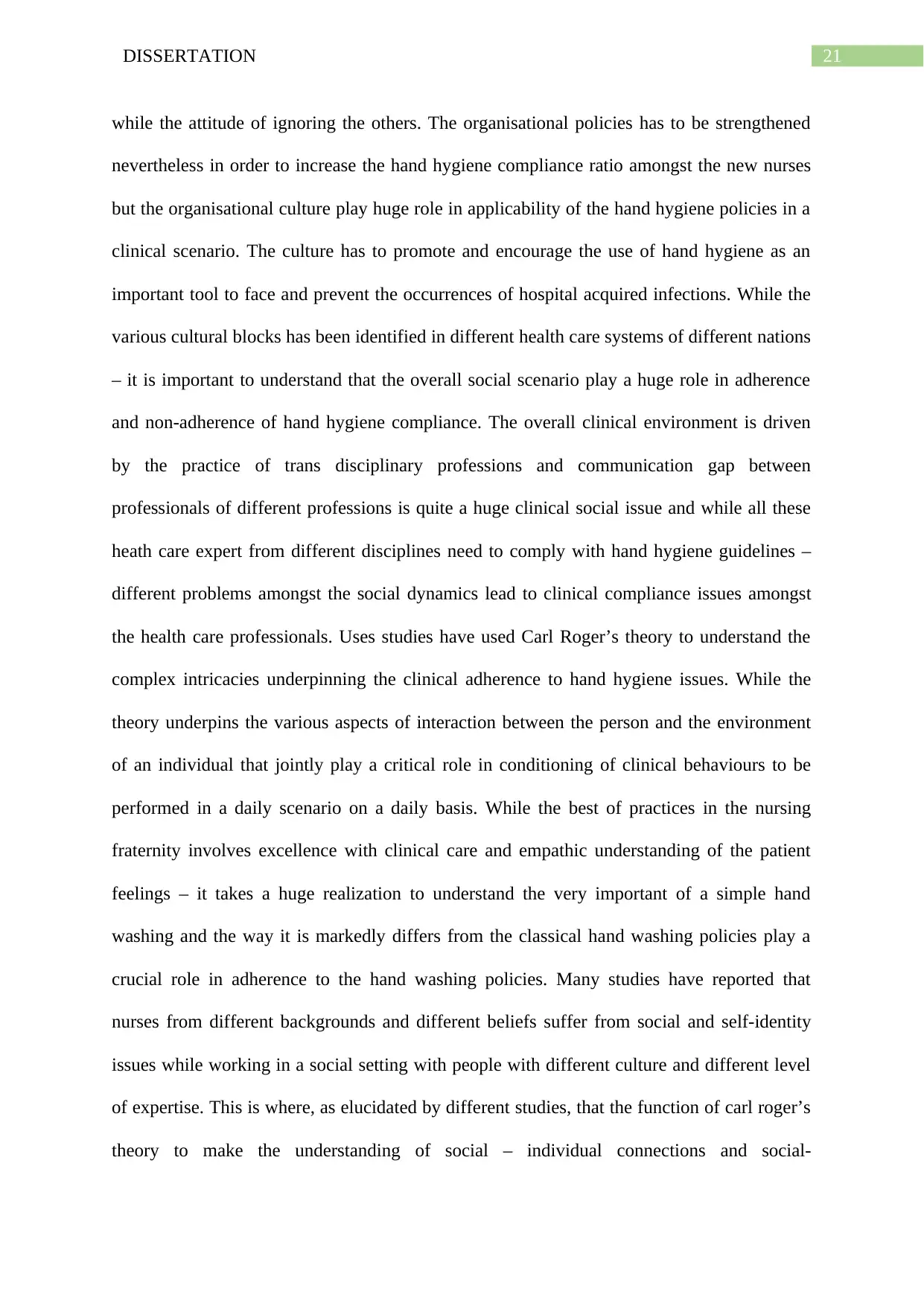
21DISSERTATION
while the attitude of ignoring the others. The organisational policies has to be strengthened
nevertheless in order to increase the hand hygiene compliance ratio amongst the new nurses
but the organisational culture play huge role in applicability of the hand hygiene policies in a
clinical scenario. The culture has to promote and encourage the use of hand hygiene as an
important tool to face and prevent the occurrences of hospital acquired infections. While the
various cultural blocks has been identified in different health care systems of different nations
– it is important to understand that the overall social scenario play a huge role in adherence
and non-adherence of hand hygiene compliance. The overall clinical environment is driven
by the practice of trans disciplinary professions and communication gap between
professionals of different professions is quite a huge clinical social issue and while all these
heath care expert from different disciplines need to comply with hand hygiene guidelines –
different problems amongst the social dynamics lead to clinical compliance issues amongst
the health care professionals. Uses studies have used Carl Roger’s theory to understand the
complex intricacies underpinning the clinical adherence to hand hygiene issues. While the
theory underpins the various aspects of interaction between the person and the environment
of an individual that jointly play a critical role in conditioning of clinical behaviours to be
performed in a daily scenario on a daily basis. While the best of practices in the nursing
fraternity involves excellence with clinical care and empathic understanding of the patient
feelings – it takes a huge realization to understand the very important of a simple hand
washing and the way it is markedly differs from the classical hand washing policies play a
crucial role in adherence to the hand washing policies. Many studies have reported that
nurses from different backgrounds and different beliefs suffer from social and self-identity
issues while working in a social setting with people with different culture and different level
of expertise. This is where, as elucidated by different studies, that the function of carl roger’s
theory to make the understanding of social – individual connections and social-
while the attitude of ignoring the others. The organisational policies has to be strengthened
nevertheless in order to increase the hand hygiene compliance ratio amongst the new nurses
but the organisational culture play huge role in applicability of the hand hygiene policies in a
clinical scenario. The culture has to promote and encourage the use of hand hygiene as an
important tool to face and prevent the occurrences of hospital acquired infections. While the
various cultural blocks has been identified in different health care systems of different nations
– it is important to understand that the overall social scenario play a huge role in adherence
and non-adherence of hand hygiene compliance. The overall clinical environment is driven
by the practice of trans disciplinary professions and communication gap between
professionals of different professions is quite a huge clinical social issue and while all these
heath care expert from different disciplines need to comply with hand hygiene guidelines –
different problems amongst the social dynamics lead to clinical compliance issues amongst
the health care professionals. Uses studies have used Carl Roger’s theory to understand the
complex intricacies underpinning the clinical adherence to hand hygiene issues. While the
theory underpins the various aspects of interaction between the person and the environment
of an individual that jointly play a critical role in conditioning of clinical behaviours to be
performed in a daily scenario on a daily basis. While the best of practices in the nursing
fraternity involves excellence with clinical care and empathic understanding of the patient
feelings – it takes a huge realization to understand the very important of a simple hand
washing and the way it is markedly differs from the classical hand washing policies play a
crucial role in adherence to the hand washing policies. Many studies have reported that
nurses from different backgrounds and different beliefs suffer from social and self-identity
issues while working in a social setting with people with different culture and different level
of expertise. This is where, as elucidated by different studies, that the function of carl roger’s
theory to make the understanding of social – individual connections and social-
Secure Best Marks with AI Grader
Need help grading? Try our AI Grader for instant feedback on your assignments.
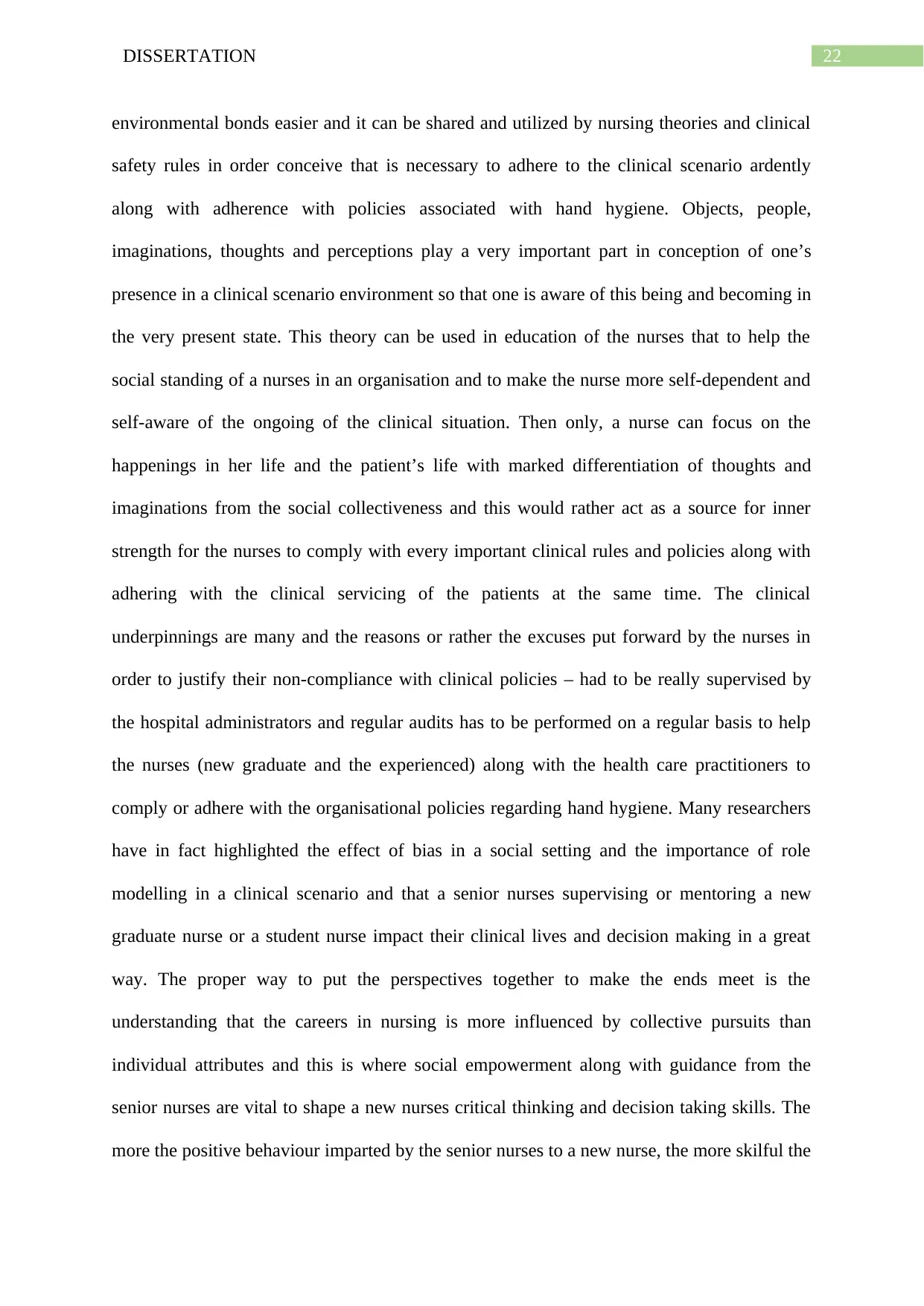
22DISSERTATION
environmental bonds easier and it can be shared and utilized by nursing theories and clinical
safety rules in order conceive that is necessary to adhere to the clinical scenario ardently
along with adherence with policies associated with hand hygiene. Objects, people,
imaginations, thoughts and perceptions play a very important part in conception of one’s
presence in a clinical scenario environment so that one is aware of this being and becoming in
the very present state. This theory can be used in education of the nurses that to help the
social standing of a nurses in an organisation and to make the nurse more self-dependent and
self-aware of the ongoing of the clinical situation. Then only, a nurse can focus on the
happenings in her life and the patient’s life with marked differentiation of thoughts and
imaginations from the social collectiveness and this would rather act as a source for inner
strength for the nurses to comply with every important clinical rules and policies along with
adhering with the clinical servicing of the patients at the same time. The clinical
underpinnings are many and the reasons or rather the excuses put forward by the nurses in
order to justify their non-compliance with clinical policies – had to be really supervised by
the hospital administrators and regular audits has to be performed on a regular basis to help
the nurses (new graduate and the experienced) along with the health care practitioners to
comply or adhere with the organisational policies regarding hand hygiene. Many researchers
have in fact highlighted the effect of bias in a social setting and the importance of role
modelling in a clinical scenario and that a senior nurses supervising or mentoring a new
graduate nurse or a student nurse impact their clinical lives and decision making in a great
way. The proper way to put the perspectives together to make the ends meet is the
understanding that the careers in nursing is more influenced by collective pursuits than
individual attributes and this is where social empowerment along with guidance from the
senior nurses are vital to shape a new nurses critical thinking and decision taking skills. The
more the positive behaviour imparted by the senior nurses to a new nurse, the more skilful the
environmental bonds easier and it can be shared and utilized by nursing theories and clinical
safety rules in order conceive that is necessary to adhere to the clinical scenario ardently
along with adherence with policies associated with hand hygiene. Objects, people,
imaginations, thoughts and perceptions play a very important part in conception of one’s
presence in a clinical scenario environment so that one is aware of this being and becoming in
the very present state. This theory can be used in education of the nurses that to help the
social standing of a nurses in an organisation and to make the nurse more self-dependent and
self-aware of the ongoing of the clinical situation. Then only, a nurse can focus on the
happenings in her life and the patient’s life with marked differentiation of thoughts and
imaginations from the social collectiveness and this would rather act as a source for inner
strength for the nurses to comply with every important clinical rules and policies along with
adhering with the clinical servicing of the patients at the same time. The clinical
underpinnings are many and the reasons or rather the excuses put forward by the nurses in
order to justify their non-compliance with clinical policies – had to be really supervised by
the hospital administrators and regular audits has to be performed on a regular basis to help
the nurses (new graduate and the experienced) along with the health care practitioners to
comply or adhere with the organisational policies regarding hand hygiene. Many researchers
have in fact highlighted the effect of bias in a social setting and the importance of role
modelling in a clinical scenario and that a senior nurses supervising or mentoring a new
graduate nurse or a student nurse impact their clinical lives and decision making in a great
way. The proper way to put the perspectives together to make the ends meet is the
understanding that the careers in nursing is more influenced by collective pursuits than
individual attributes and this is where social empowerment along with guidance from the
senior nurses are vital to shape a new nurses critical thinking and decision taking skills. The
more the positive behaviour imparted by the senior nurses to a new nurse, the more skilful the
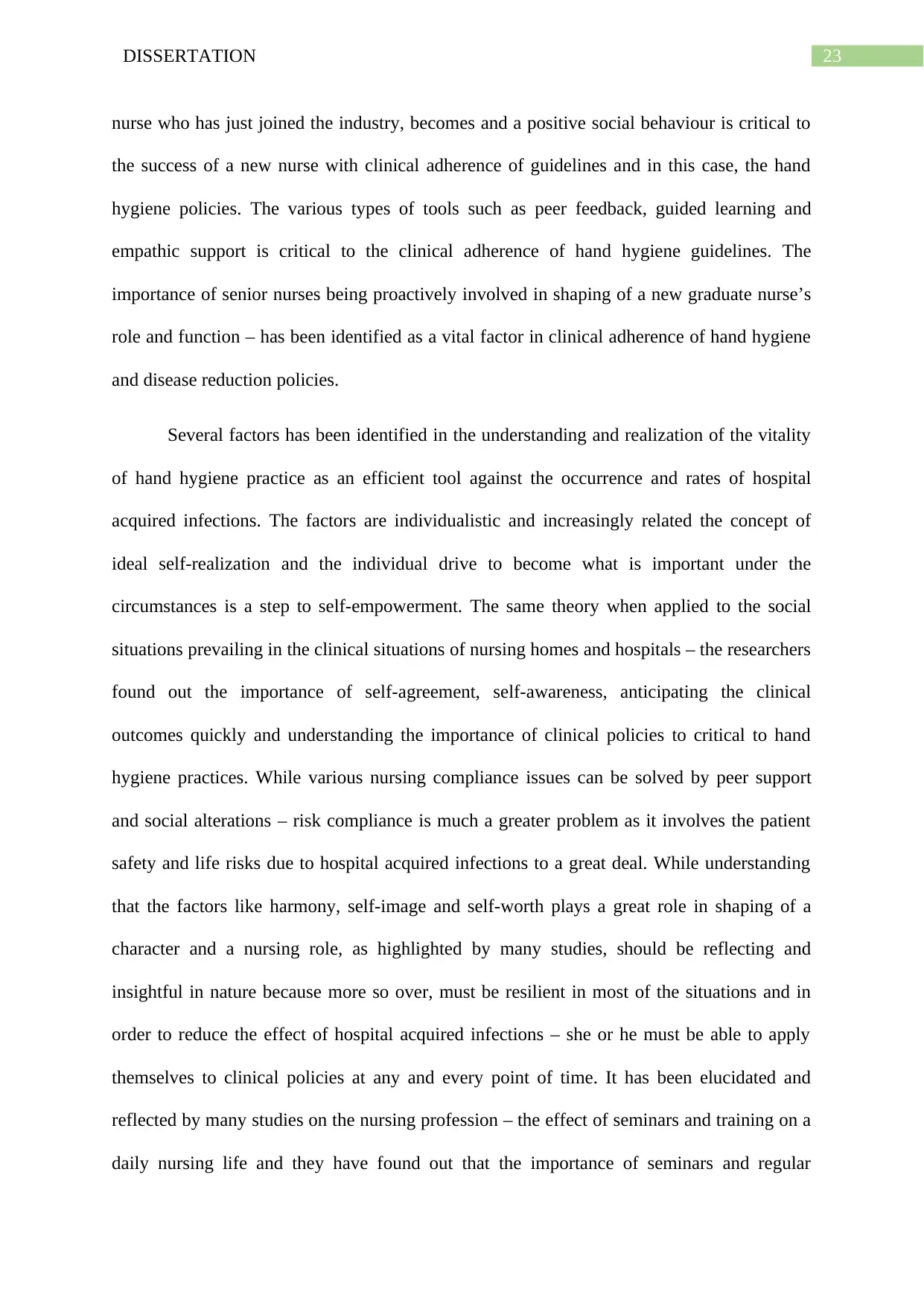
23DISSERTATION
nurse who has just joined the industry, becomes and a positive social behaviour is critical to
the success of a new nurse with clinical adherence of guidelines and in this case, the hand
hygiene policies. The various types of tools such as peer feedback, guided learning and
empathic support is critical to the clinical adherence of hand hygiene guidelines. The
importance of senior nurses being proactively involved in shaping of a new graduate nurse’s
role and function – has been identified as a vital factor in clinical adherence of hand hygiene
and disease reduction policies.
Several factors has been identified in the understanding and realization of the vitality
of hand hygiene practice as an efficient tool against the occurrence and rates of hospital
acquired infections. The factors are individualistic and increasingly related the concept of
ideal self-realization and the individual drive to become what is important under the
circumstances is a step to self-empowerment. The same theory when applied to the social
situations prevailing in the clinical situations of nursing homes and hospitals – the researchers
found out the importance of self-agreement, self-awareness, anticipating the clinical
outcomes quickly and understanding the importance of clinical policies to critical to hand
hygiene practices. While various nursing compliance issues can be solved by peer support
and social alterations – risk compliance is much a greater problem as it involves the patient
safety and life risks due to hospital acquired infections to a great deal. While understanding
that the factors like harmony, self-image and self-worth plays a great role in shaping of a
character and a nursing role, as highlighted by many studies, should be reflecting and
insightful in nature because more so over, must be resilient in most of the situations and in
order to reduce the effect of hospital acquired infections – she or he must be able to apply
themselves to clinical policies at any and every point of time. It has been elucidated and
reflected by many studies on the nursing profession – the effect of seminars and training on a
daily nursing life and they have found out that the importance of seminars and regular
nurse who has just joined the industry, becomes and a positive social behaviour is critical to
the success of a new nurse with clinical adherence of guidelines and in this case, the hand
hygiene policies. The various types of tools such as peer feedback, guided learning and
empathic support is critical to the clinical adherence of hand hygiene guidelines. The
importance of senior nurses being proactively involved in shaping of a new graduate nurse’s
role and function – has been identified as a vital factor in clinical adherence of hand hygiene
and disease reduction policies.
Several factors has been identified in the understanding and realization of the vitality
of hand hygiene practice as an efficient tool against the occurrence and rates of hospital
acquired infections. The factors are individualistic and increasingly related the concept of
ideal self-realization and the individual drive to become what is important under the
circumstances is a step to self-empowerment. The same theory when applied to the social
situations prevailing in the clinical situations of nursing homes and hospitals – the researchers
found out the importance of self-agreement, self-awareness, anticipating the clinical
outcomes quickly and understanding the importance of clinical policies to critical to hand
hygiene practices. While various nursing compliance issues can be solved by peer support
and social alterations – risk compliance is much a greater problem as it involves the patient
safety and life risks due to hospital acquired infections to a great deal. While understanding
that the factors like harmony, self-image and self-worth plays a great role in shaping of a
character and a nursing role, as highlighted by many studies, should be reflecting and
insightful in nature because more so over, must be resilient in most of the situations and in
order to reduce the effect of hospital acquired infections – she or he must be able to apply
themselves to clinical policies at any and every point of time. It has been elucidated and
reflected by many studies on the nursing profession – the effect of seminars and training on a
daily nursing life and they have found out that the importance of seminars and regular

24DISSERTATION
seminars holds a greater effect than the classical education of the nurses. May researchers has
promoted the idea of more seminars and workshops being used in educating the new and
experienced nurses about hand hygiene are far more effective than the curriculum based
learning in a college study framework. The studies in the scope of the college in the nursing
profession involve more theoretical work and the compliance with hand hygiene protocols
require more practical based approach and this gap between the theoretical and the practical
approaches are often very conflicting and far reaching. Hence, audio video seminars and
workshops in the promotion of nursing education is far more effective when it comes to
complying with the intricacies of hand hygiene policies and regulations. The important of
experiential learning has been highlighted across different studies and researches performed
in different nations – has focussed on the same thing. Audio video format of learning is more
experiential than theoretical studies and as medical and nursing approach are completely
practical based – there is a growing need of real time experiences amongst the nursing
professionals regarding the correct usage of hand hygiene and hash washing protocols. If the
technology support is important in training and regular audit of the nursing compliance with
hand cleaning policies, it is also very important that the technologies are also used in
pertaining to the direction and guidance to daily hand hygiene procedures. The idea put
forward by different researches – is that the hand hygiene practices amongst the new nurses
and the experienced senior nurses should be made mandatory and regular support must be
provided to these nurses to comply with hand hygiene guidelines and after a set or period of
repetitive practices, the learning becomes experiential itself and help an nursing individual
comply with hand hygiene guidelines, in an automated way. Hence, most of the support has
to be provided in the initial phase of individual learning, thus contributing to personal growth
and patient safety as in whole. This study focusses to understand the uninspected and
inspected areas of nursing and health care researches, from different perspectives and aspects
seminars holds a greater effect than the classical education of the nurses. May researchers has
promoted the idea of more seminars and workshops being used in educating the new and
experienced nurses about hand hygiene are far more effective than the curriculum based
learning in a college study framework. The studies in the scope of the college in the nursing
profession involve more theoretical work and the compliance with hand hygiene protocols
require more practical based approach and this gap between the theoretical and the practical
approaches are often very conflicting and far reaching. Hence, audio video seminars and
workshops in the promotion of nursing education is far more effective when it comes to
complying with the intricacies of hand hygiene policies and regulations. The important of
experiential learning has been highlighted across different studies and researches performed
in different nations – has focussed on the same thing. Audio video format of learning is more
experiential than theoretical studies and as medical and nursing approach are completely
practical based – there is a growing need of real time experiences amongst the nursing
professionals regarding the correct usage of hand hygiene and hash washing protocols. If the
technology support is important in training and regular audit of the nursing compliance with
hand cleaning policies, it is also very important that the technologies are also used in
pertaining to the direction and guidance to daily hand hygiene procedures. The idea put
forward by different researches – is that the hand hygiene practices amongst the new nurses
and the experienced senior nurses should be made mandatory and regular support must be
provided to these nurses to comply with hand hygiene guidelines and after a set or period of
repetitive practices, the learning becomes experiential itself and help an nursing individual
comply with hand hygiene guidelines, in an automated way. Hence, most of the support has
to be provided in the initial phase of individual learning, thus contributing to personal growth
and patient safety as in whole. This study focusses to understand the uninspected and
inspected areas of nursing and health care researches, from different perspectives and aspects
Paraphrase This Document
Need a fresh take? Get an instant paraphrase of this document with our AI Paraphraser

25DISSERTATION
so as to explore in to new horizons of questioning and reasoning with compliance issues with
hand hygiene policies and guidelines and how different academic and educational supports
are helpful in solving these compliance issues with a better insight and inputs. In any case,
adherence to hand hygiene policies focus on personal development nursing skill sets and
professional traits.
The Improvement
The WHO's immediate observation structure depends on "My Five Moments for HH"
that comprises of the accompanying: before patient contact, before aseptic strategy
(Shobowale, Adegunle and Onyedibe 2016). The observational techniques are included in the
clinical framework in order to improve the compliance with hand hygiene guidelines amongst
the new graduate nurses. This intervention of clinical improvement with respect to the
association of hospital acquired infections and hand hygiene will communicate to each and
every healthcare practitioner through the seminar and workshops. A major outcome of this is
that this knowledge will be imparted to the new graduate nurses as well as to the experienced
nurses so that they can comply with the hand hygiene guidelines even at the most difficult of
situations. Different nations with system of health care and facilities – have planned the right
and differential ventures that they have run in form of hand hygiene education projects and
the nurses in many hospitals have gone through training and educational transformations in a
practical and theoretical aspect. Therefore, the organisations must take up approaches to
shape the clinical knowledge of nurses. The outcome of this is that it will improve their
personal skills in a clinical scenario. Apart from that, these educational transformations will
also change the practical and theoretical aspect.
Hand hygiene compliance is an important aspect of hospital policies and it is very
critical that the proper amount of training and education is provided on a priority basis and
so as to explore in to new horizons of questioning and reasoning with compliance issues with
hand hygiene policies and guidelines and how different academic and educational supports
are helpful in solving these compliance issues with a better insight and inputs. In any case,
adherence to hand hygiene policies focus on personal development nursing skill sets and
professional traits.
The Improvement
The WHO's immediate observation structure depends on "My Five Moments for HH"
that comprises of the accompanying: before patient contact, before aseptic strategy
(Shobowale, Adegunle and Onyedibe 2016). The observational techniques are included in the
clinical framework in order to improve the compliance with hand hygiene guidelines amongst
the new graduate nurses. This intervention of clinical improvement with respect to the
association of hospital acquired infections and hand hygiene will communicate to each and
every healthcare practitioner through the seminar and workshops. A major outcome of this is
that this knowledge will be imparted to the new graduate nurses as well as to the experienced
nurses so that they can comply with the hand hygiene guidelines even at the most difficult of
situations. Different nations with system of health care and facilities – have planned the right
and differential ventures that they have run in form of hand hygiene education projects and
the nurses in many hospitals have gone through training and educational transformations in a
practical and theoretical aspect. Therefore, the organisations must take up approaches to
shape the clinical knowledge of nurses. The outcome of this is that it will improve their
personal skills in a clinical scenario. Apart from that, these educational transformations will
also change the practical and theoretical aspect.
Hand hygiene compliance is an important aspect of hospital policies and it is very
critical that the proper amount of training and education is provided on a priority basis and
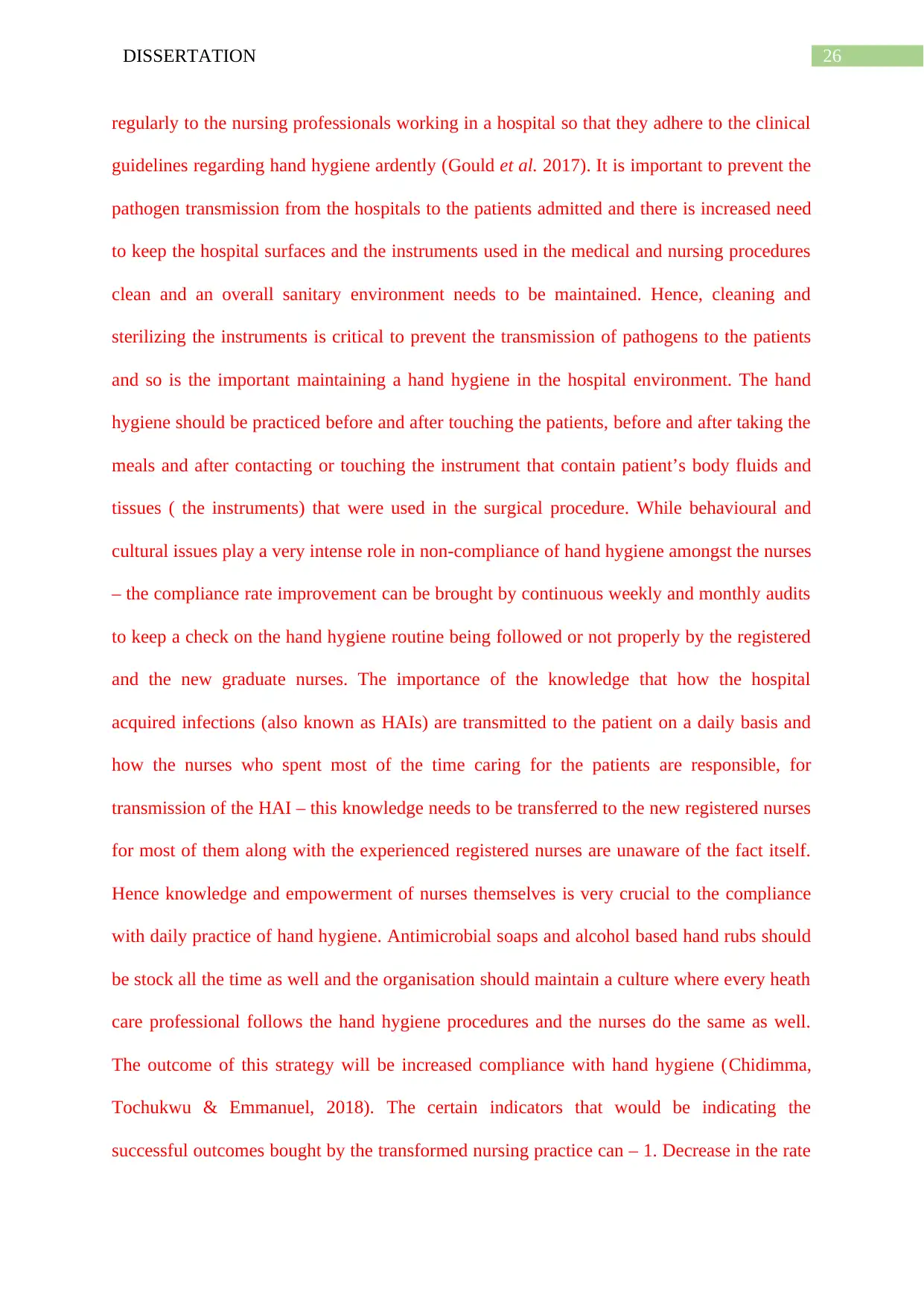
26DISSERTATION
regularly to the nursing professionals working in a hospital so that they adhere to the clinical
guidelines regarding hand hygiene ardently (Gould et al. 2017). It is important to prevent the
pathogen transmission from the hospitals to the patients admitted and there is increased need
to keep the hospital surfaces and the instruments used in the medical and nursing procedures
clean and an overall sanitary environment needs to be maintained. Hence, cleaning and
sterilizing the instruments is critical to prevent the transmission of pathogens to the patients
and so is the important maintaining a hand hygiene in the hospital environment. The hand
hygiene should be practiced before and after touching the patients, before and after taking the
meals and after contacting or touching the instrument that contain patient’s body fluids and
tissues ( the instruments) that were used in the surgical procedure. While behavioural and
cultural issues play a very intense role in non-compliance of hand hygiene amongst the nurses
– the compliance rate improvement can be brought by continuous weekly and monthly audits
to keep a check on the hand hygiene routine being followed or not properly by the registered
and the new graduate nurses. The importance of the knowledge that how the hospital
acquired infections (also known as HAIs) are transmitted to the patient on a daily basis and
how the nurses who spent most of the time caring for the patients are responsible, for
transmission of the HAI – this knowledge needs to be transferred to the new registered nurses
for most of them along with the experienced registered nurses are unaware of the fact itself.
Hence knowledge and empowerment of nurses themselves is very crucial to the compliance
with daily practice of hand hygiene. Antimicrobial soaps and alcohol based hand rubs should
be stock all the time as well and the organisation should maintain a culture where every heath
care professional follows the hand hygiene procedures and the nurses do the same as well.
The outcome of this strategy will be increased compliance with hand hygiene (Chidimma,
Tochukwu & Emmanuel, 2018). The certain indicators that would be indicating the
successful outcomes bought by the transformed nursing practice can – 1. Decrease in the rate
regularly to the nursing professionals working in a hospital so that they adhere to the clinical
guidelines regarding hand hygiene ardently (Gould et al. 2017). It is important to prevent the
pathogen transmission from the hospitals to the patients admitted and there is increased need
to keep the hospital surfaces and the instruments used in the medical and nursing procedures
clean and an overall sanitary environment needs to be maintained. Hence, cleaning and
sterilizing the instruments is critical to prevent the transmission of pathogens to the patients
and so is the important maintaining a hand hygiene in the hospital environment. The hand
hygiene should be practiced before and after touching the patients, before and after taking the
meals and after contacting or touching the instrument that contain patient’s body fluids and
tissues ( the instruments) that were used in the surgical procedure. While behavioural and
cultural issues play a very intense role in non-compliance of hand hygiene amongst the nurses
– the compliance rate improvement can be brought by continuous weekly and monthly audits
to keep a check on the hand hygiene routine being followed or not properly by the registered
and the new graduate nurses. The importance of the knowledge that how the hospital
acquired infections (also known as HAIs) are transmitted to the patient on a daily basis and
how the nurses who spent most of the time caring for the patients are responsible, for
transmission of the HAI – this knowledge needs to be transferred to the new registered nurses
for most of them along with the experienced registered nurses are unaware of the fact itself.
Hence knowledge and empowerment of nurses themselves is very crucial to the compliance
with daily practice of hand hygiene. Antimicrobial soaps and alcohol based hand rubs should
be stock all the time as well and the organisation should maintain a culture where every heath
care professional follows the hand hygiene procedures and the nurses do the same as well.
The outcome of this strategy will be increased compliance with hand hygiene (Chidimma,
Tochukwu & Emmanuel, 2018). The certain indicators that would be indicating the
successful outcomes bought by the transformed nursing practice can – 1. Decrease in the rate
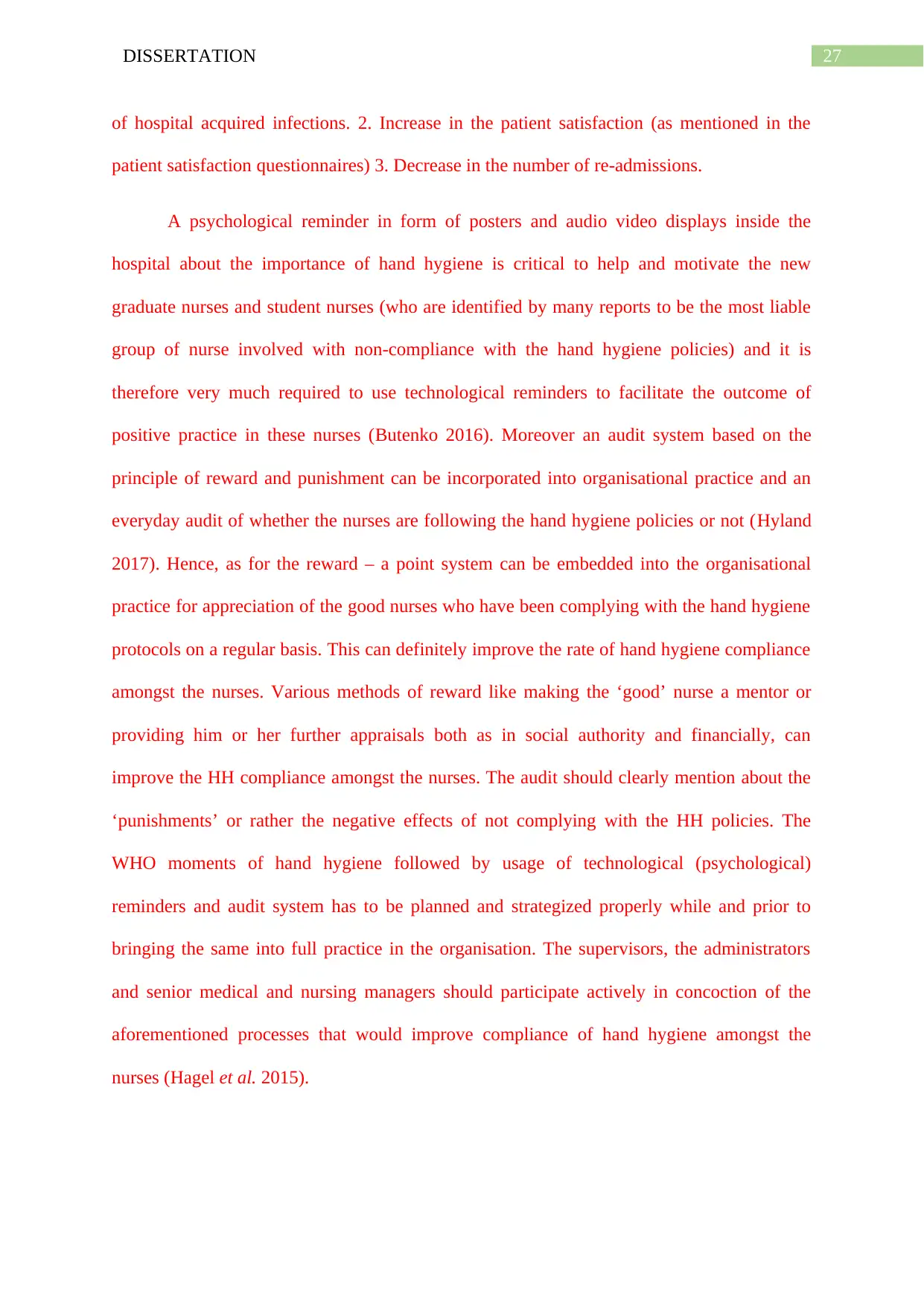
27DISSERTATION
of hospital acquired infections. 2. Increase in the patient satisfaction (as mentioned in the
patient satisfaction questionnaires) 3. Decrease in the number of re-admissions.
A psychological reminder in form of posters and audio video displays inside the
hospital about the importance of hand hygiene is critical to help and motivate the new
graduate nurses and student nurses (who are identified by many reports to be the most liable
group of nurse involved with non-compliance with the hand hygiene policies) and it is
therefore very much required to use technological reminders to facilitate the outcome of
positive practice in these nurses (Butenko 2016). Moreover an audit system based on the
principle of reward and punishment can be incorporated into organisational practice and an
everyday audit of whether the nurses are following the hand hygiene policies or not (Hyland
2017). Hence, as for the reward – a point system can be embedded into the organisational
practice for appreciation of the good nurses who have been complying with the hand hygiene
protocols on a regular basis. This can definitely improve the rate of hand hygiene compliance
amongst the nurses. Various methods of reward like making the ‘good’ nurse a mentor or
providing him or her further appraisals both as in social authority and financially, can
improve the HH compliance amongst the nurses. The audit should clearly mention about the
‘punishments’ or rather the negative effects of not complying with the HH policies. The
WHO moments of hand hygiene followed by usage of technological (psychological)
reminders and audit system has to be planned and strategized properly while and prior to
bringing the same into full practice in the organisation. The supervisors, the administrators
and senior medical and nursing managers should participate actively in concoction of the
aforementioned processes that would improve compliance of hand hygiene amongst the
nurses (Hagel et al. 2015).
of hospital acquired infections. 2. Increase in the patient satisfaction (as mentioned in the
patient satisfaction questionnaires) 3. Decrease in the number of re-admissions.
A psychological reminder in form of posters and audio video displays inside the
hospital about the importance of hand hygiene is critical to help and motivate the new
graduate nurses and student nurses (who are identified by many reports to be the most liable
group of nurse involved with non-compliance with the hand hygiene policies) and it is
therefore very much required to use technological reminders to facilitate the outcome of
positive practice in these nurses (Butenko 2016). Moreover an audit system based on the
principle of reward and punishment can be incorporated into organisational practice and an
everyday audit of whether the nurses are following the hand hygiene policies or not (Hyland
2017). Hence, as for the reward – a point system can be embedded into the organisational
practice for appreciation of the good nurses who have been complying with the hand hygiene
protocols on a regular basis. This can definitely improve the rate of hand hygiene compliance
amongst the nurses. Various methods of reward like making the ‘good’ nurse a mentor or
providing him or her further appraisals both as in social authority and financially, can
improve the HH compliance amongst the nurses. The audit should clearly mention about the
‘punishments’ or rather the negative effects of not complying with the HH policies. The
WHO moments of hand hygiene followed by usage of technological (psychological)
reminders and audit system has to be planned and strategized properly while and prior to
bringing the same into full practice in the organisation. The supervisors, the administrators
and senior medical and nursing managers should participate actively in concoction of the
aforementioned processes that would improve compliance of hand hygiene amongst the
nurses (Hagel et al. 2015).
Secure Best Marks with AI Grader
Need help grading? Try our AI Grader for instant feedback on your assignments.
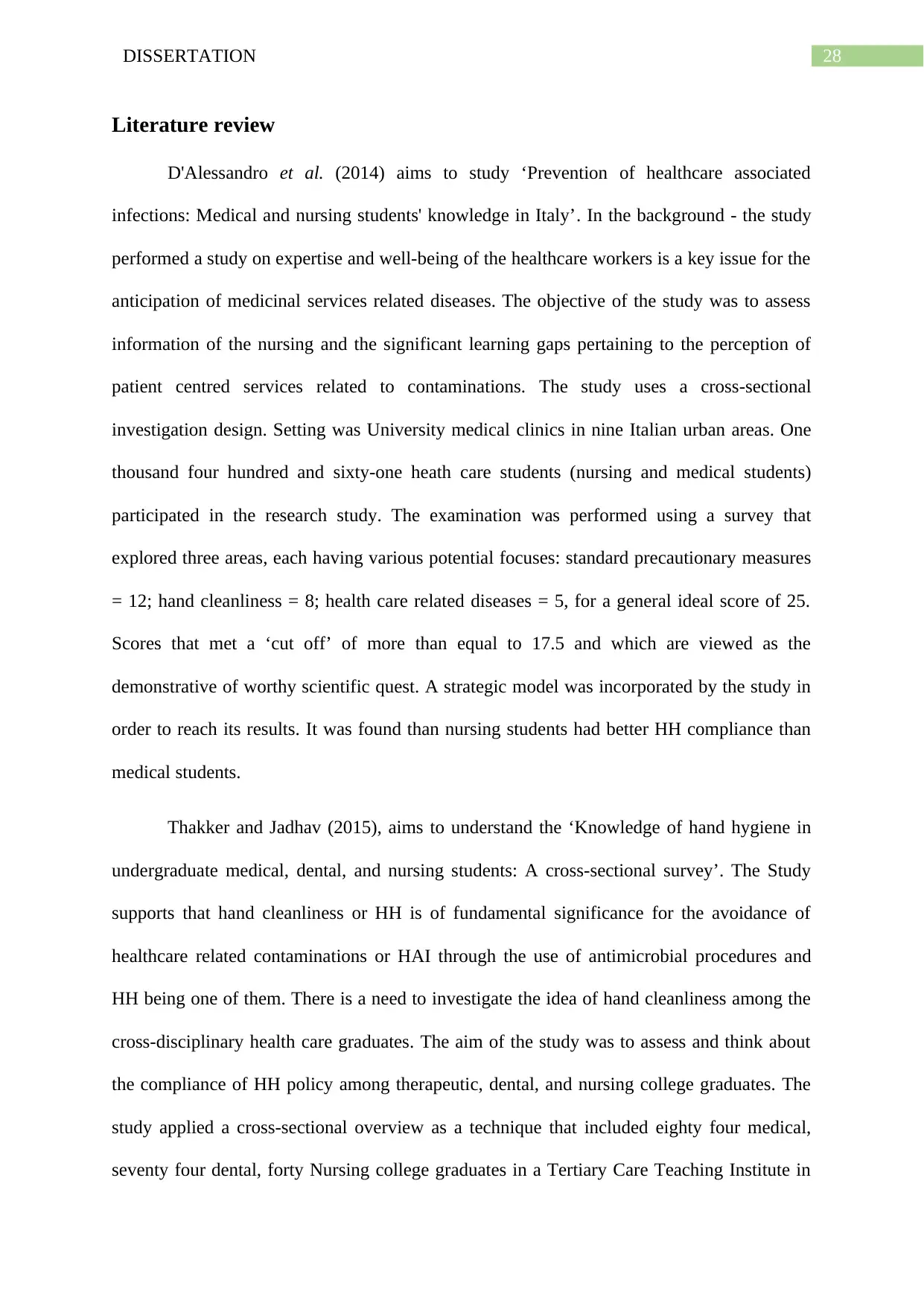
28DISSERTATION
Literature review
D'Alessandro et al. (2014) aims to study ‘Prevention of healthcare associated
infections: Medical and nursing students' knowledge in Italy’. In the background - the study
performed a study on expertise and well-being of the healthcare workers is a key issue for the
anticipation of medicinal services related diseases. The objective of the study was to assess
information of the nursing and the significant learning gaps pertaining to the perception of
patient centred services related to contaminations. The study uses a cross-sectional
investigation design. Setting was University medical clinics in nine Italian urban areas. One
thousand four hundred and sixty-one heath care students (nursing and medical students)
participated in the research study. The examination was performed using a survey that
explored three areas, each having various potential focuses: standard precautionary measures
= 12; hand cleanliness = 8; health care related diseases = 5, for a general ideal score of 25.
Scores that met a ‘cut off’ of more than equal to 17.5 and which are viewed as the
demonstrative of worthy scientific quest. A strategic model was incorporated by the study in
order to reach its results. It was found than nursing students had better HH compliance than
medical students.
Thakker and Jadhav (2015), aims to understand the ‘Knowledge of hand hygiene in
undergraduate medical, dental, and nursing students: A cross-sectional survey’. The Study
supports that hand cleanliness or HH is of fundamental significance for the avoidance of
healthcare related contaminations or HAI through the use of antimicrobial procedures and
HH being one of them. There is a need to investigate the idea of hand cleanliness among the
cross-disciplinary health care graduates. The aim of the study was to assess and think about
the compliance of HH policy among therapeutic, dental, and nursing college graduates. The
study applied a cross-sectional overview as a technique that included eighty four medical,
seventy four dental, forty Nursing college graduates in a Tertiary Care Teaching Institute in
Literature review
D'Alessandro et al. (2014) aims to study ‘Prevention of healthcare associated
infections: Medical and nursing students' knowledge in Italy’. In the background - the study
performed a study on expertise and well-being of the healthcare workers is a key issue for the
anticipation of medicinal services related diseases. The objective of the study was to assess
information of the nursing and the significant learning gaps pertaining to the perception of
patient centred services related to contaminations. The study uses a cross-sectional
investigation design. Setting was University medical clinics in nine Italian urban areas. One
thousand four hundred and sixty-one heath care students (nursing and medical students)
participated in the research study. The examination was performed using a survey that
explored three areas, each having various potential focuses: standard precautionary measures
= 12; hand cleanliness = 8; health care related diseases = 5, for a general ideal score of 25.
Scores that met a ‘cut off’ of more than equal to 17.5 and which are viewed as the
demonstrative of worthy scientific quest. A strategic model was incorporated by the study in
order to reach its results. It was found than nursing students had better HH compliance than
medical students.
Thakker and Jadhav (2015), aims to understand the ‘Knowledge of hand hygiene in
undergraduate medical, dental, and nursing students: A cross-sectional survey’. The Study
supports that hand cleanliness or HH is of fundamental significance for the avoidance of
healthcare related contaminations or HAI through the use of antimicrobial procedures and
HH being one of them. There is a need to investigate the idea of hand cleanliness among the
cross-disciplinary health care graduates. The aim of the study was to assess and think about
the compliance of HH policy among therapeutic, dental, and nursing college graduates. The
study applied a cross-sectional overview as a technique that included eighty four medical,
seventy four dental, forty Nursing college graduates in a Tertiary Care Teaching Institute in

29DISSERTATION
Navi Mumbai of India. Information was evaluated utilizing the World Health Organization
HH survey. The scores for each were determined and examined then. The scores were
additionally reviewed as low, high and moderate. The study found out that about 7.5% of the
medical and nursing care members had great learning with respect to hand cleanliness and
HH while the higher part (that is 69.1%) showed moderate knowledge about HH. The
medical graduates hand hygiene knowledge was fundamentally (P < 0.01) higher than that of
dental and nursing undergraduates. But in practice, the research inferred that low scores were
achieved by undergrad medical graduates require that require increased compliance with HH
and safety instruction, conduct as compared to the nursing professional personal skill
development with educational plans was implied. The keywords used were Dental, hand
cleanliness in medicinal, nursing graduates.
Randle et al. (2014) aims to study ‘An observational study of hand hygiene adherence
following the introduction of an education intervention’. Hand hygiene or HH adherence
should be increased with better policies, as shown by the research and supported so as to
forestall and lessen the hospital acquired infections. The study actualized an instructive
education and pointed out the adherence of health care workforce, patients and guests to HH
guidelines. For nurses, a sum of 2,294 opportunities were revealed by the study and for
patients and hospital visitors, an aggregate of nearly 597 opportunities were found. The study
supported compliance and training as the best tool for adherence to HH guidelines.
Hinkin and Cutter (2014) aims to study ‘How do university education and clinical
experience influence pre-registration nursing students' infection control practice? A
descriptive, cross sectional survey’. The aim of this study was to investigate the new nursing
graduates' learning of disease control and explore how educational instructions and clinical
experience impact their contamination control practice in regards to the HAI. In order to
counteract the control of health service related diseases all health care services staffs must be
Navi Mumbai of India. Information was evaluated utilizing the World Health Organization
HH survey. The scores for each were determined and examined then. The scores were
additionally reviewed as low, high and moderate. The study found out that about 7.5% of the
medical and nursing care members had great learning with respect to hand cleanliness and
HH while the higher part (that is 69.1%) showed moderate knowledge about HH. The
medical graduates hand hygiene knowledge was fundamentally (P < 0.01) higher than that of
dental and nursing undergraduates. But in practice, the research inferred that low scores were
achieved by undergrad medical graduates require that require increased compliance with HH
and safety instruction, conduct as compared to the nursing professional personal skill
development with educational plans was implied. The keywords used were Dental, hand
cleanliness in medicinal, nursing graduates.
Randle et al. (2014) aims to study ‘An observational study of hand hygiene adherence
following the introduction of an education intervention’. Hand hygiene or HH adherence
should be increased with better policies, as shown by the research and supported so as to
forestall and lessen the hospital acquired infections. The study actualized an instructive
education and pointed out the adherence of health care workforce, patients and guests to HH
guidelines. For nurses, a sum of 2,294 opportunities were revealed by the study and for
patients and hospital visitors, an aggregate of nearly 597 opportunities were found. The study
supported compliance and training as the best tool for adherence to HH guidelines.
Hinkin and Cutter (2014) aims to study ‘How do university education and clinical
experience influence pre-registration nursing students' infection control practice? A
descriptive, cross sectional survey’. The aim of this study was to investigate the new nursing
graduates' learning of disease control and explore how educational instructions and clinical
experience impact their contamination control practice in regards to the HAI. In order to
counteract the control of health service related diseases all health care services staffs must be
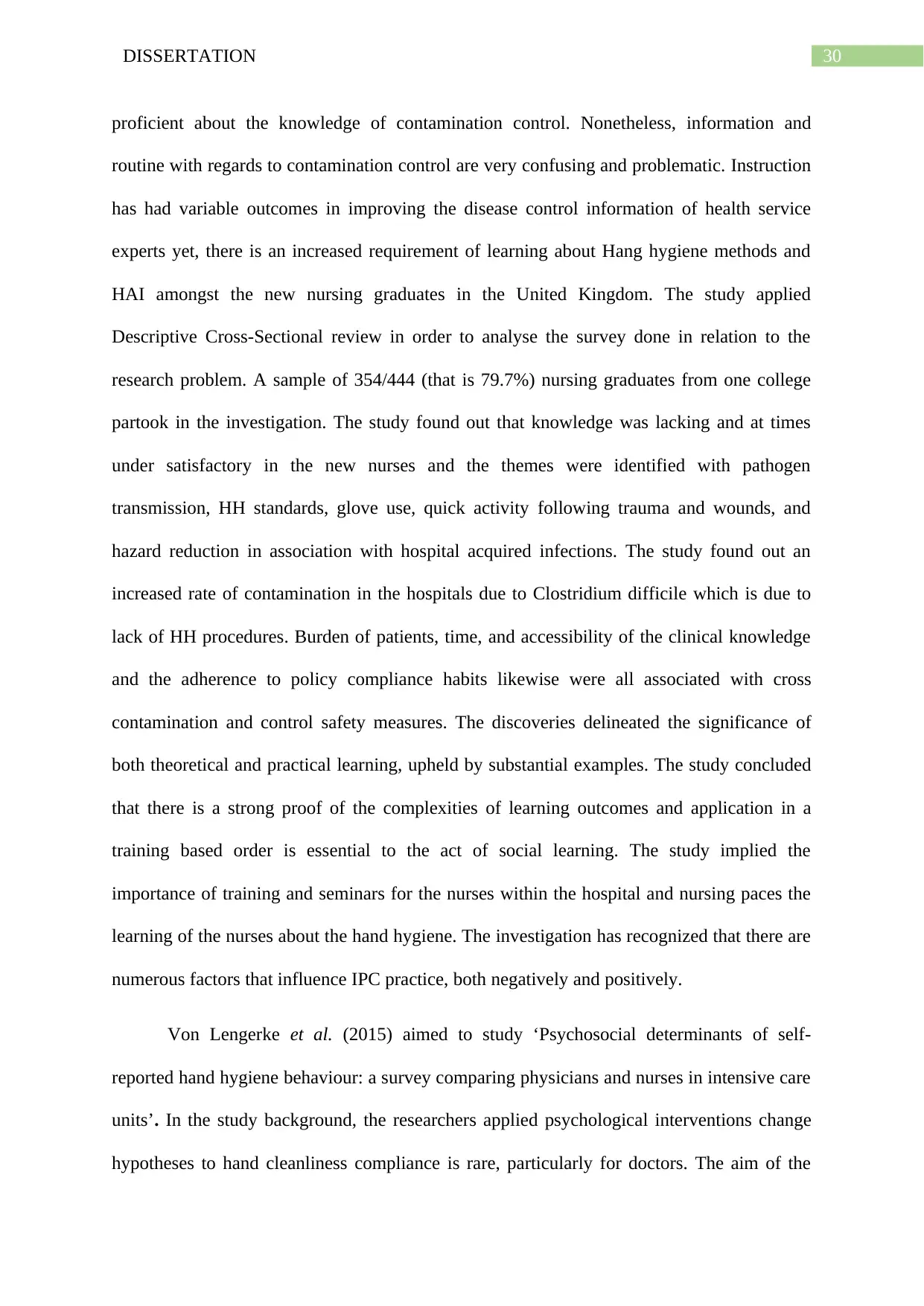
30DISSERTATION
proficient about the knowledge of contamination control. Nonetheless, information and
routine with regards to contamination control are very confusing and problematic. Instruction
has had variable outcomes in improving the disease control information of health service
experts yet, there is an increased requirement of learning about Hang hygiene methods and
HAI amongst the new nursing graduates in the United Kingdom. The study applied
Descriptive Cross-Sectional review in order to analyse the survey done in relation to the
research problem. A sample of 354/444 (that is 79.7%) nursing graduates from one college
partook in the investigation. The study found out that knowledge was lacking and at times
under satisfactory in the new nurses and the themes were identified with pathogen
transmission, HH standards, glove use, quick activity following trauma and wounds, and
hazard reduction in association with hospital acquired infections. The study found out an
increased rate of contamination in the hospitals due to Clostridium difficile which is due to
lack of HH procedures. Burden of patients, time, and accessibility of the clinical knowledge
and the adherence to policy compliance habits likewise were all associated with cross
contamination and control safety measures. The discoveries delineated the significance of
both theoretical and practical learning, upheld by substantial examples. The study concluded
that there is a strong proof of the complexities of learning outcomes and application in a
training based order is essential to the act of social learning. The study implied the
importance of training and seminars for the nurses within the hospital and nursing paces the
learning of the nurses about the hand hygiene. The investigation has recognized that there are
numerous factors that influence IPC practice, both negatively and positively.
Von Lengerke et al. (2015) aimed to study ‘Psychosocial determinants of self-
reported hand hygiene behaviour: a survey comparing physicians and nurses in intensive care
units’. In the study background, the researchers applied psychological interventions change
hypotheses to hand cleanliness compliance is rare, particularly for doctors. The aim of the
proficient about the knowledge of contamination control. Nonetheless, information and
routine with regards to contamination control are very confusing and problematic. Instruction
has had variable outcomes in improving the disease control information of health service
experts yet, there is an increased requirement of learning about Hang hygiene methods and
HAI amongst the new nursing graduates in the United Kingdom. The study applied
Descriptive Cross-Sectional review in order to analyse the survey done in relation to the
research problem. A sample of 354/444 (that is 79.7%) nursing graduates from one college
partook in the investigation. The study found out that knowledge was lacking and at times
under satisfactory in the new nurses and the themes were identified with pathogen
transmission, HH standards, glove use, quick activity following trauma and wounds, and
hazard reduction in association with hospital acquired infections. The study found out an
increased rate of contamination in the hospitals due to Clostridium difficile which is due to
lack of HH procedures. Burden of patients, time, and accessibility of the clinical knowledge
and the adherence to policy compliance habits likewise were all associated with cross
contamination and control safety measures. The discoveries delineated the significance of
both theoretical and practical learning, upheld by substantial examples. The study concluded
that there is a strong proof of the complexities of learning outcomes and application in a
training based order is essential to the act of social learning. The study implied the
importance of training and seminars for the nurses within the hospital and nursing paces the
learning of the nurses about the hand hygiene. The investigation has recognized that there are
numerous factors that influence IPC practice, both negatively and positively.
Von Lengerke et al. (2015) aimed to study ‘Psychosocial determinants of self-
reported hand hygiene behaviour: a survey comparing physicians and nurses in intensive care
units’. In the study background, the researchers applied psychological interventions change
hypotheses to hand cleanliness compliance is rare, particularly for doctors. The aim of the
Paraphrase This Document
Need a fresh take? Get an instant paraphrase of this document with our AI Paraphraser
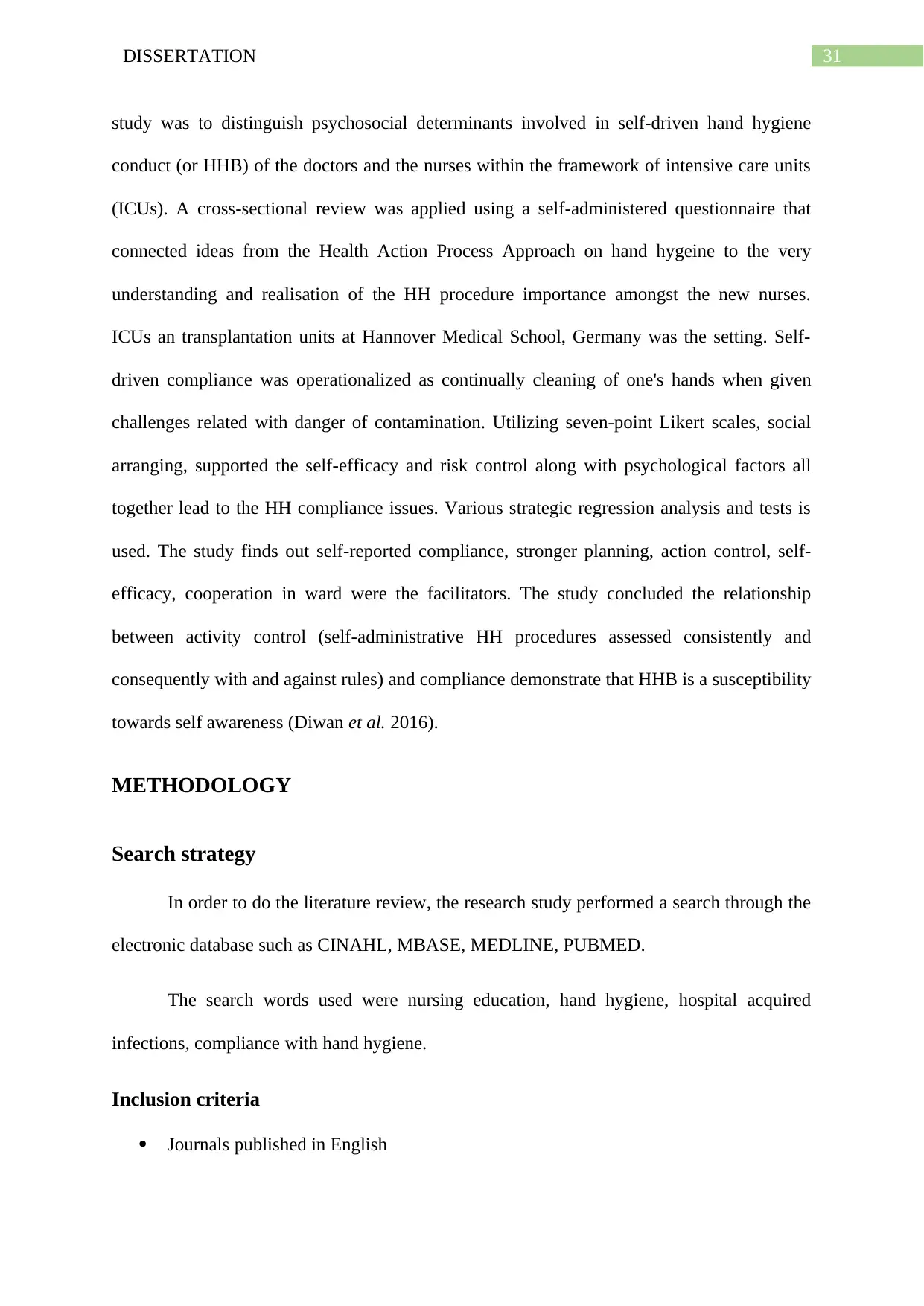
31DISSERTATION
study was to distinguish psychosocial determinants involved in self-driven hand hygiene
conduct (or HHB) of the doctors and the nurses within the framework of intensive care units
(ICUs). A cross-sectional review was applied using a self-administered questionnaire that
connected ideas from the Health Action Process Approach on hand hygeine to the very
understanding and realisation of the HH procedure importance amongst the new nurses.
ICUs an transplantation units at Hannover Medical School, Germany was the setting. Self-
driven compliance was operationalized as continually cleaning of one's hands when given
challenges related with danger of contamination. Utilizing seven-point Likert scales, social
arranging, supported the self-efficacy and risk control along with psychological factors all
together lead to the HH compliance issues. Various strategic regression analysis and tests is
used. The study finds out self-reported compliance, stronger planning, action control, self-
efficacy, cooperation in ward were the facilitators. The study concluded the relationship
between activity control (self-administrative HH procedures assessed consistently and
consequently with and against rules) and compliance demonstrate that HHB is a susceptibility
towards self awareness (Diwan et al. 2016).
METHODOLOGY
Search strategy
In order to do the literature review, the research study performed a search through the
electronic database such as CINAHL, MBASE, MEDLINE, PUBMED.
The search words used were nursing education, hand hygiene, hospital acquired
infections, compliance with hand hygiene.
Inclusion criteria
Journals published in English
study was to distinguish psychosocial determinants involved in self-driven hand hygiene
conduct (or HHB) of the doctors and the nurses within the framework of intensive care units
(ICUs). A cross-sectional review was applied using a self-administered questionnaire that
connected ideas from the Health Action Process Approach on hand hygeine to the very
understanding and realisation of the HH procedure importance amongst the new nurses.
ICUs an transplantation units at Hannover Medical School, Germany was the setting. Self-
driven compliance was operationalized as continually cleaning of one's hands when given
challenges related with danger of contamination. Utilizing seven-point Likert scales, social
arranging, supported the self-efficacy and risk control along with psychological factors all
together lead to the HH compliance issues. Various strategic regression analysis and tests is
used. The study finds out self-reported compliance, stronger planning, action control, self-
efficacy, cooperation in ward were the facilitators. The study concluded the relationship
between activity control (self-administrative HH procedures assessed consistently and
consequently with and against rules) and compliance demonstrate that HHB is a susceptibility
towards self awareness (Diwan et al. 2016).
METHODOLOGY
Search strategy
In order to do the literature review, the research study performed a search through the
electronic database such as CINAHL, MBASE, MEDLINE, PUBMED.
The search words used were nursing education, hand hygiene, hospital acquired
infections, compliance with hand hygiene.
Inclusion criteria
Journals published in English
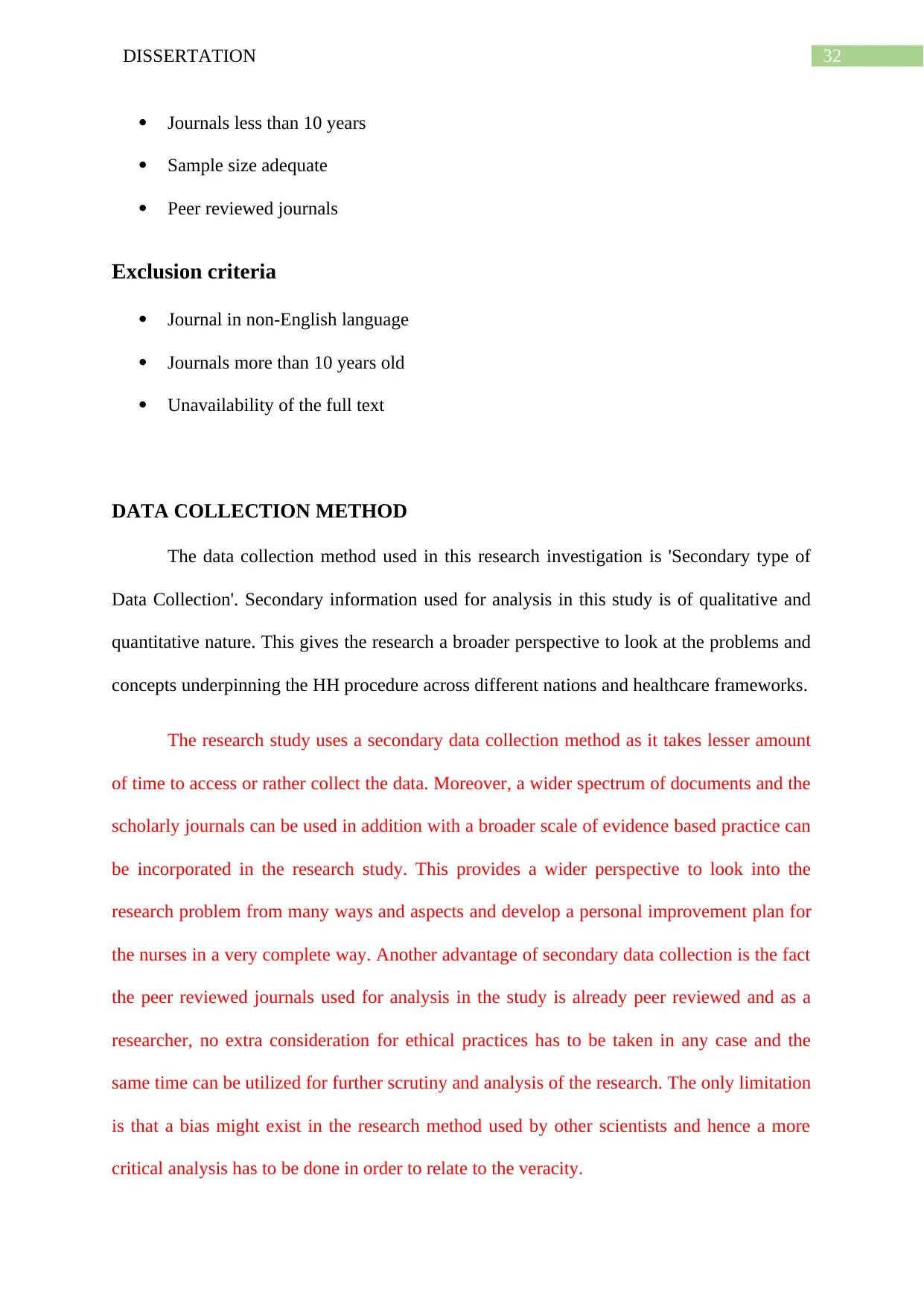
32DISSERTATION
Journals less than 10 years
Sample size adequate
Peer reviewed journals
Exclusion criteria
Journal in non-English language
Journals more than 10 years old
Unavailability of the full text
DATA COLLECTION METHOD
The data collection method used in this research investigation is 'Secondary type of
Data Collection'. Secondary information used for analysis in this study is of qualitative and
quantitative nature. This gives the research a broader perspective to look at the problems and
concepts underpinning the HH procedure across different nations and healthcare frameworks.
The research study uses a secondary data collection method as it takes lesser amount
of time to access or rather collect the data. Moreover, a wider spectrum of documents and the
scholarly journals can be used in addition with a broader scale of evidence based practice can
be incorporated in the research study. This provides a wider perspective to look into the
research problem from many ways and aspects and develop a personal improvement plan for
the nurses in a very complete way. Another advantage of secondary data collection is the fact
the peer reviewed journals used for analysis in the study is already peer reviewed and as a
researcher, no extra consideration for ethical practices has to be taken in any case and the
same time can be utilized for further scrutiny and analysis of the research. The only limitation
is that a bias might exist in the research method used by other scientists and hence a more
critical analysis has to be done in order to relate to the veracity.
Journals less than 10 years
Sample size adequate
Peer reviewed journals
Exclusion criteria
Journal in non-English language
Journals more than 10 years old
Unavailability of the full text
DATA COLLECTION METHOD
The data collection method used in this research investigation is 'Secondary type of
Data Collection'. Secondary information used for analysis in this study is of qualitative and
quantitative nature. This gives the research a broader perspective to look at the problems and
concepts underpinning the HH procedure across different nations and healthcare frameworks.
The research study uses a secondary data collection method as it takes lesser amount
of time to access or rather collect the data. Moreover, a wider spectrum of documents and the
scholarly journals can be used in addition with a broader scale of evidence based practice can
be incorporated in the research study. This provides a wider perspective to look into the
research problem from many ways and aspects and develop a personal improvement plan for
the nurses in a very complete way. Another advantage of secondary data collection is the fact
the peer reviewed journals used for analysis in the study is already peer reviewed and as a
researcher, no extra consideration for ethical practices has to be taken in any case and the
same time can be utilized for further scrutiny and analysis of the research. The only limitation
is that a bias might exist in the research method used by other scientists and hence a more
critical analysis has to be done in order to relate to the veracity.
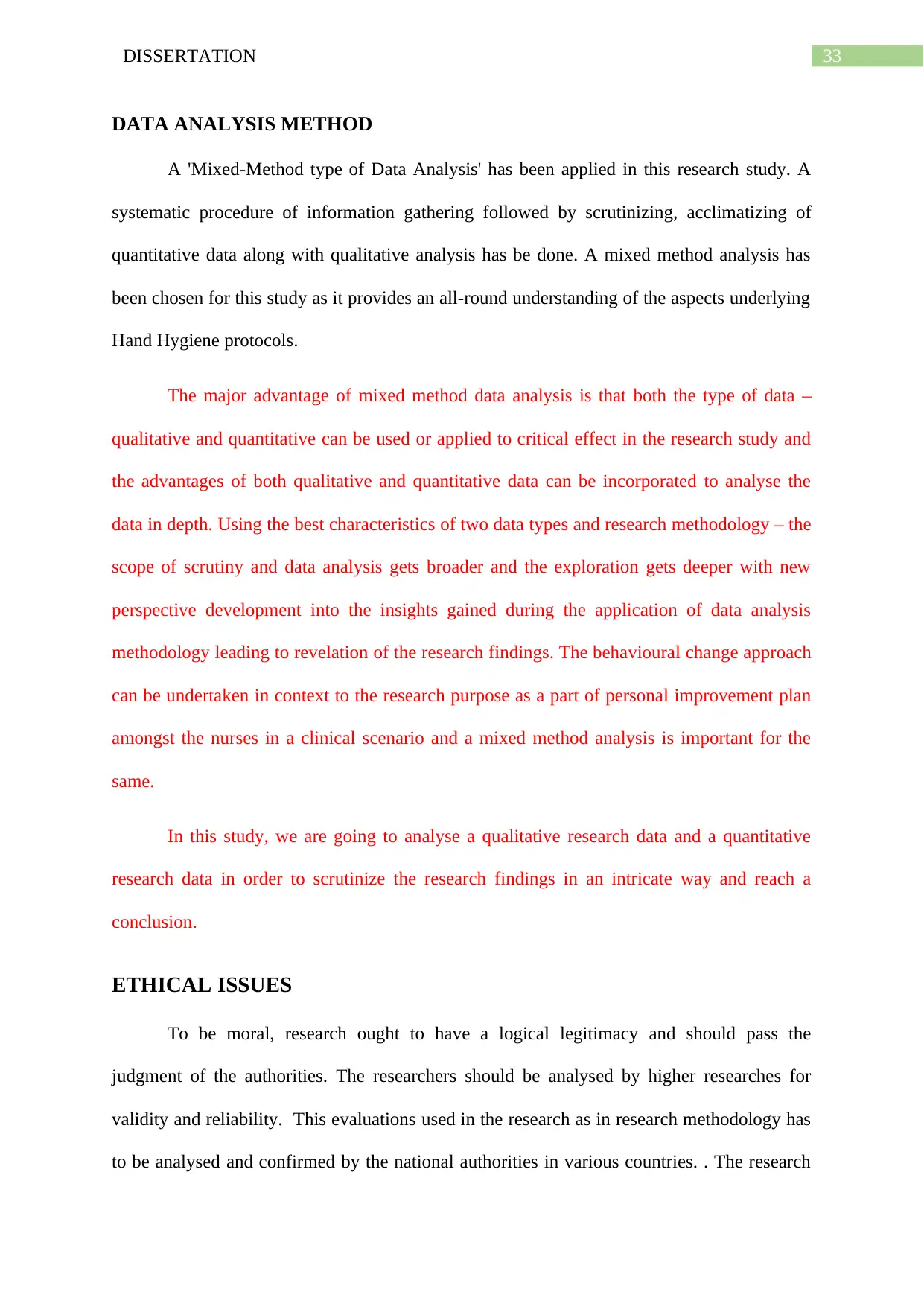
33DISSERTATION
DATA ANALYSIS METHOD
A 'Mixed-Method type of Data Analysis' has been applied in this research study. A
systematic procedure of information gathering followed by scrutinizing, acclimatizing of
quantitative data along with qualitative analysis has be done. A mixed method analysis has
been chosen for this study as it provides an all-round understanding of the aspects underlying
Hand Hygiene protocols.
The major advantage of mixed method data analysis is that both the type of data –
qualitative and quantitative can be used or applied to critical effect in the research study and
the advantages of both qualitative and quantitative data can be incorporated to analyse the
data in depth. Using the best characteristics of two data types and research methodology – the
scope of scrutiny and data analysis gets broader and the exploration gets deeper with new
perspective development into the insights gained during the application of data analysis
methodology leading to revelation of the research findings. The behavioural change approach
can be undertaken in context to the research purpose as a part of personal improvement plan
amongst the nurses in a clinical scenario and a mixed method analysis is important for the
same.
In this study, we are going to analyse a qualitative research data and a quantitative
research data in order to scrutinize the research findings in an intricate way and reach a
conclusion.
ETHICAL ISSUES
To be moral, research ought to have a logical legitimacy and should pass the
judgment of the authorities. The researchers should be analysed by higher researches for
validity and reliability. This evaluations used in the research as in research methodology has
to be analysed and confirmed by the national authorities in various countries. . The research
DATA ANALYSIS METHOD
A 'Mixed-Method type of Data Analysis' has been applied in this research study. A
systematic procedure of information gathering followed by scrutinizing, acclimatizing of
quantitative data along with qualitative analysis has be done. A mixed method analysis has
been chosen for this study as it provides an all-round understanding of the aspects underlying
Hand Hygiene protocols.
The major advantage of mixed method data analysis is that both the type of data –
qualitative and quantitative can be used or applied to critical effect in the research study and
the advantages of both qualitative and quantitative data can be incorporated to analyse the
data in depth. Using the best characteristics of two data types and research methodology – the
scope of scrutiny and data analysis gets broader and the exploration gets deeper with new
perspective development into the insights gained during the application of data analysis
methodology leading to revelation of the research findings. The behavioural change approach
can be undertaken in context to the research purpose as a part of personal improvement plan
amongst the nurses in a clinical scenario and a mixed method analysis is important for the
same.
In this study, we are going to analyse a qualitative research data and a quantitative
research data in order to scrutinize the research findings in an intricate way and reach a
conclusion.
ETHICAL ISSUES
To be moral, research ought to have a logical legitimacy and should pass the
judgment of the authorities. The researchers should be analysed by higher researches for
validity and reliability. This evaluations used in the research as in research methodology has
to be analysed and confirmed by the national authorities in various countries. . The research
Secure Best Marks with AI Grader
Need help grading? Try our AI Grader for instant feedback on your assignments.
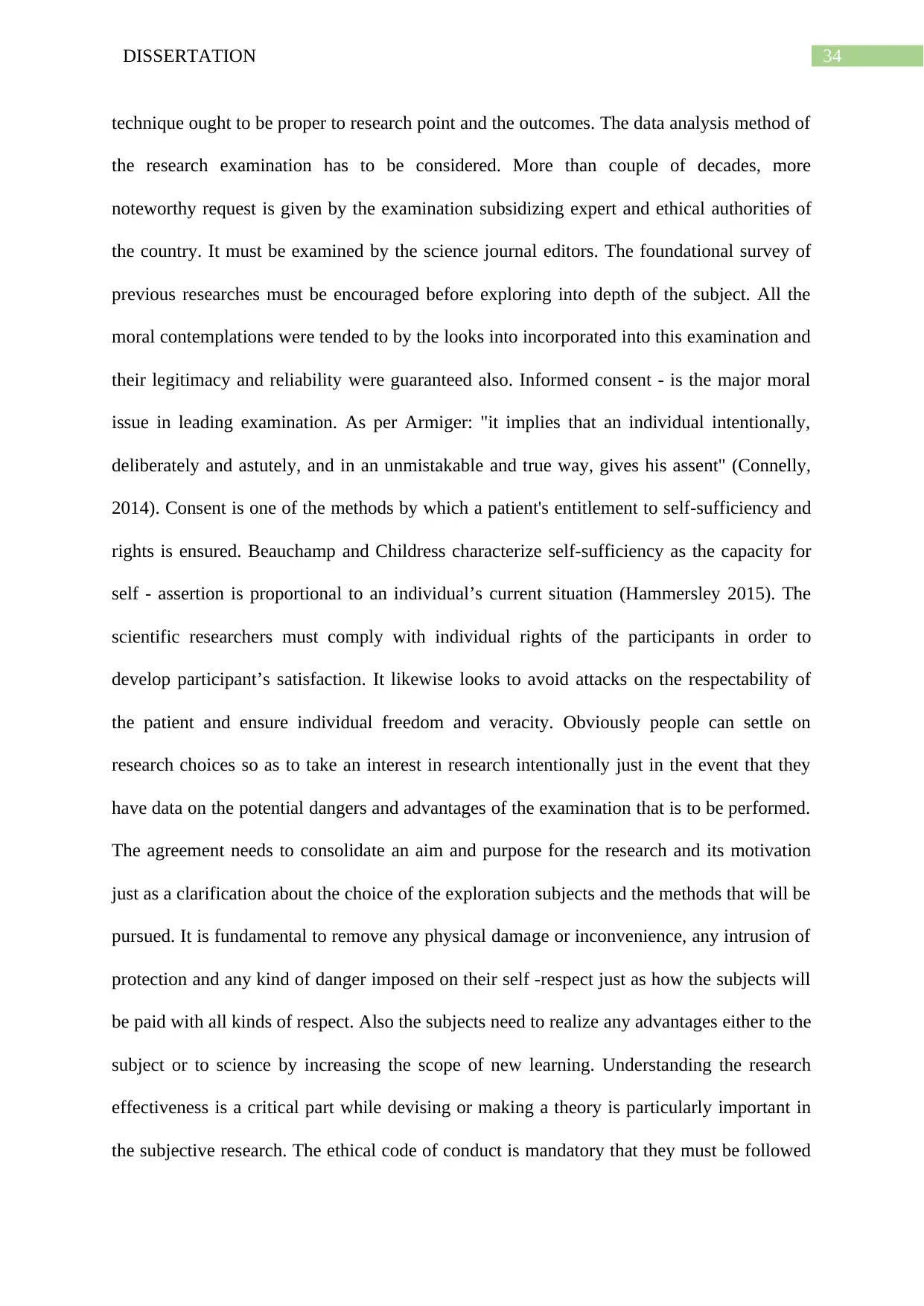
34DISSERTATION
technique ought to be proper to research point and the outcomes. The data analysis method of
the research examination has to be considered. More than couple of decades, more
noteworthy request is given by the examination subsidizing expert and ethical authorities of
the country. It must be examined by the science journal editors. The foundational survey of
previous researches must be encouraged before exploring into depth of the subject. All the
moral contemplations were tended to by the looks into incorporated into this examination and
their legitimacy and reliability were guaranteed also. Informed consent - is the major moral
issue in leading examination. As per Armiger: "it implies that an individual intentionally,
deliberately and astutely, and in an unmistakable and true way, gives his assent" (Connelly,
2014). Consent is one of the methods by which a patient's entitlement to self-sufficiency and
rights is ensured. Beauchamp and Childress characterize self-sufficiency as the capacity for
self - assertion is proportional to an individual’s current situation (Hammersley 2015). The
scientific researchers must comply with individual rights of the participants in order to
develop participant’s satisfaction. It likewise looks to avoid attacks on the respectability of
the patient and ensure individual freedom and veracity. Obviously people can settle on
research choices so as to take an interest in research intentionally just in the event that they
have data on the potential dangers and advantages of the examination that is to be performed.
The agreement needs to consolidate an aim and purpose for the research and its motivation
just as a clarification about the choice of the exploration subjects and the methods that will be
pursued. It is fundamental to remove any physical damage or inconvenience, any intrusion of
protection and any kind of danger imposed on their self -respect just as how the subjects will
be paid with all kinds of respect. Also the subjects need to realize any advantages either to the
subject or to science by increasing the scope of new learning. Understanding the research
effectiveness is a critical part while devising or making a theory is particularly important in
the subjective research. The ethical code of conduct is mandatory that they must be followed
technique ought to be proper to research point and the outcomes. The data analysis method of
the research examination has to be considered. More than couple of decades, more
noteworthy request is given by the examination subsidizing expert and ethical authorities of
the country. It must be examined by the science journal editors. The foundational survey of
previous researches must be encouraged before exploring into depth of the subject. All the
moral contemplations were tended to by the looks into incorporated into this examination and
their legitimacy and reliability were guaranteed also. Informed consent - is the major moral
issue in leading examination. As per Armiger: "it implies that an individual intentionally,
deliberately and astutely, and in an unmistakable and true way, gives his assent" (Connelly,
2014). Consent is one of the methods by which a patient's entitlement to self-sufficiency and
rights is ensured. Beauchamp and Childress characterize self-sufficiency as the capacity for
self - assertion is proportional to an individual’s current situation (Hammersley 2015). The
scientific researchers must comply with individual rights of the participants in order to
develop participant’s satisfaction. It likewise looks to avoid attacks on the respectability of
the patient and ensure individual freedom and veracity. Obviously people can settle on
research choices so as to take an interest in research intentionally just in the event that they
have data on the potential dangers and advantages of the examination that is to be performed.
The agreement needs to consolidate an aim and purpose for the research and its motivation
just as a clarification about the choice of the exploration subjects and the methods that will be
pursued. It is fundamental to remove any physical damage or inconvenience, any intrusion of
protection and any kind of danger imposed on their self -respect just as how the subjects will
be paid with all kinds of respect. Also the subjects need to realize any advantages either to the
subject or to science by increasing the scope of new learning. Understanding the research
effectiveness is a critical part while devising or making a theory is particularly important in
the subjective research. The ethical code of conduct is mandatory that they must be followed
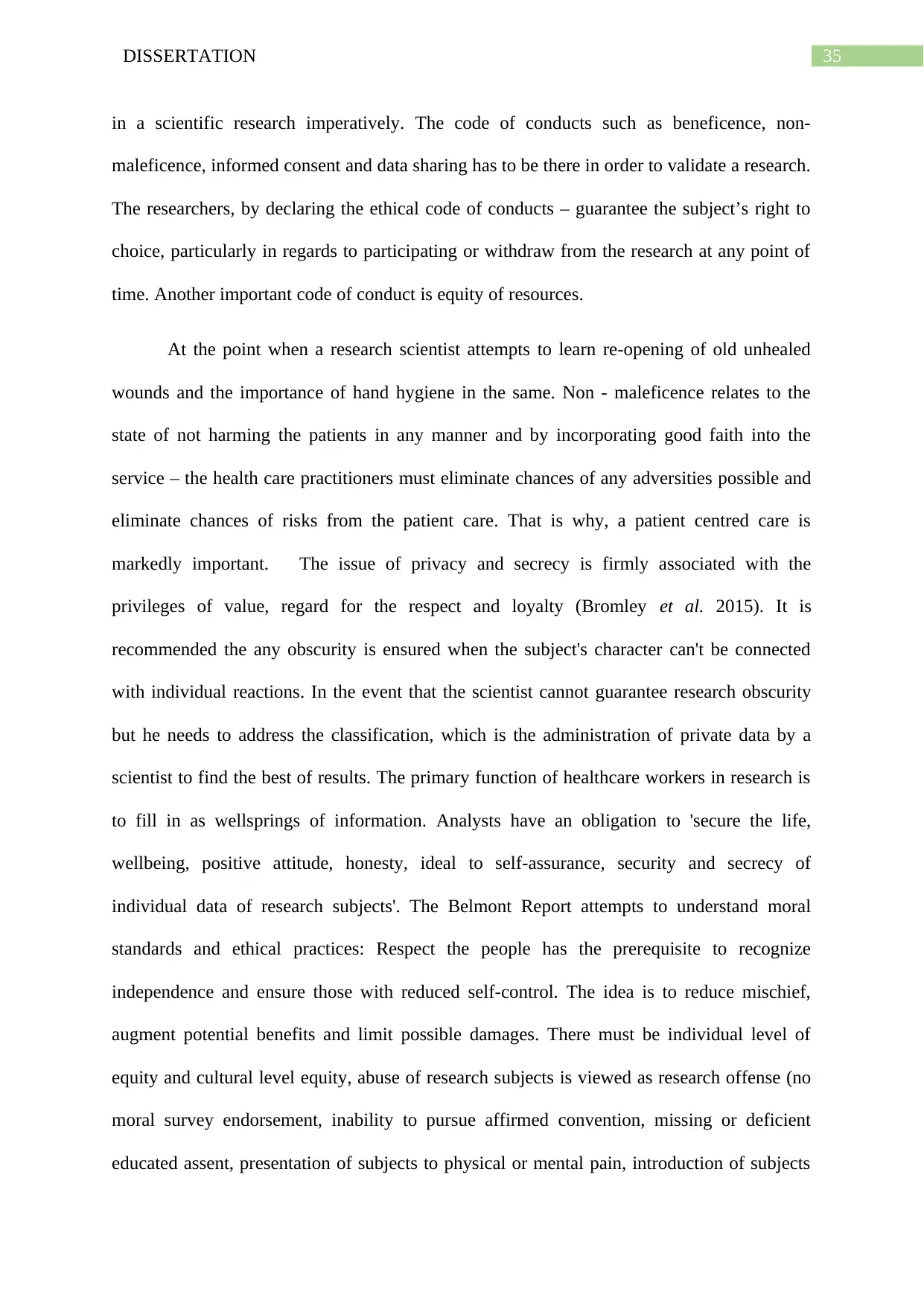
35DISSERTATION
in a scientific research imperatively. The code of conducts such as beneficence, non-
maleficence, informed consent and data sharing has to be there in order to validate a research.
The researchers, by declaring the ethical code of conducts – guarantee the subject’s right to
choice, particularly in regards to participating or withdraw from the research at any point of
time. Another important code of conduct is equity of resources.
At the point when a research scientist attempts to learn re-opening of old unhealed
wounds and the importance of hand hygiene in the same. Non - maleficence relates to the
state of not harming the patients in any manner and by incorporating good faith into the
service – the health care practitioners must eliminate chances of any adversities possible and
eliminate chances of risks from the patient care. That is why, a patient centred care is
markedly important. The issue of privacy and secrecy is firmly associated with the
privileges of value, regard for the respect and loyalty (Bromley et al. 2015). It is
recommended the any obscurity is ensured when the subject's character can't be connected
with individual reactions. In the event that the scientist cannot guarantee research obscurity
but he needs to address the classification, which is the administration of private data by a
scientist to find the best of results. The primary function of healthcare workers in research is
to fill in as wellsprings of information. Analysts have an obligation to 'secure the life,
wellbeing, positive attitude, honesty, ideal to self-assurance, security and secrecy of
individual data of research subjects'. The Belmont Report attempts to understand moral
standards and ethical practices: Respect the people has the prerequisite to recognize
independence and ensure those with reduced self-control. The idea is to reduce mischief,
augment potential benefits and limit possible damages. There must be individual level of
equity and cultural level equity, abuse of research subjects is viewed as research offense (no
moral survey endorsement, inability to pursue affirmed convention, missing or deficient
educated assent, presentation of subjects to physical or mental pain, introduction of subjects
in a scientific research imperatively. The code of conducts such as beneficence, non-
maleficence, informed consent and data sharing has to be there in order to validate a research.
The researchers, by declaring the ethical code of conducts – guarantee the subject’s right to
choice, particularly in regards to participating or withdraw from the research at any point of
time. Another important code of conduct is equity of resources.
At the point when a research scientist attempts to learn re-opening of old unhealed
wounds and the importance of hand hygiene in the same. Non - maleficence relates to the
state of not harming the patients in any manner and by incorporating good faith into the
service – the health care practitioners must eliminate chances of any adversities possible and
eliminate chances of risks from the patient care. That is why, a patient centred care is
markedly important. The issue of privacy and secrecy is firmly associated with the
privileges of value, regard for the respect and loyalty (Bromley et al. 2015). It is
recommended the any obscurity is ensured when the subject's character can't be connected
with individual reactions. In the event that the scientist cannot guarantee research obscurity
but he needs to address the classification, which is the administration of private data by a
scientist to find the best of results. The primary function of healthcare workers in research is
to fill in as wellsprings of information. Analysts have an obligation to 'secure the life,
wellbeing, positive attitude, honesty, ideal to self-assurance, security and secrecy of
individual data of research subjects'. The Belmont Report attempts to understand moral
standards and ethical practices: Respect the people has the prerequisite to recognize
independence and ensure those with reduced self-control. The idea is to reduce mischief,
augment potential benefits and limit possible damages. There must be individual level of
equity and cultural level equity, abuse of research subjects is viewed as research offense (no
moral survey endorsement, inability to pursue affirmed convention, missing or deficient
educated assent, presentation of subjects to physical or mental pain, introduction of subjects
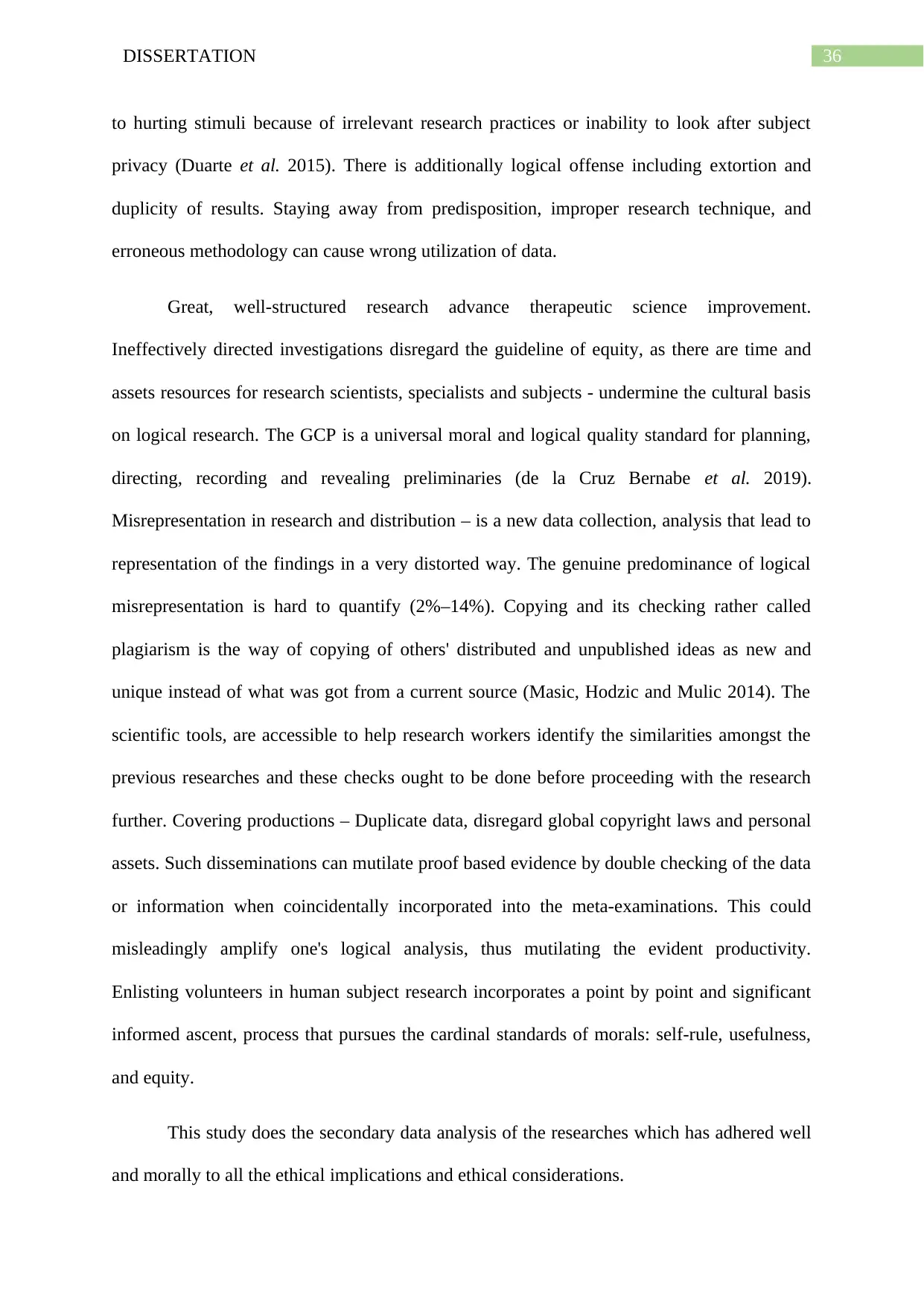
36DISSERTATION
to hurting stimuli because of irrelevant research practices or inability to look after subject
privacy (Duarte et al. 2015). There is additionally logical offense including extortion and
duplicity of results. Staying away from predisposition, improper research technique, and
erroneous methodology can cause wrong utilization of data.
Great, well-structured research advance therapeutic science improvement.
Ineffectively directed investigations disregard the guideline of equity, as there are time and
assets resources for research scientists, specialists and subjects - undermine the cultural basis
on logical research. The GCP is a universal moral and logical quality standard for planning,
directing, recording and revealing preliminaries (de la Cruz Bernabe et al. 2019).
Misrepresentation in research and distribution – is a new data collection, analysis that lead to
representation of the findings in a very distorted way. The genuine predominance of logical
misrepresentation is hard to quantify (2%–14%). Copying and its checking rather called
plagiarism is the way of copying of others' distributed and unpublished ideas as new and
unique instead of what was got from a current source (Masic, Hodzic and Mulic 2014). The
scientific tools, are accessible to help research workers identify the similarities amongst the
previous researches and these checks ought to be done before proceeding with the research
further. Covering productions – Duplicate data, disregard global copyright laws and personal
assets. Such disseminations can mutilate proof based evidence by double checking of the data
or information when coincidentally incorporated into the meta-examinations. This could
misleadingly amplify one's logical analysis, thus mutilating the evident productivity.
Enlisting volunteers in human subject research incorporates a point by point and significant
informed ascent, process that pursues the cardinal standards of morals: self-rule, usefulness,
and equity.
This study does the secondary data analysis of the researches which has adhered well
and morally to all the ethical implications and ethical considerations.
to hurting stimuli because of irrelevant research practices or inability to look after subject
privacy (Duarte et al. 2015). There is additionally logical offense including extortion and
duplicity of results. Staying away from predisposition, improper research technique, and
erroneous methodology can cause wrong utilization of data.
Great, well-structured research advance therapeutic science improvement.
Ineffectively directed investigations disregard the guideline of equity, as there are time and
assets resources for research scientists, specialists and subjects - undermine the cultural basis
on logical research. The GCP is a universal moral and logical quality standard for planning,
directing, recording and revealing preliminaries (de la Cruz Bernabe et al. 2019).
Misrepresentation in research and distribution – is a new data collection, analysis that lead to
representation of the findings in a very distorted way. The genuine predominance of logical
misrepresentation is hard to quantify (2%–14%). Copying and its checking rather called
plagiarism is the way of copying of others' distributed and unpublished ideas as new and
unique instead of what was got from a current source (Masic, Hodzic and Mulic 2014). The
scientific tools, are accessible to help research workers identify the similarities amongst the
previous researches and these checks ought to be done before proceeding with the research
further. Covering productions – Duplicate data, disregard global copyright laws and personal
assets. Such disseminations can mutilate proof based evidence by double checking of the data
or information when coincidentally incorporated into the meta-examinations. This could
misleadingly amplify one's logical analysis, thus mutilating the evident productivity.
Enlisting volunteers in human subject research incorporates a point by point and significant
informed ascent, process that pursues the cardinal standards of morals: self-rule, usefulness,
and equity.
This study does the secondary data analysis of the researches which has adhered well
and morally to all the ethical implications and ethical considerations.
Paraphrase This Document
Need a fresh take? Get an instant paraphrase of this document with our AI Paraphraser
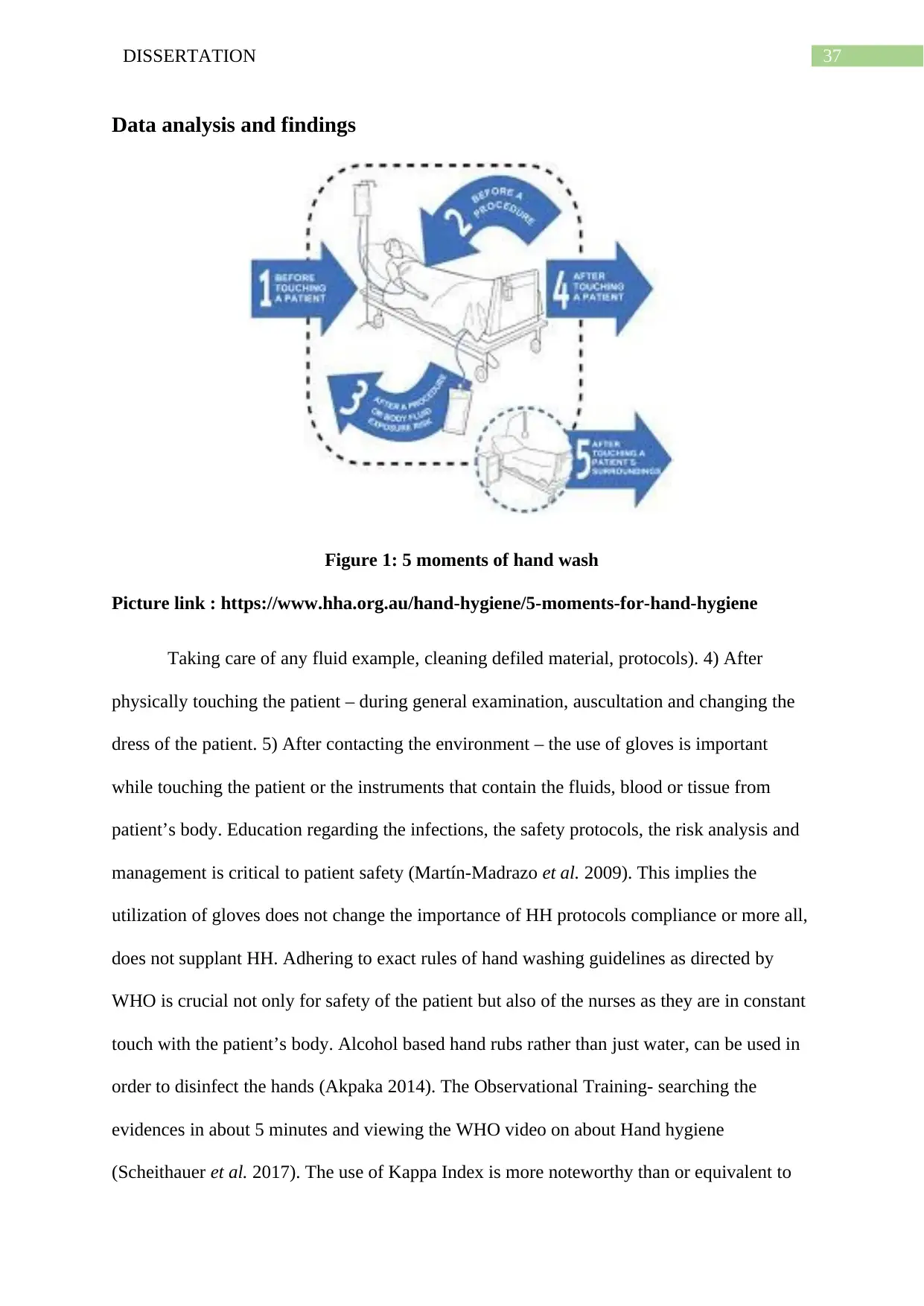
37DISSERTATION
Data analysis and findings
Figure 1: 5 moments of hand wash
Picture link : https://www.hha.org.au/hand-hygiene/5-moments-for-hand-hygiene
Taking care of any fluid example, cleaning defiled material, protocols). 4) After
physically touching the patient – during general examination, auscultation and changing the
dress of the patient. 5) After contacting the environment – the use of gloves is important
while touching the patient or the instruments that contain the fluids, blood or tissue from
patient’s body. Education regarding the infections, the safety protocols, the risk analysis and
management is critical to patient safety (Martín-Madrazo et al. 2009). This implies the
utilization of gloves does not change the importance of HH protocols compliance or more all,
does not supplant HH. Adhering to exact rules of hand washing guidelines as directed by
WHO is crucial not only for safety of the patient but also of the nurses as they are in constant
touch with the patient’s body. Alcohol based hand rubs rather than just water, can be used in
order to disinfect the hands (Akpaka 2014). The Observational Training- searching the
evidences in about 5 minutes and viewing the WHO video on about Hand hygiene
(Scheithauer et al. 2017). The use of Kappa Index is more noteworthy than or equivalent to
Data analysis and findings
Figure 1: 5 moments of hand wash
Picture link : https://www.hha.org.au/hand-hygiene/5-moments-for-hand-hygiene
Taking care of any fluid example, cleaning defiled material, protocols). 4) After
physically touching the patient – during general examination, auscultation and changing the
dress of the patient. 5) After contacting the environment – the use of gloves is important
while touching the patient or the instruments that contain the fluids, blood or tissue from
patient’s body. Education regarding the infections, the safety protocols, the risk analysis and
management is critical to patient safety (Martín-Madrazo et al. 2009). This implies the
utilization of gloves does not change the importance of HH protocols compliance or more all,
does not supplant HH. Adhering to exact rules of hand washing guidelines as directed by
WHO is crucial not only for safety of the patient but also of the nurses as they are in constant
touch with the patient’s body. Alcohol based hand rubs rather than just water, can be used in
order to disinfect the hands (Akpaka 2014). The Observational Training- searching the
evidences in about 5 minutes and viewing the WHO video on about Hand hygiene
(Scheithauer et al. 2017). The use of Kappa Index is more noteworthy than or equivalent to
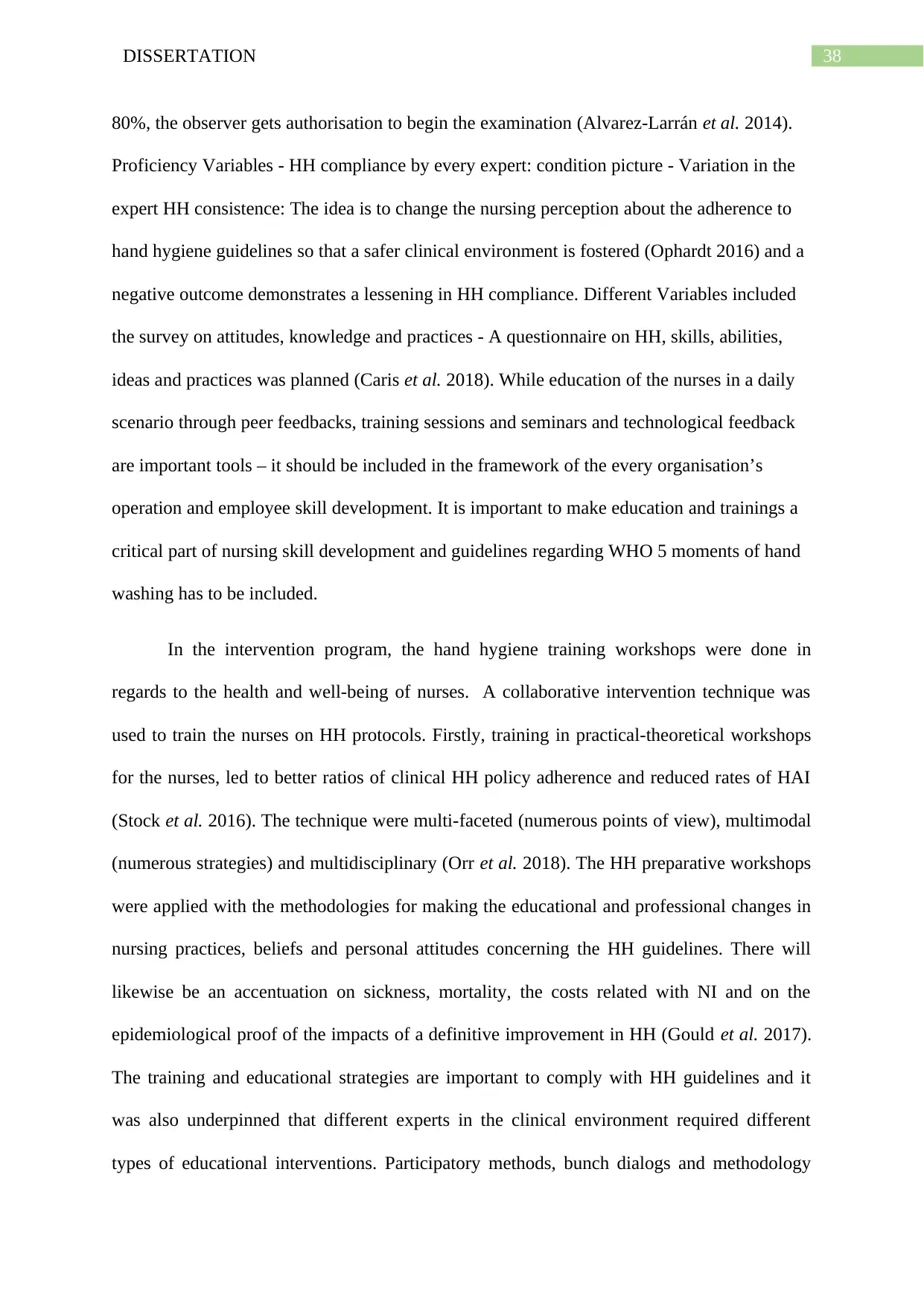
38DISSERTATION
80%, the observer gets authorisation to begin the examination (Alvarez‐Larrán et al. 2014).
Proficiency Variables - HH compliance by every expert: condition picture - Variation in the
expert HH consistence: The idea is to change the nursing perception about the adherence to
hand hygiene guidelines so that a safer clinical environment is fostered (Ophardt 2016) and a
negative outcome demonstrates a lessening in HH compliance. Different Variables included
the survey on attitudes, knowledge and practices - A questionnaire on HH, skills, abilities,
ideas and practices was planned (Caris et al. 2018). While education of the nurses in a daily
scenario through peer feedbacks, training sessions and seminars and technological feedback
are important tools – it should be included in the framework of the every organisation’s
operation and employee skill development. It is important to make education and trainings a
critical part of nursing skill development and guidelines regarding WHO 5 moments of hand
washing has to be included.
In the intervention program, the hand hygiene training workshops were done in
regards to the health and well-being of nurses. A collaborative intervention technique was
used to train the nurses on HH protocols. Firstly, training in practical-theoretical workshops
for the nurses, led to better ratios of clinical HH policy adherence and reduced rates of HAI
(Stock et al. 2016). The technique were multi-faceted (numerous points of view), multimodal
(numerous strategies) and multidisciplinary (Orr et al. 2018). The HH preparative workshops
were applied with the methodologies for making the educational and professional changes in
nursing practices, beliefs and personal attitudes concerning the HH guidelines. There will
likewise be an accentuation on sickness, mortality, the costs related with NI and on the
epidemiological proof of the impacts of a definitive improvement in HH (Gould et al. 2017).
The training and educational strategies are important to comply with HH guidelines and it
was also underpinned that different experts in the clinical environment required different
types of educational interventions. Participatory methods, bunch dialogs and methodology
80%, the observer gets authorisation to begin the examination (Alvarez‐Larrán et al. 2014).
Proficiency Variables - HH compliance by every expert: condition picture - Variation in the
expert HH consistence: The idea is to change the nursing perception about the adherence to
hand hygiene guidelines so that a safer clinical environment is fostered (Ophardt 2016) and a
negative outcome demonstrates a lessening in HH compliance. Different Variables included
the survey on attitudes, knowledge and practices - A questionnaire on HH, skills, abilities,
ideas and practices was planned (Caris et al. 2018). While education of the nurses in a daily
scenario through peer feedbacks, training sessions and seminars and technological feedback
are important tools – it should be included in the framework of the every organisation’s
operation and employee skill development. It is important to make education and trainings a
critical part of nursing skill development and guidelines regarding WHO 5 moments of hand
washing has to be included.
In the intervention program, the hand hygiene training workshops were done in
regards to the health and well-being of nurses. A collaborative intervention technique was
used to train the nurses on HH protocols. Firstly, training in practical-theoretical workshops
for the nurses, led to better ratios of clinical HH policy adherence and reduced rates of HAI
(Stock et al. 2016). The technique were multi-faceted (numerous points of view), multimodal
(numerous strategies) and multidisciplinary (Orr et al. 2018). The HH preparative workshops
were applied with the methodologies for making the educational and professional changes in
nursing practices, beliefs and personal attitudes concerning the HH guidelines. There will
likewise be an accentuation on sickness, mortality, the costs related with NI and on the
epidemiological proof of the impacts of a definitive improvement in HH (Gould et al. 2017).
The training and educational strategies are important to comply with HH guidelines and it
was also underpinned that different experts in the clinical environment required different
types of educational interventions. Participatory methods, bunch dialogs and methodology

39DISSERTATION
exhibits will be utilized. Secondly, the use of ABHR or alcohol based hand rubs in all rooms
in hospital and nursing home, focus on developing a hospital culture towards sustenance of
safety practices amongst the nurses. In the workshops, the "Work place reminders" and
social support were incorporated with multimodal procedure for advancing HH practices and
educational reminders such as flyers, notices, posters and different info graphics were used in
order to up the quality of patient care with appropriate HH policy adherence (Stewardson et
al. 2016).
In a study Haverstick et al. (2017) aimed to understand patient’s hand washing and
resultant decrease in the incidents of hospital acquired infections (HAI) found out
effectiveness of hand hygiene and importance of education for complying with the same.
Unit-specific infection control data showed that VRE infections was reported to decrease by
about 70% (n =33 prior, n= 10 afterwards) in a period of 19-month following intervention.
The MRSA infections were reduced by about 63% (n = 19 prior, n= 7 after) in a nineteen
months period intervention and after the intervention (U=175, z=-0.171, P=.86, r=0.02)
(median, 0.78). Conversely, the infections posed by C difficile, increased about 31% in about
nineteen-month time. A Wilcoxon rank sum test revealed a significant difference in the
MRSA rates before (median, 0.82) and after (median, 0.50) the intervention (U= 102.500, z=-
2.484, P=.01, r=0.40). A Wilcoxon rank sum test revealed a significant difference in the VRE
infection rates from before (median, 1.6) and after (median, 0.50) the intervention (U=83.50,
z=-2.975, P=.003, r=0.48).
exhibits will be utilized. Secondly, the use of ABHR or alcohol based hand rubs in all rooms
in hospital and nursing home, focus on developing a hospital culture towards sustenance of
safety practices amongst the nurses. In the workshops, the "Work place reminders" and
social support were incorporated with multimodal procedure for advancing HH practices and
educational reminders such as flyers, notices, posters and different info graphics were used in
order to up the quality of patient care with appropriate HH policy adherence (Stewardson et
al. 2016).
In a study Haverstick et al. (2017) aimed to understand patient’s hand washing and
resultant decrease in the incidents of hospital acquired infections (HAI) found out
effectiveness of hand hygiene and importance of education for complying with the same.
Unit-specific infection control data showed that VRE infections was reported to decrease by
about 70% (n =33 prior, n= 10 afterwards) in a period of 19-month following intervention.
The MRSA infections were reduced by about 63% (n = 19 prior, n= 7 after) in a nineteen
months period intervention and after the intervention (U=175, z=-0.171, P=.86, r=0.02)
(median, 0.78). Conversely, the infections posed by C difficile, increased about 31% in about
nineteen-month time. A Wilcoxon rank sum test revealed a significant difference in the
MRSA rates before (median, 0.82) and after (median, 0.50) the intervention (U= 102.500, z=-
2.484, P=.01, r=0.40). A Wilcoxon rank sum test revealed a significant difference in the VRE
infection rates from before (median, 1.6) and after (median, 0.50) the intervention (U=83.50,
z=-2.975, P=.003, r=0.48).
Secure Best Marks with AI Grader
Need help grading? Try our AI Grader for instant feedback on your assignments.

40DISSERTATION
Table 1: Staff questionnaire
Table 1: Staff questionnaire
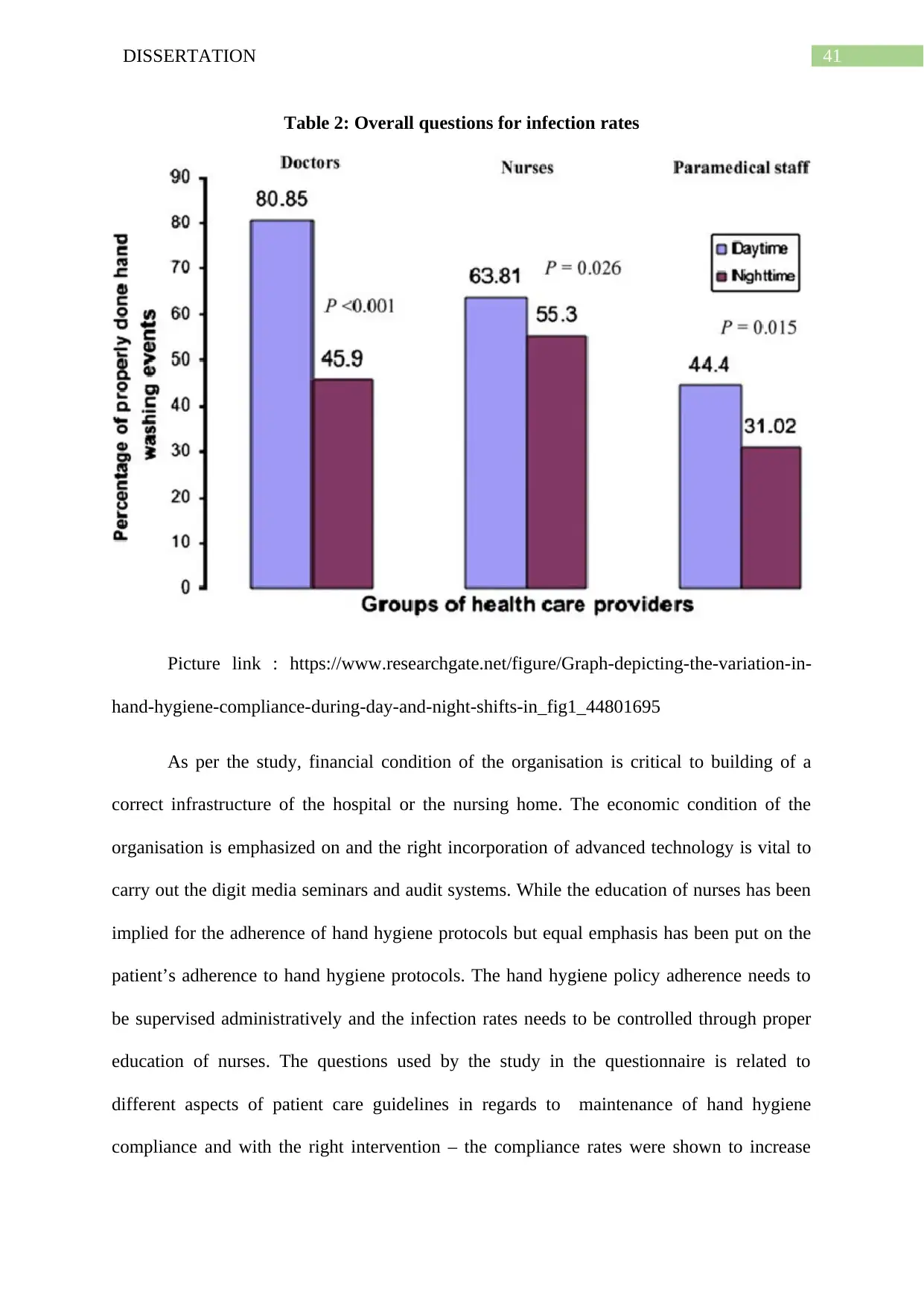
41DISSERTATION
Table 2: Overall questions for infection rates
Picture link : https://www.researchgate.net/figure/Graph-depicting-the-variation-in-
hand-hygiene-compliance-during-day-and-night-shifts-in_fig1_44801695
As per the study, financial condition of the organisation is critical to building of a
correct infrastructure of the hospital or the nursing home. The economic condition of the
organisation is emphasized on and the right incorporation of advanced technology is vital to
carry out the digit media seminars and audit systems. While the education of nurses has been
implied for the adherence of hand hygiene protocols but equal emphasis has been put on the
patient’s adherence to hand hygiene protocols. The hand hygiene policy adherence needs to
be supervised administratively and the infection rates needs to be controlled through proper
education of nurses. The questions used by the study in the questionnaire is related to
different aspects of patient care guidelines in regards to maintenance of hand hygiene
compliance and with the right intervention – the compliance rates were shown to increase
Table 2: Overall questions for infection rates
Picture link : https://www.researchgate.net/figure/Graph-depicting-the-variation-in-
hand-hygiene-compliance-during-day-and-night-shifts-in_fig1_44801695
As per the study, financial condition of the organisation is critical to building of a
correct infrastructure of the hospital or the nursing home. The economic condition of the
organisation is emphasized on and the right incorporation of advanced technology is vital to
carry out the digit media seminars and audit systems. While the education of nurses has been
implied for the adherence of hand hygiene protocols but equal emphasis has been put on the
patient’s adherence to hand hygiene protocols. The hand hygiene policy adherence needs to
be supervised administratively and the infection rates needs to be controlled through proper
education of nurses. The questions used by the study in the questionnaire is related to
different aspects of patient care guidelines in regards to maintenance of hand hygiene
compliance and with the right intervention – the compliance rates were shown to increase

42DISSERTATION
amongst the new graduate nurses and thus reducing the rate of hospital acquired infection
occurrence.
Dissemination
The findings of the research will transferred to educational and higher education
setting so that the new graduate nurses and even medical students becomes aware of the
importance of adhering to hand hygiene guidelines. The results can be used by higher
researches for validity and further confirmation.
Conclusion
Hence, the study concludes by highlighting the self-determination and self-efficacy
being the most powerful ways of self persuasion for hand hygiene compliance. The research
study recommends by advising the organisation to incorporate new technologies to check and
audit hand compliance ratios in their organisation and these audits should pertinently be
regular. While positive work environment is critical to adherence of Hand hygiene policies -
care must be taken to develop a compassionate culture within the nurses in order to comply
with HH guidelines. The training and education, should nevertheless be made robust in order
to develop a sense of responsibility with the new graduate nurses and so that they start with
the hand hygiene compliance from the very beginning itself.
References
Akpaka, C.C., 2014. Best practices for hand hygiene compliance by health care providers in
the inpatient setting. American Journal of Infectious Diseases, 10(2), p.84.
Alvarez‐Larrán, A., Ancochea, A., García, M., Climent, F., García‐Pallarols, F., Angona, A.,
Senín, A., Barranco, C., Martínez‐Avilés, L., Serrano, S. and Bellosillo, B., 2014. WHO‐
amongst the new graduate nurses and thus reducing the rate of hospital acquired infection
occurrence.
Dissemination
The findings of the research will transferred to educational and higher education
setting so that the new graduate nurses and even medical students becomes aware of the
importance of adhering to hand hygiene guidelines. The results can be used by higher
researches for validity and further confirmation.
Conclusion
Hence, the study concludes by highlighting the self-determination and self-efficacy
being the most powerful ways of self persuasion for hand hygiene compliance. The research
study recommends by advising the organisation to incorporate new technologies to check and
audit hand compliance ratios in their organisation and these audits should pertinently be
regular. While positive work environment is critical to adherence of Hand hygiene policies -
care must be taken to develop a compassionate culture within the nurses in order to comply
with HH guidelines. The training and education, should nevertheless be made robust in order
to develop a sense of responsibility with the new graduate nurses and so that they start with
the hand hygiene compliance from the very beginning itself.
References
Akpaka, C.C., 2014. Best practices for hand hygiene compliance by health care providers in
the inpatient setting. American Journal of Infectious Diseases, 10(2), p.84.
Alvarez‐Larrán, A., Ancochea, A., García, M., Climent, F., García‐Pallarols, F., Angona, A.,
Senín, A., Barranco, C., Martínez‐Avilés, L., Serrano, S. and Bellosillo, B., 2014. WHO‐
Paraphrase This Document
Need a fresh take? Get an instant paraphrase of this document with our AI Paraphraser
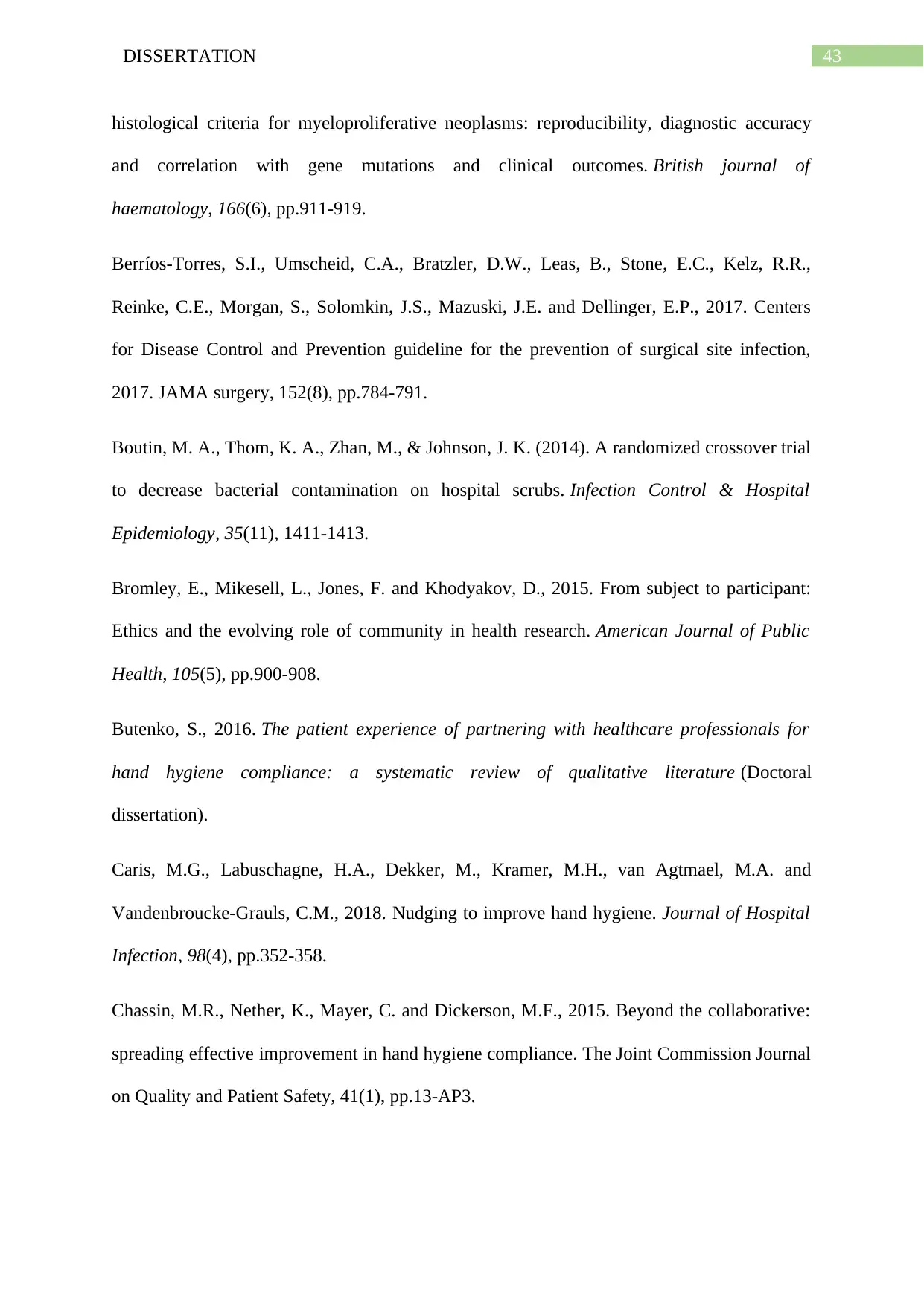
43DISSERTATION
histological criteria for myeloproliferative neoplasms: reproducibility, diagnostic accuracy
and correlation with gene mutations and clinical outcomes. British journal of
haematology, 166(6), pp.911-919.
Berríos-Torres, S.I., Umscheid, C.A., Bratzler, D.W., Leas, B., Stone, E.C., Kelz, R.R.,
Reinke, C.E., Morgan, S., Solomkin, J.S., Mazuski, J.E. and Dellinger, E.P., 2017. Centers
for Disease Control and Prevention guideline for the prevention of surgical site infection,
2017. JAMA surgery, 152(8), pp.784-791.
Boutin, M. A., Thom, K. A., Zhan, M., & Johnson, J. K. (2014). A randomized crossover trial
to decrease bacterial contamination on hospital scrubs. Infection Control & Hospital
Epidemiology, 35(11), 1411-1413.
Bromley, E., Mikesell, L., Jones, F. and Khodyakov, D., 2015. From subject to participant:
Ethics and the evolving role of community in health research. American Journal of Public
Health, 105(5), pp.900-908.
Butenko, S., 2016. The patient experience of partnering with healthcare professionals for
hand hygiene compliance: a systematic review of qualitative literature (Doctoral
dissertation).
Caris, M.G., Labuschagne, H.A., Dekker, M., Kramer, M.H., van Agtmael, M.A. and
Vandenbroucke-Grauls, C.M., 2018. Nudging to improve hand hygiene. Journal of Hospital
Infection, 98(4), pp.352-358.
Chassin, M.R., Nether, K., Mayer, C. and Dickerson, M.F., 2015. Beyond the collaborative:
spreading effective improvement in hand hygiene compliance. The Joint Commission Journal
on Quality and Patient Safety, 41(1), pp.13-AP3.
histological criteria for myeloproliferative neoplasms: reproducibility, diagnostic accuracy
and correlation with gene mutations and clinical outcomes. British journal of
haematology, 166(6), pp.911-919.
Berríos-Torres, S.I., Umscheid, C.A., Bratzler, D.W., Leas, B., Stone, E.C., Kelz, R.R.,
Reinke, C.E., Morgan, S., Solomkin, J.S., Mazuski, J.E. and Dellinger, E.P., 2017. Centers
for Disease Control and Prevention guideline for the prevention of surgical site infection,
2017. JAMA surgery, 152(8), pp.784-791.
Boutin, M. A., Thom, K. A., Zhan, M., & Johnson, J. K. (2014). A randomized crossover trial
to decrease bacterial contamination on hospital scrubs. Infection Control & Hospital
Epidemiology, 35(11), 1411-1413.
Bromley, E., Mikesell, L., Jones, F. and Khodyakov, D., 2015. From subject to participant:
Ethics and the evolving role of community in health research. American Journal of Public
Health, 105(5), pp.900-908.
Butenko, S., 2016. The patient experience of partnering with healthcare professionals for
hand hygiene compliance: a systematic review of qualitative literature (Doctoral
dissertation).
Caris, M.G., Labuschagne, H.A., Dekker, M., Kramer, M.H., van Agtmael, M.A. and
Vandenbroucke-Grauls, C.M., 2018. Nudging to improve hand hygiene. Journal of Hospital
Infection, 98(4), pp.352-358.
Chassin, M.R., Nether, K., Mayer, C. and Dickerson, M.F., 2015. Beyond the collaborative:
spreading effective improvement in hand hygiene compliance. The Joint Commission Journal
on Quality and Patient Safety, 41(1), pp.13-AP3.
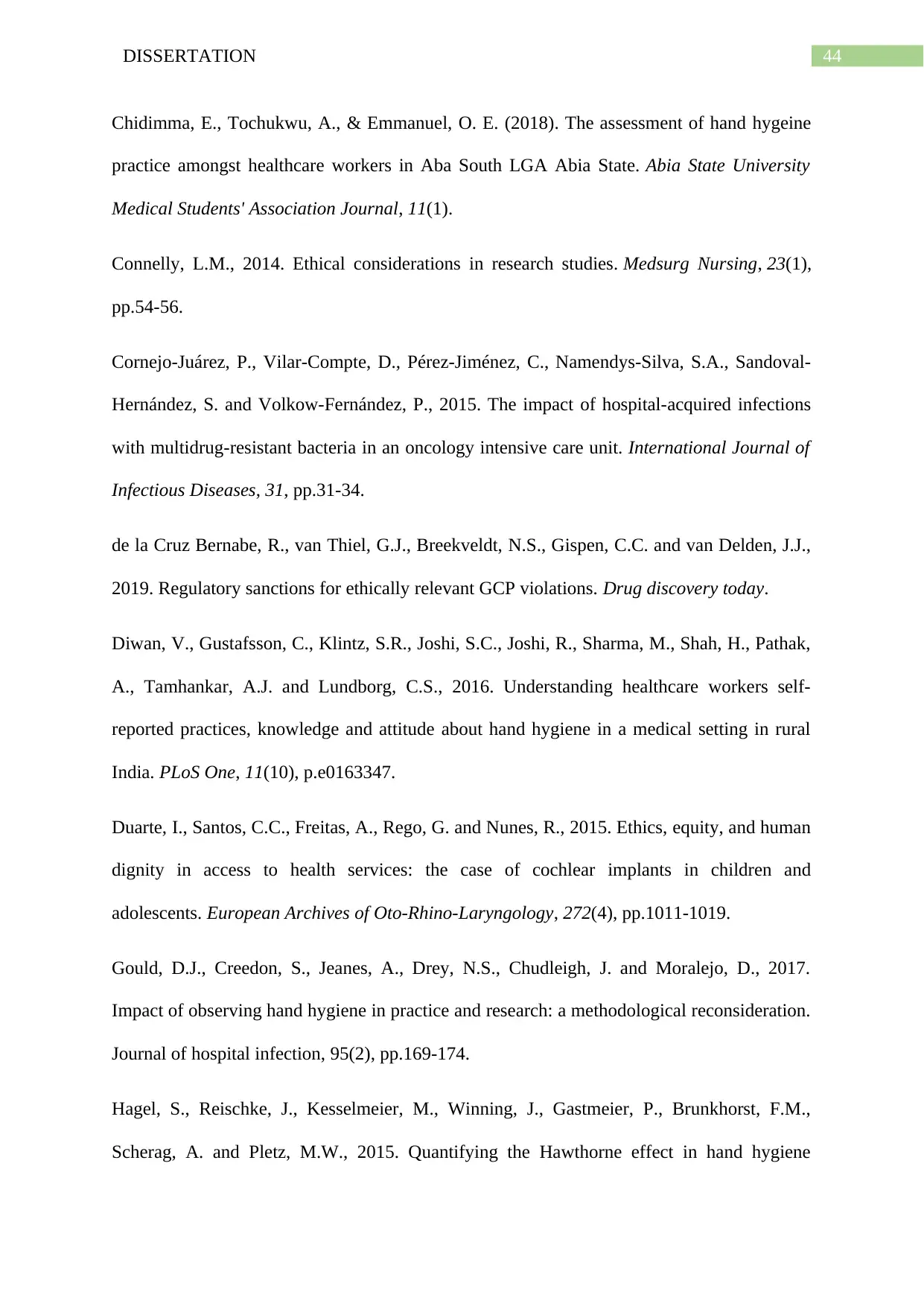
44DISSERTATION
Chidimma, E., Tochukwu, A., & Emmanuel, O. E. (2018). The assessment of hand hygeine
practice amongst healthcare workers in Aba South LGA Abia State. Abia State University
Medical Students' Association Journal, 11(1).
Connelly, L.M., 2014. Ethical considerations in research studies. Medsurg Nursing, 23(1),
pp.54-56.
Cornejo-Juárez, P., Vilar-Compte, D., Pérez-Jiménez, C., Namendys-Silva, S.A., Sandoval-
Hernández, S. and Volkow-Fernández, P., 2015. The impact of hospital-acquired infections
with multidrug-resistant bacteria in an oncology intensive care unit. International Journal of
Infectious Diseases, 31, pp.31-34.
de la Cruz Bernabe, R., van Thiel, G.J., Breekveldt, N.S., Gispen, C.C. and van Delden, J.J.,
2019. Regulatory sanctions for ethically relevant GCP violations. Drug discovery today.
Diwan, V., Gustafsson, C., Klintz, S.R., Joshi, S.C., Joshi, R., Sharma, M., Shah, H., Pathak,
A., Tamhankar, A.J. and Lundborg, C.S., 2016. Understanding healthcare workers self-
reported practices, knowledge and attitude about hand hygiene in a medical setting in rural
India. PLoS One, 11(10), p.e0163347.
Duarte, I., Santos, C.C., Freitas, A., Rego, G. and Nunes, R., 2015. Ethics, equity, and human
dignity in access to health services: the case of cochlear implants in children and
adolescents. European Archives of Oto-Rhino-Laryngology, 272(4), pp.1011-1019.
Gould, D.J., Creedon, S., Jeanes, A., Drey, N.S., Chudleigh, J. and Moralejo, D., 2017.
Impact of observing hand hygiene in practice and research: a methodological reconsideration.
Journal of hospital infection, 95(2), pp.169-174.
Hagel, S., Reischke, J., Kesselmeier, M., Winning, J., Gastmeier, P., Brunkhorst, F.M.,
Scherag, A. and Pletz, M.W., 2015. Quantifying the Hawthorne effect in hand hygiene
Chidimma, E., Tochukwu, A., & Emmanuel, O. E. (2018). The assessment of hand hygeine
practice amongst healthcare workers in Aba South LGA Abia State. Abia State University
Medical Students' Association Journal, 11(1).
Connelly, L.M., 2014. Ethical considerations in research studies. Medsurg Nursing, 23(1),
pp.54-56.
Cornejo-Juárez, P., Vilar-Compte, D., Pérez-Jiménez, C., Namendys-Silva, S.A., Sandoval-
Hernández, S. and Volkow-Fernández, P., 2015. The impact of hospital-acquired infections
with multidrug-resistant bacteria in an oncology intensive care unit. International Journal of
Infectious Diseases, 31, pp.31-34.
de la Cruz Bernabe, R., van Thiel, G.J., Breekveldt, N.S., Gispen, C.C. and van Delden, J.J.,
2019. Regulatory sanctions for ethically relevant GCP violations. Drug discovery today.
Diwan, V., Gustafsson, C., Klintz, S.R., Joshi, S.C., Joshi, R., Sharma, M., Shah, H., Pathak,
A., Tamhankar, A.J. and Lundborg, C.S., 2016. Understanding healthcare workers self-
reported practices, knowledge and attitude about hand hygiene in a medical setting in rural
India. PLoS One, 11(10), p.e0163347.
Duarte, I., Santos, C.C., Freitas, A., Rego, G. and Nunes, R., 2015. Ethics, equity, and human
dignity in access to health services: the case of cochlear implants in children and
adolescents. European Archives of Oto-Rhino-Laryngology, 272(4), pp.1011-1019.
Gould, D.J., Creedon, S., Jeanes, A., Drey, N.S., Chudleigh, J. and Moralejo, D., 2017.
Impact of observing hand hygiene in practice and research: a methodological reconsideration.
Journal of hospital infection, 95(2), pp.169-174.
Hagel, S., Reischke, J., Kesselmeier, M., Winning, J., Gastmeier, P., Brunkhorst, F.M.,
Scherag, A. and Pletz, M.W., 2015. Quantifying the Hawthorne effect in hand hygiene
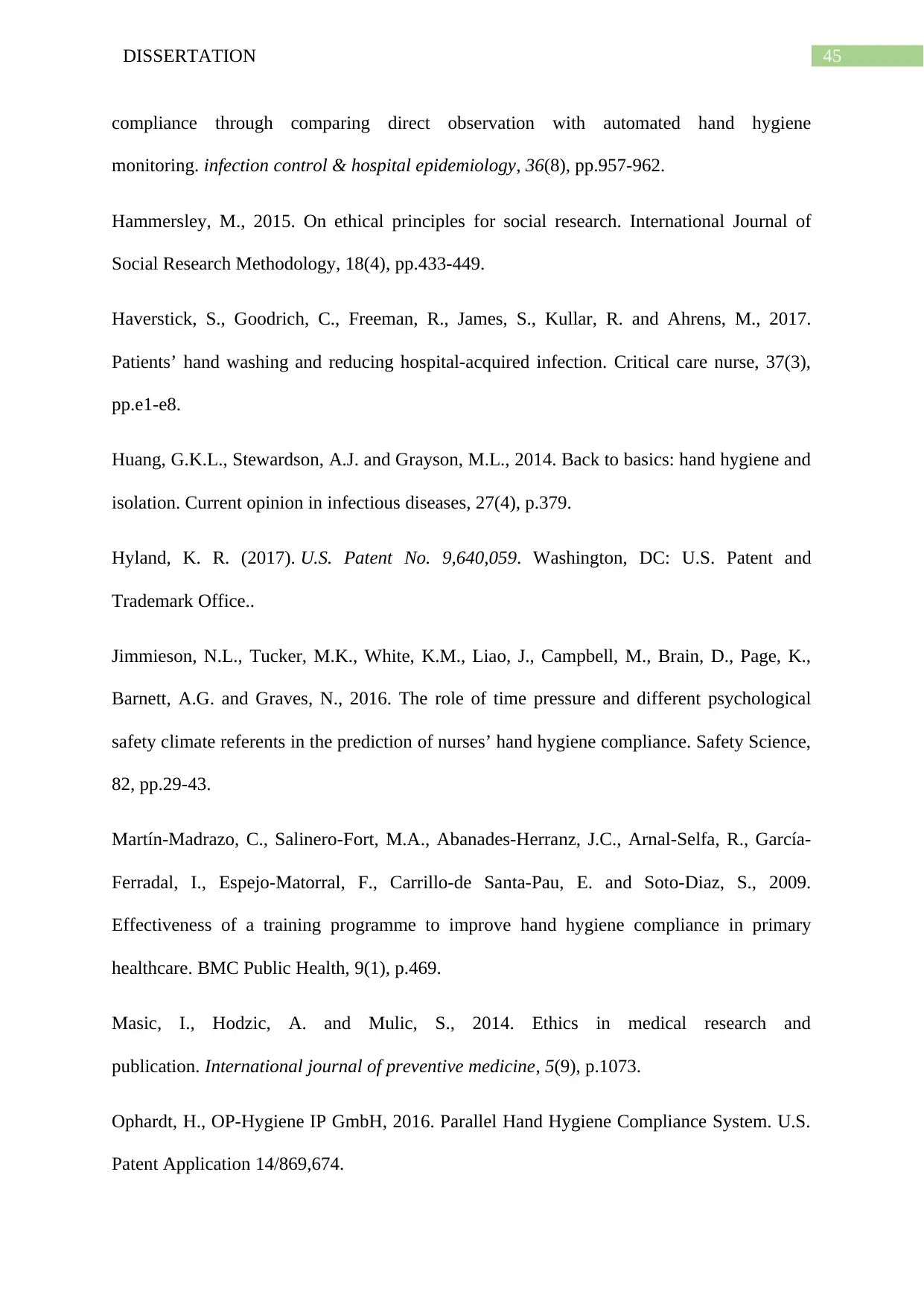
45DISSERTATION
compliance through comparing direct observation with automated hand hygiene
monitoring. infection control & hospital epidemiology, 36(8), pp.957-962.
Hammersley, M., 2015. On ethical principles for social research. International Journal of
Social Research Methodology, 18(4), pp.433-449.
Haverstick, S., Goodrich, C., Freeman, R., James, S., Kullar, R. and Ahrens, M., 2017.
Patients’ hand washing and reducing hospital-acquired infection. Critical care nurse, 37(3),
pp.e1-e8.
Huang, G.K.L., Stewardson, A.J. and Grayson, M.L., 2014. Back to basics: hand hygiene and
isolation. Current opinion in infectious diseases, 27(4), p.379.
Hyland, K. R. (2017). U.S. Patent No. 9,640,059. Washington, DC: U.S. Patent and
Trademark Office..
Jimmieson, N.L., Tucker, M.K., White, K.M., Liao, J., Campbell, M., Brain, D., Page, K.,
Barnett, A.G. and Graves, N., 2016. The role of time pressure and different psychological
safety climate referents in the prediction of nurses’ hand hygiene compliance. Safety Science,
82, pp.29-43.
Martín-Madrazo, C., Salinero-Fort, M.A., Abanades-Herranz, J.C., Arnal-Selfa, R., García-
Ferradal, I., Espejo-Matorral, F., Carrillo-de Santa-Pau, E. and Soto-Diaz, S., 2009.
Effectiveness of a training programme to improve hand hygiene compliance in primary
healthcare. BMC Public Health, 9(1), p.469.
Masic, I., Hodzic, A. and Mulic, S., 2014. Ethics in medical research and
publication. International journal of preventive medicine, 5(9), p.1073.
Ophardt, H., OP-Hygiene IP GmbH, 2016. Parallel Hand Hygiene Compliance System. U.S.
Patent Application 14/869,674.
compliance through comparing direct observation with automated hand hygiene
monitoring. infection control & hospital epidemiology, 36(8), pp.957-962.
Hammersley, M., 2015. On ethical principles for social research. International Journal of
Social Research Methodology, 18(4), pp.433-449.
Haverstick, S., Goodrich, C., Freeman, R., James, S., Kullar, R. and Ahrens, M., 2017.
Patients’ hand washing and reducing hospital-acquired infection. Critical care nurse, 37(3),
pp.e1-e8.
Huang, G.K.L., Stewardson, A.J. and Grayson, M.L., 2014. Back to basics: hand hygiene and
isolation. Current opinion in infectious diseases, 27(4), p.379.
Hyland, K. R. (2017). U.S. Patent No. 9,640,059. Washington, DC: U.S. Patent and
Trademark Office..
Jimmieson, N.L., Tucker, M.K., White, K.M., Liao, J., Campbell, M., Brain, D., Page, K.,
Barnett, A.G. and Graves, N., 2016. The role of time pressure and different psychological
safety climate referents in the prediction of nurses’ hand hygiene compliance. Safety Science,
82, pp.29-43.
Martín-Madrazo, C., Salinero-Fort, M.A., Abanades-Herranz, J.C., Arnal-Selfa, R., García-
Ferradal, I., Espejo-Matorral, F., Carrillo-de Santa-Pau, E. and Soto-Diaz, S., 2009.
Effectiveness of a training programme to improve hand hygiene compliance in primary
healthcare. BMC Public Health, 9(1), p.469.
Masic, I., Hodzic, A. and Mulic, S., 2014. Ethics in medical research and
publication. International journal of preventive medicine, 5(9), p.1073.
Ophardt, H., OP-Hygiene IP GmbH, 2016. Parallel Hand Hygiene Compliance System. U.S.
Patent Application 14/869,674.
Secure Best Marks with AI Grader
Need help grading? Try our AI Grader for instant feedback on your assignments.
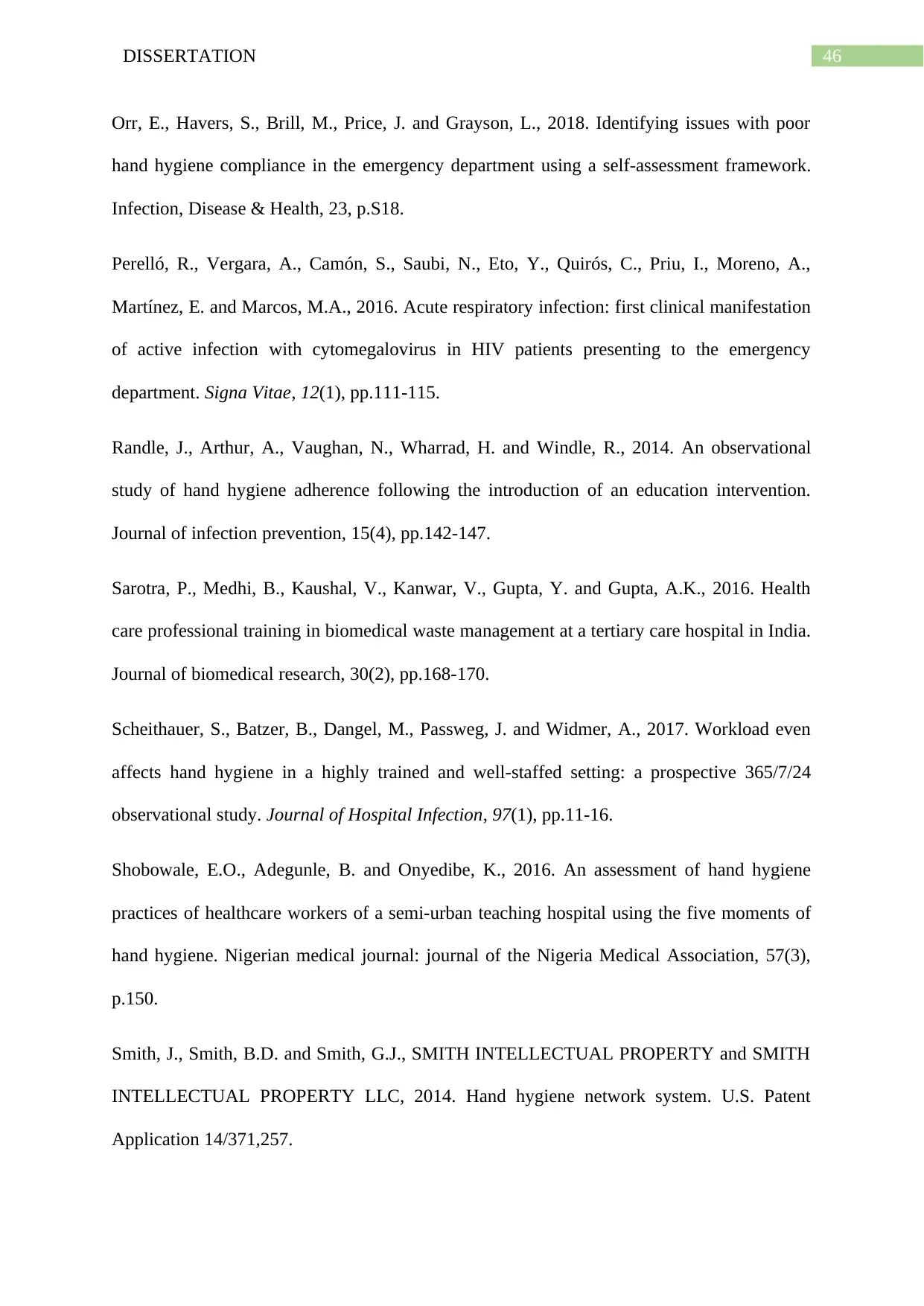
46DISSERTATION
Orr, E., Havers, S., Brill, M., Price, J. and Grayson, L., 2018. Identifying issues with poor
hand hygiene compliance in the emergency department using a self-assessment framework.
Infection, Disease & Health, 23, p.S18.
Perelló, R., Vergara, A., Camón, S., Saubi, N., Eto, Y., Quirós, C., Priu, I., Moreno, A.,
Martínez, E. and Marcos, M.A., 2016. Acute respiratory infection: first clinical manifestation
of active infection with cytomegalovirus in HIV patients presenting to the emergency
department. Signa Vitae, 12(1), pp.111-115.
Randle, J., Arthur, A., Vaughan, N., Wharrad, H. and Windle, R., 2014. An observational
study of hand hygiene adherence following the introduction of an education intervention.
Journal of infection prevention, 15(4), pp.142-147.
Sarotra, P., Medhi, B., Kaushal, V., Kanwar, V., Gupta, Y. and Gupta, A.K., 2016. Health
care professional training in biomedical waste management at a tertiary care hospital in India.
Journal of biomedical research, 30(2), pp.168-170.
Scheithauer, S., Batzer, B., Dangel, M., Passweg, J. and Widmer, A., 2017. Workload even
affects hand hygiene in a highly trained and well-staffed setting: a prospective 365/7/24
observational study. Journal of Hospital Infection, 97(1), pp.11-16.
Shobowale, E.O., Adegunle, B. and Onyedibe, K., 2016. An assessment of hand hygiene
practices of healthcare workers of a semi-urban teaching hospital using the five moments of
hand hygiene. Nigerian medical journal: journal of the Nigeria Medical Association, 57(3),
p.150.
Smith, J., Smith, B.D. and Smith, G.J., SMITH INTELLECTUAL PROPERTY and SMITH
INTELLECTUAL PROPERTY LLC, 2014. Hand hygiene network system. U.S. Patent
Application 14/371,257.
Orr, E., Havers, S., Brill, M., Price, J. and Grayson, L., 2018. Identifying issues with poor
hand hygiene compliance in the emergency department using a self-assessment framework.
Infection, Disease & Health, 23, p.S18.
Perelló, R., Vergara, A., Camón, S., Saubi, N., Eto, Y., Quirós, C., Priu, I., Moreno, A.,
Martínez, E. and Marcos, M.A., 2016. Acute respiratory infection: first clinical manifestation
of active infection with cytomegalovirus in HIV patients presenting to the emergency
department. Signa Vitae, 12(1), pp.111-115.
Randle, J., Arthur, A., Vaughan, N., Wharrad, H. and Windle, R., 2014. An observational
study of hand hygiene adherence following the introduction of an education intervention.
Journal of infection prevention, 15(4), pp.142-147.
Sarotra, P., Medhi, B., Kaushal, V., Kanwar, V., Gupta, Y. and Gupta, A.K., 2016. Health
care professional training in biomedical waste management at a tertiary care hospital in India.
Journal of biomedical research, 30(2), pp.168-170.
Scheithauer, S., Batzer, B., Dangel, M., Passweg, J. and Widmer, A., 2017. Workload even
affects hand hygiene in a highly trained and well-staffed setting: a prospective 365/7/24
observational study. Journal of Hospital Infection, 97(1), pp.11-16.
Shobowale, E.O., Adegunle, B. and Onyedibe, K., 2016. An assessment of hand hygiene
practices of healthcare workers of a semi-urban teaching hospital using the five moments of
hand hygiene. Nigerian medical journal: journal of the Nigeria Medical Association, 57(3),
p.150.
Smith, J., Smith, B.D. and Smith, G.J., SMITH INTELLECTUAL PROPERTY and SMITH
INTELLECTUAL PROPERTY LLC, 2014. Hand hygiene network system. U.S. Patent
Application 14/371,257.
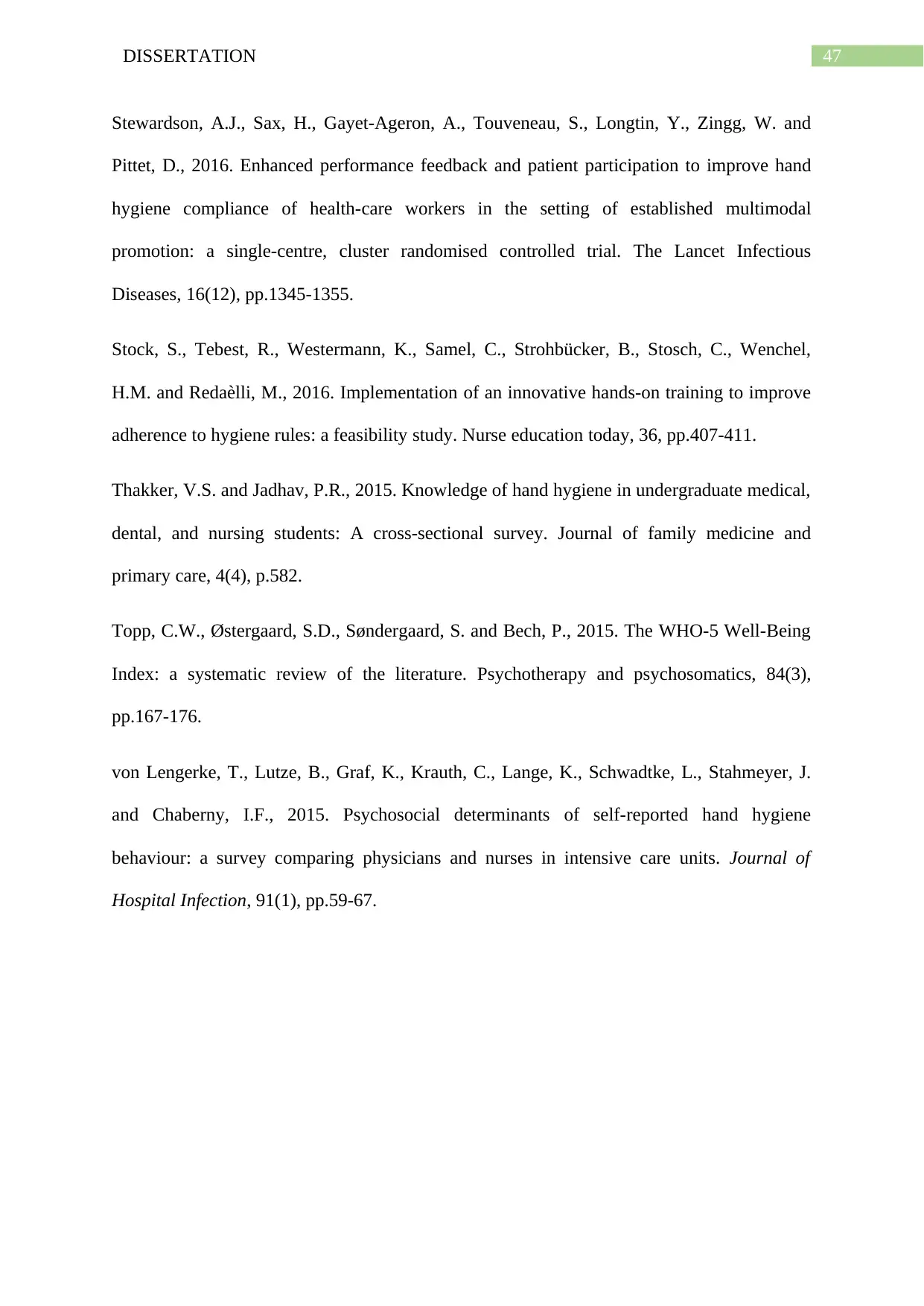
47DISSERTATION
Stewardson, A.J., Sax, H., Gayet-Ageron, A., Touveneau, S., Longtin, Y., Zingg, W. and
Pittet, D., 2016. Enhanced performance feedback and patient participation to improve hand
hygiene compliance of health-care workers in the setting of established multimodal
promotion: a single-centre, cluster randomised controlled trial. The Lancet Infectious
Diseases, 16(12), pp.1345-1355.
Stock, S., Tebest, R., Westermann, K., Samel, C., Strohbücker, B., Stosch, C., Wenchel,
H.M. and Redaèlli, M., 2016. Implementation of an innovative hands-on training to improve
adherence to hygiene rules: a feasibility study. Nurse education today, 36, pp.407-411.
Thakker, V.S. and Jadhav, P.R., 2015. Knowledge of hand hygiene in undergraduate medical,
dental, and nursing students: A cross-sectional survey. Journal of family medicine and
primary care, 4(4), p.582.
Topp, C.W., Østergaard, S.D., Søndergaard, S. and Bech, P., 2015. The WHO-5 Well-Being
Index: a systematic review of the literature. Psychotherapy and psychosomatics, 84(3),
pp.167-176.
von Lengerke, T., Lutze, B., Graf, K., Krauth, C., Lange, K., Schwadtke, L., Stahmeyer, J.
and Chaberny, I.F., 2015. Psychosocial determinants of self-reported hand hygiene
behaviour: a survey comparing physicians and nurses in intensive care units. Journal of
Hospital Infection, 91(1), pp.59-67.
Stewardson, A.J., Sax, H., Gayet-Ageron, A., Touveneau, S., Longtin, Y., Zingg, W. and
Pittet, D., 2016. Enhanced performance feedback and patient participation to improve hand
hygiene compliance of health-care workers in the setting of established multimodal
promotion: a single-centre, cluster randomised controlled trial. The Lancet Infectious
Diseases, 16(12), pp.1345-1355.
Stock, S., Tebest, R., Westermann, K., Samel, C., Strohbücker, B., Stosch, C., Wenchel,
H.M. and Redaèlli, M., 2016. Implementation of an innovative hands-on training to improve
adherence to hygiene rules: a feasibility study. Nurse education today, 36, pp.407-411.
Thakker, V.S. and Jadhav, P.R., 2015. Knowledge of hand hygiene in undergraduate medical,
dental, and nursing students: A cross-sectional survey. Journal of family medicine and
primary care, 4(4), p.582.
Topp, C.W., Østergaard, S.D., Søndergaard, S. and Bech, P., 2015. The WHO-5 Well-Being
Index: a systematic review of the literature. Psychotherapy and psychosomatics, 84(3),
pp.167-176.
von Lengerke, T., Lutze, B., Graf, K., Krauth, C., Lange, K., Schwadtke, L., Stahmeyer, J.
and Chaberny, I.F., 2015. Psychosocial determinants of self-reported hand hygiene
behaviour: a survey comparing physicians and nurses in intensive care units. Journal of
Hospital Infection, 91(1), pp.59-67.
1 out of 48
Your All-in-One AI-Powered Toolkit for Academic Success.
+13062052269
info@desklib.com
Available 24*7 on WhatsApp / Email
![[object Object]](/_next/static/media/star-bottom.7253800d.svg)
Unlock your academic potential
© 2024 | Zucol Services PVT LTD | All rights reserved.


